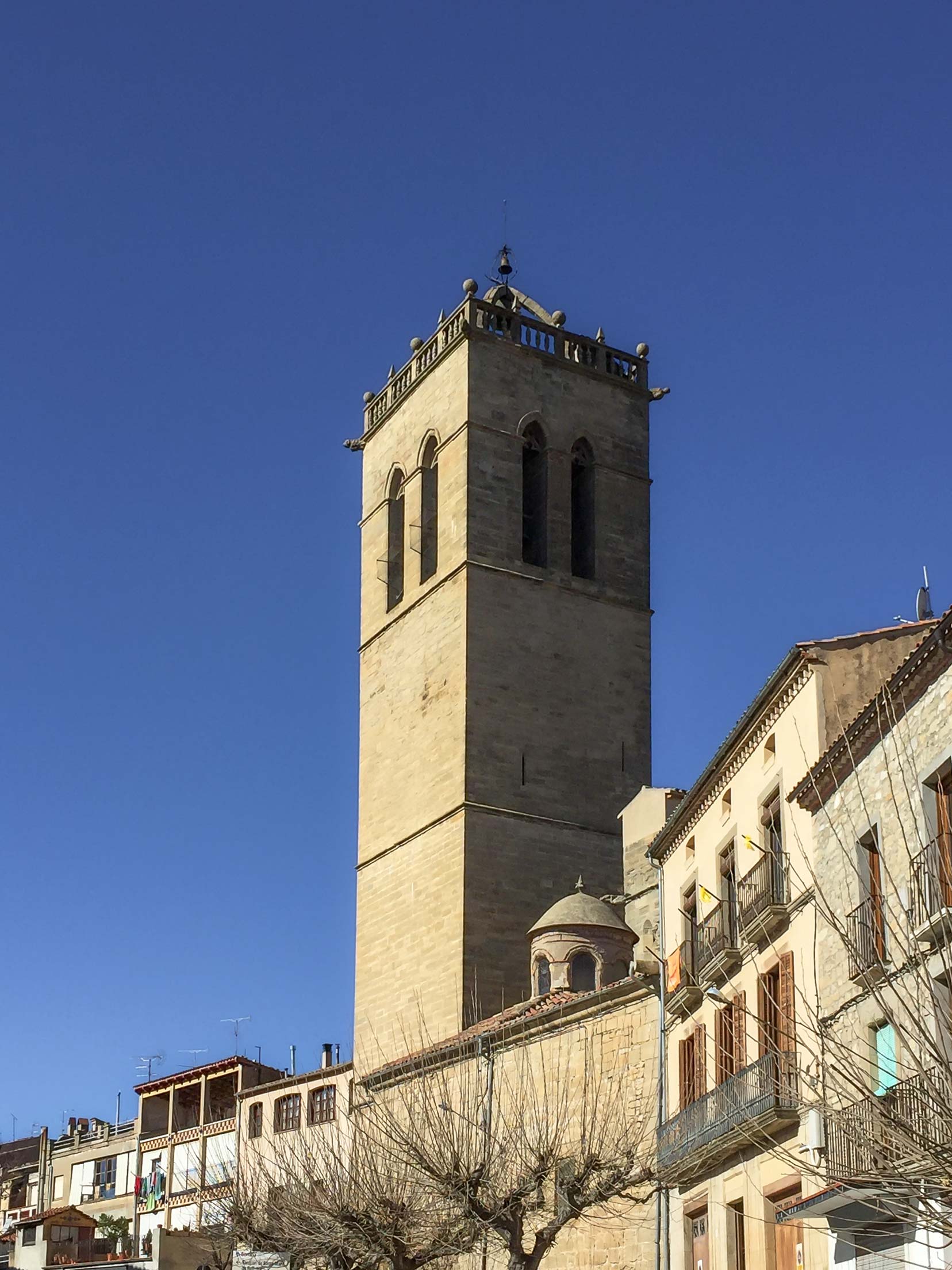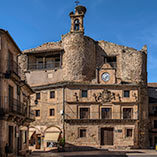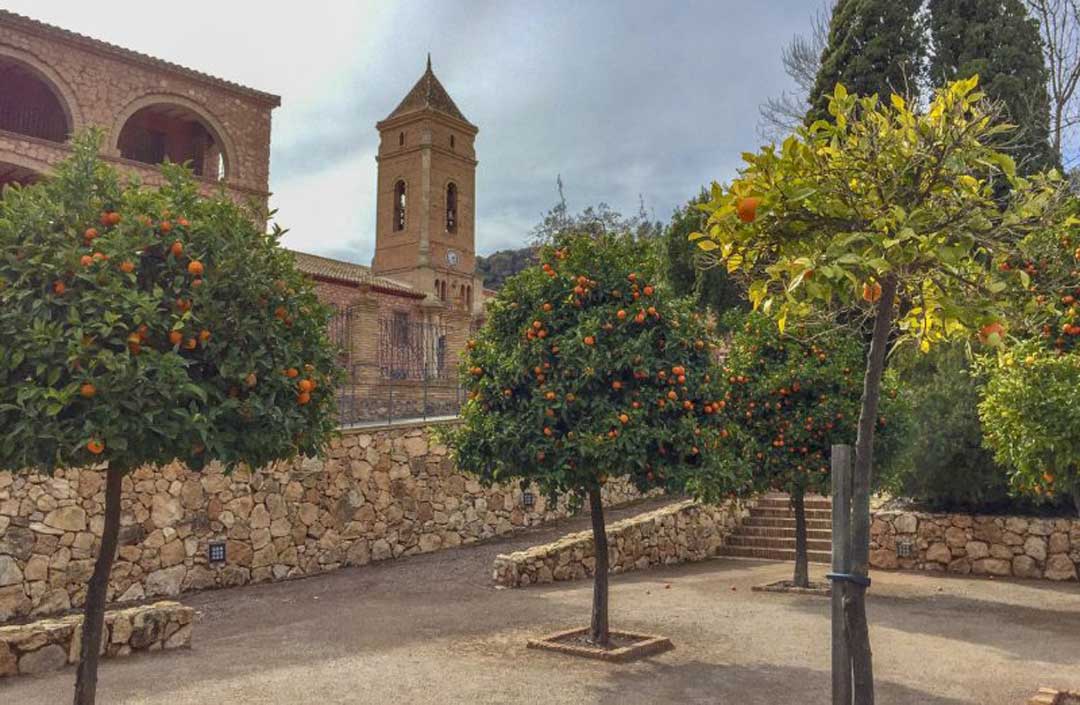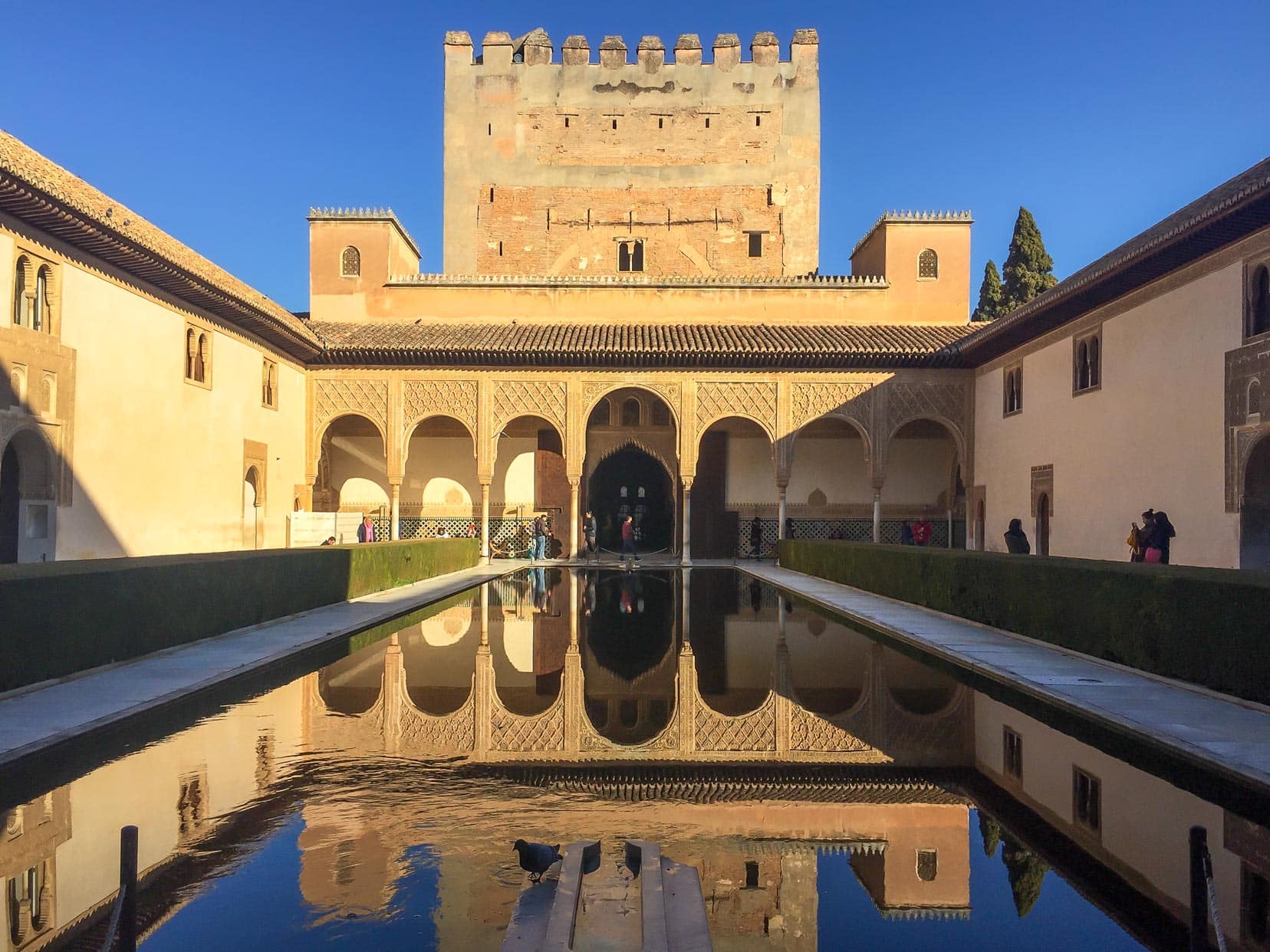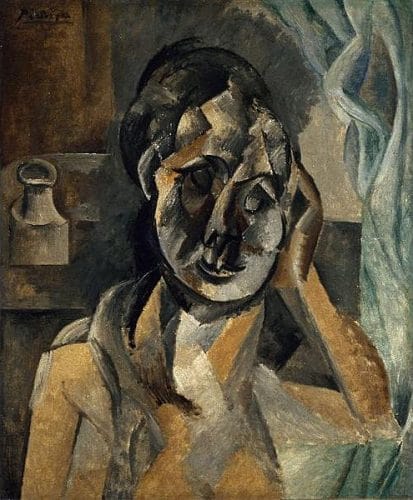Spain is synonymous with Flamenco music, siestas, paella and the iconic but controversial bullfighting. It is a land as diverse as the images conjured up by the very mention of its name.
Motorhoming in Spain offers a fantastic way to explore the country’s rich and colourful history. This article details various motorhoming routes to help you plan the perfect road trip itinerary across Spain.
We take you through snow-peaked mountains and medieval towns before heading south to the warmer climes of the historical Moorish region of Andalucia.
There, we explore some of Spain’s brightest jewels: Granada, Malaga, Seville, Cordoba, and Ronda—one of our favourite parts of our Europe road trip.
Our quintessential Spanish road trip began in the cosmopolitan city of Barcelona, where we arrived by ferry after concluding our motorhoming adventure in Italy.
Below are the key destinations we visited during our road trip in Spain, all of which are highly recommended for your itinerary:
Motorhoming In Spain: Overview of Amazing Places to Visit
Map: Motorhoming Spain
How to Use This Motorhome Route Map
- To use this interactive map effectively, click the square icon in the upper right corner to expand.
- A key will appear on the left, guiding you through various locations.
- Clicking on any site reveals detailed information about that spot.
- Each campervan stopover on the map links to the Camper Contact website. Here, you can explore available amenities, pricing, and operational hours and read reviews from other travellers.
- Look for motorhome overnight campsites in Spain marked by an orange circle (🟠) with a motorhome icon.
- The places we’ve personally visited are also highlighted with purple (🟣) location icons.
- Additional places you might want to visit are highlighted with a blue (🔵) marker.
Planning Your Trip: Campervan or Motorhoming in Spain
We’ve also created a FREE ROAD TRIP Travel Planner to help you navigate Spain. It features recommended places to visit and various route options for your journey.
This 23-page planner is fully customizable—print all the pages or just the ones you need. It’s available in three convenient sizes, and you can print additional copies of any page as required.
This tool is incredibly useful for planning your trip, offering journal pages to record all your travel details.
Whether touring Spain by car or campervan, you’ll find this resource invaluable.
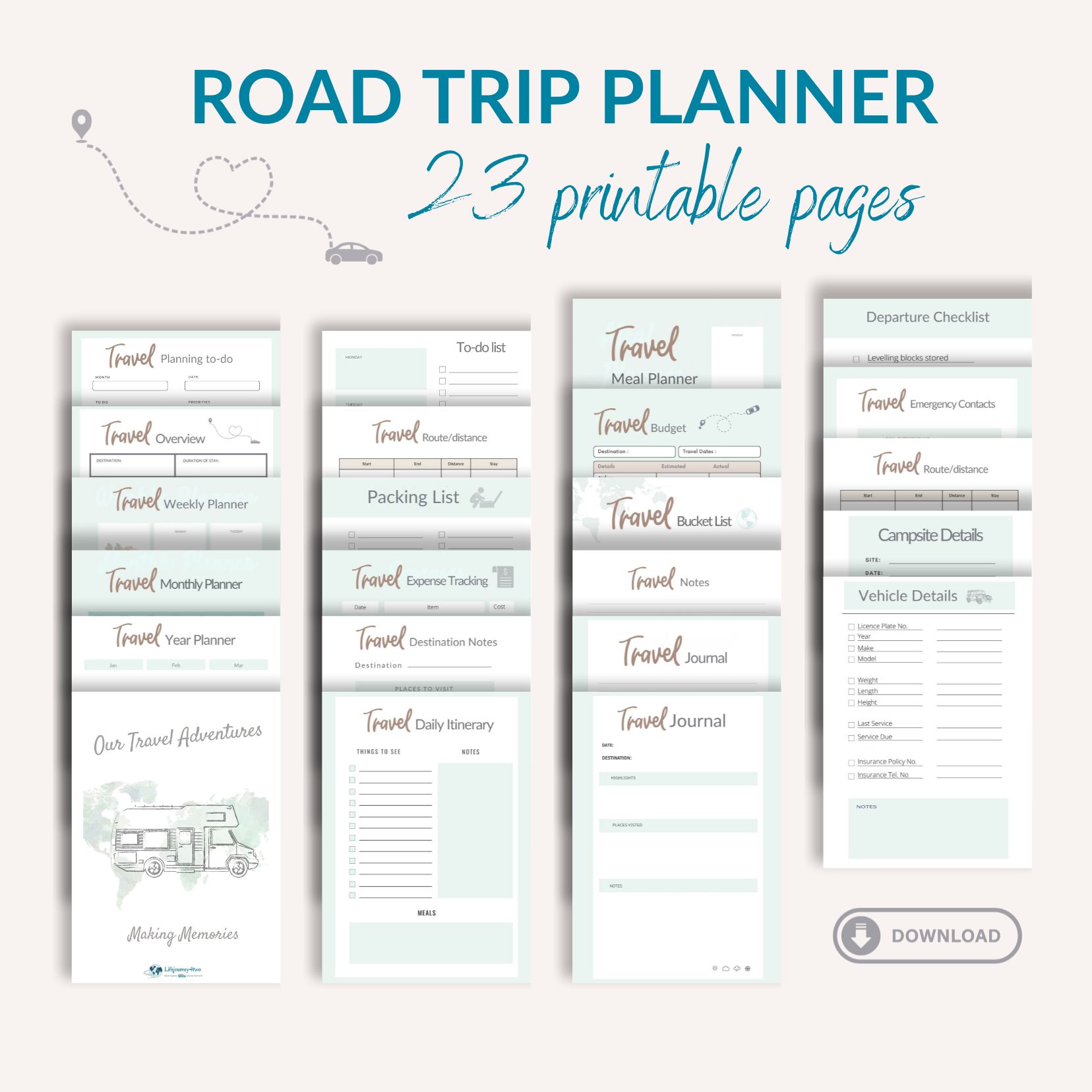
Need some ideas on planning your journey? We’ll get you going with our How to Plan a Road Trip article.
It covers everything you need to know, from selecting the best routes to packing essentials, ensuring you’re fully equipped for your adventure.
Spain Motorhome Route Options
Below are examples of route options for a road trip around Spain, designed to help you calculate the timing and distances for your journey.
The fourth option extends your motorhome adventure into Spain by including a drive through Portugal.
Each route starts in Barcelona, likely the most convenient arrival point.
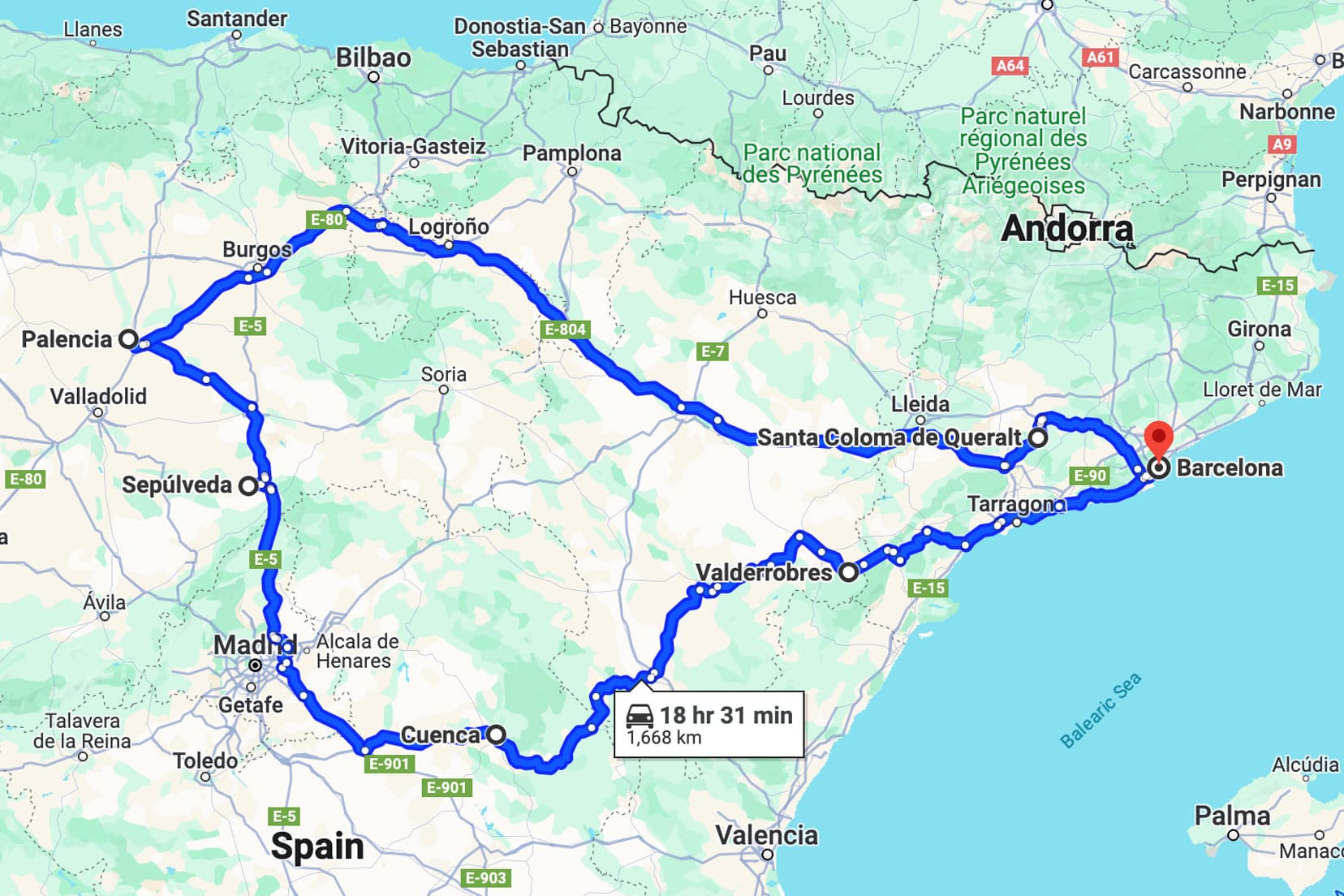
1. Northern Spain Road Trip
Distance: 1670 km
- Route: Barcelona → Valderrobres → Cuenca → Sepulveda → Palencia → Santa Coloma de Queralt → Barcelona
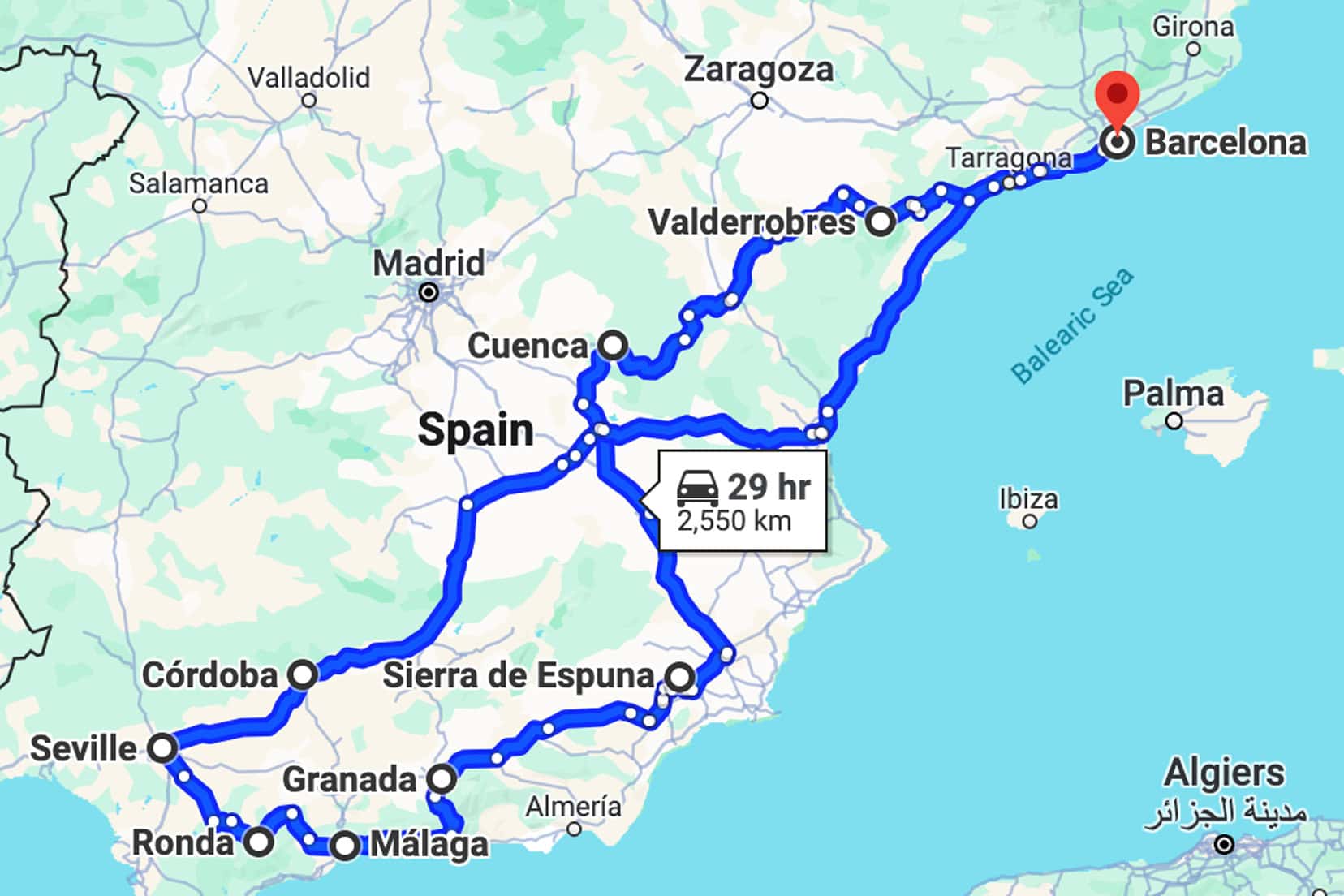
2. Eastern and Southern Spain Road Trip
Distance: 2550 km
- Route: Barcelona → Santa Coloma de Queralt → Valderrobres → Cuenca → Sierra Espuna → Granada → Malaga → Ronda → Seville → Cordoba → Barcelona
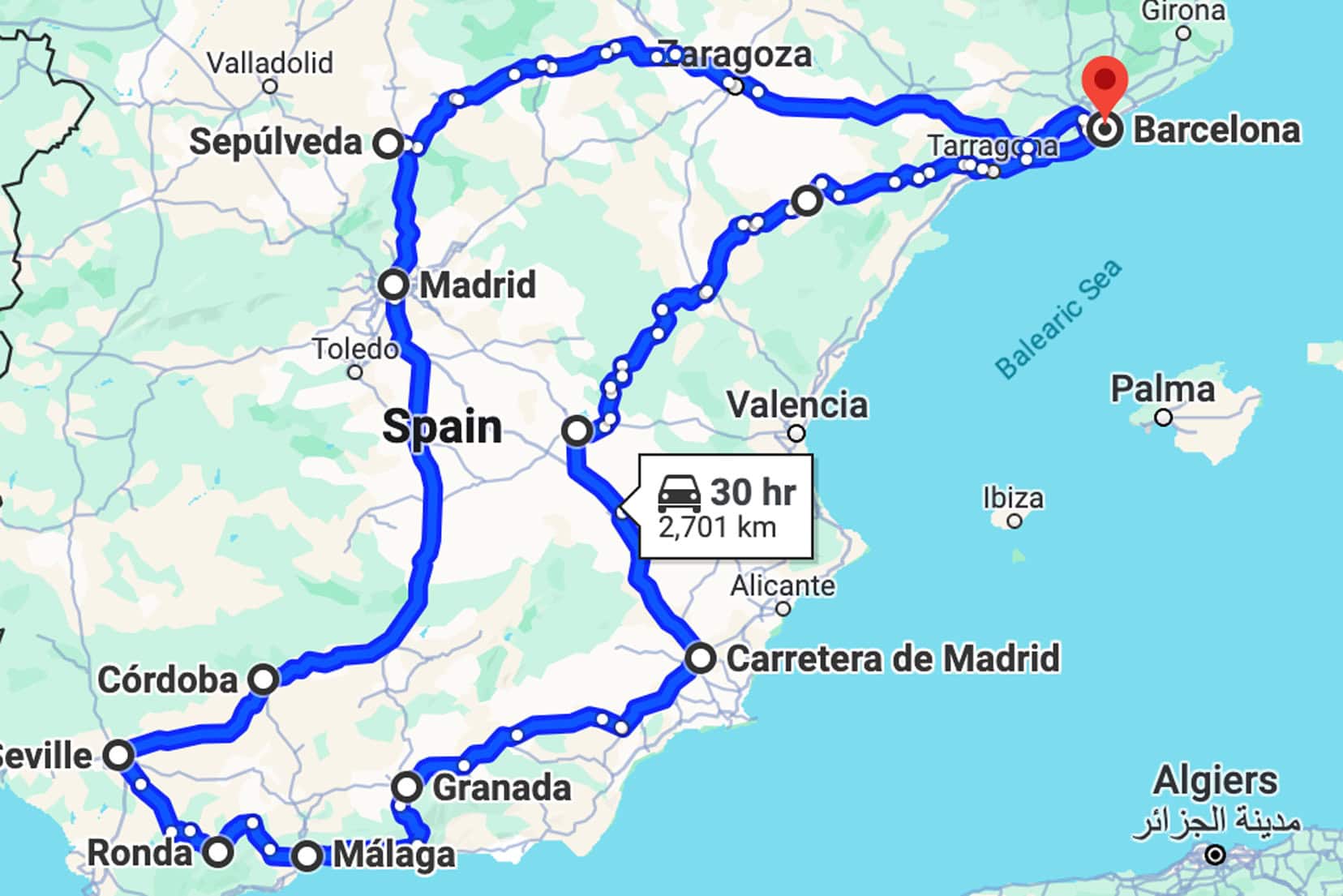
3. Northern and Southern Spain Circuit Road Trip
Distance: 2701 km
- Route: Barcelona → Valderrobres → Cuenca → Sierra Espuna → Granada → Malaga → Ronda → Seville → Cordoba → Madrid → Sepulveda → Palencia → Santa Coloma de Queralt → Barcelona
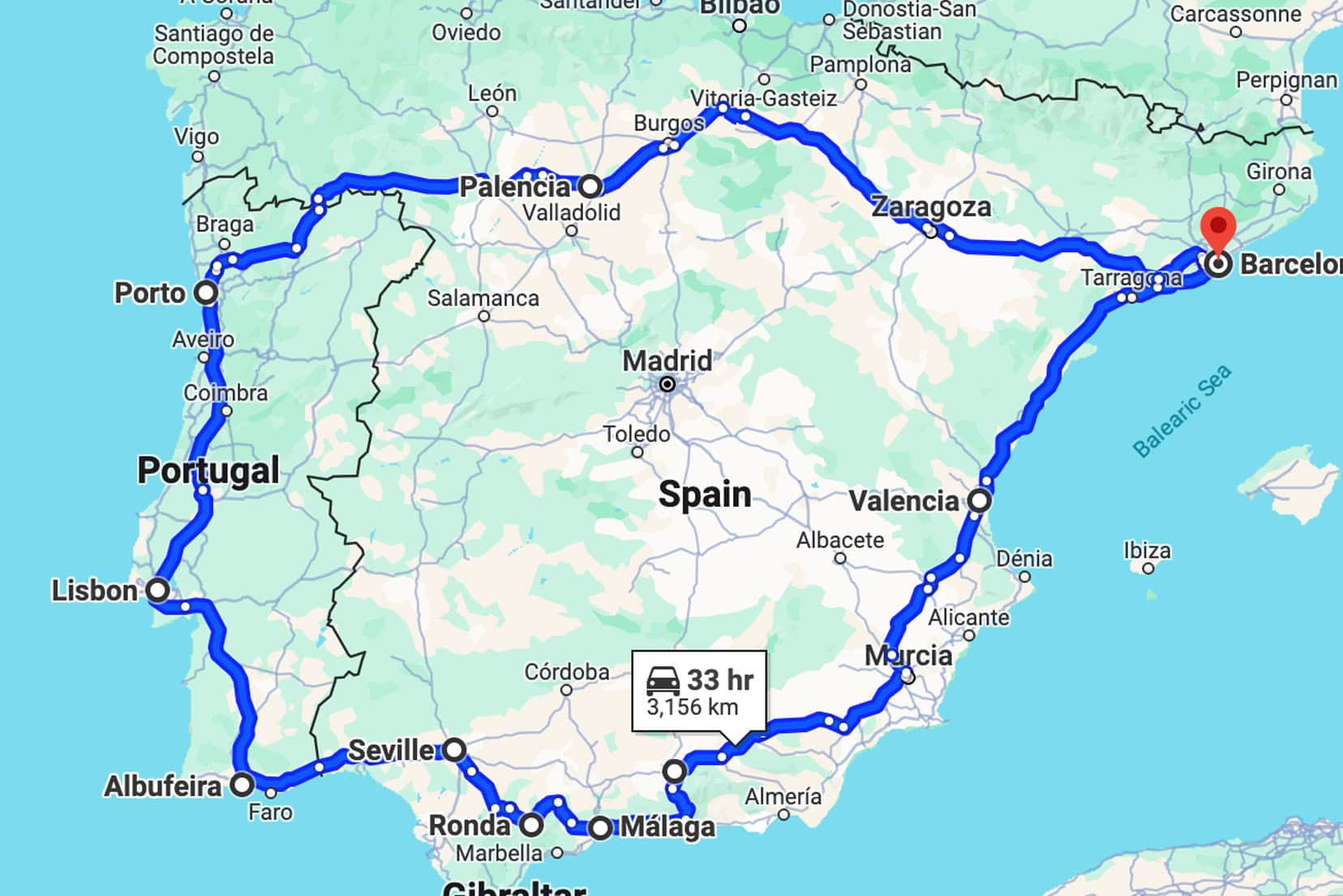
4. Portugal and Spain Road Trip
Distance: 3160 km
- Route: Barcelona > Valencia > Sierra Espuna > Granada > Malaga > Ronda > Seville > Portugal > Palencia > Santa Coloma de Queralt > Barcelona
Planning a Trip to Spain?
- 🚗 Hiring a car? We recommend getting a quote from DiscoverCars
- 🚐 Hiring a campervan? We recommend Motorhome Republic
- ⛑ Arranged your travel insurance? Compare quotes from World Nomads & Safetywing
- 🪪 Order your International Driver’s Licence online here
- 🏩 Booked your accommodation? We use Booking.com to find the best deals
- 🐾 Is someone pet-sitting for you? 🐾 We use and love TrustedHousesitters
- (Get 25% off at checkout for new memberships with our discount code: LIFEJOURNEY25)
- 🛜 Internet and SIM Card: If you are travelling from the UK – many motorhomers travelling in Spain recommend using Lobster
Motorhoming in Spain – Campsites and Rentals
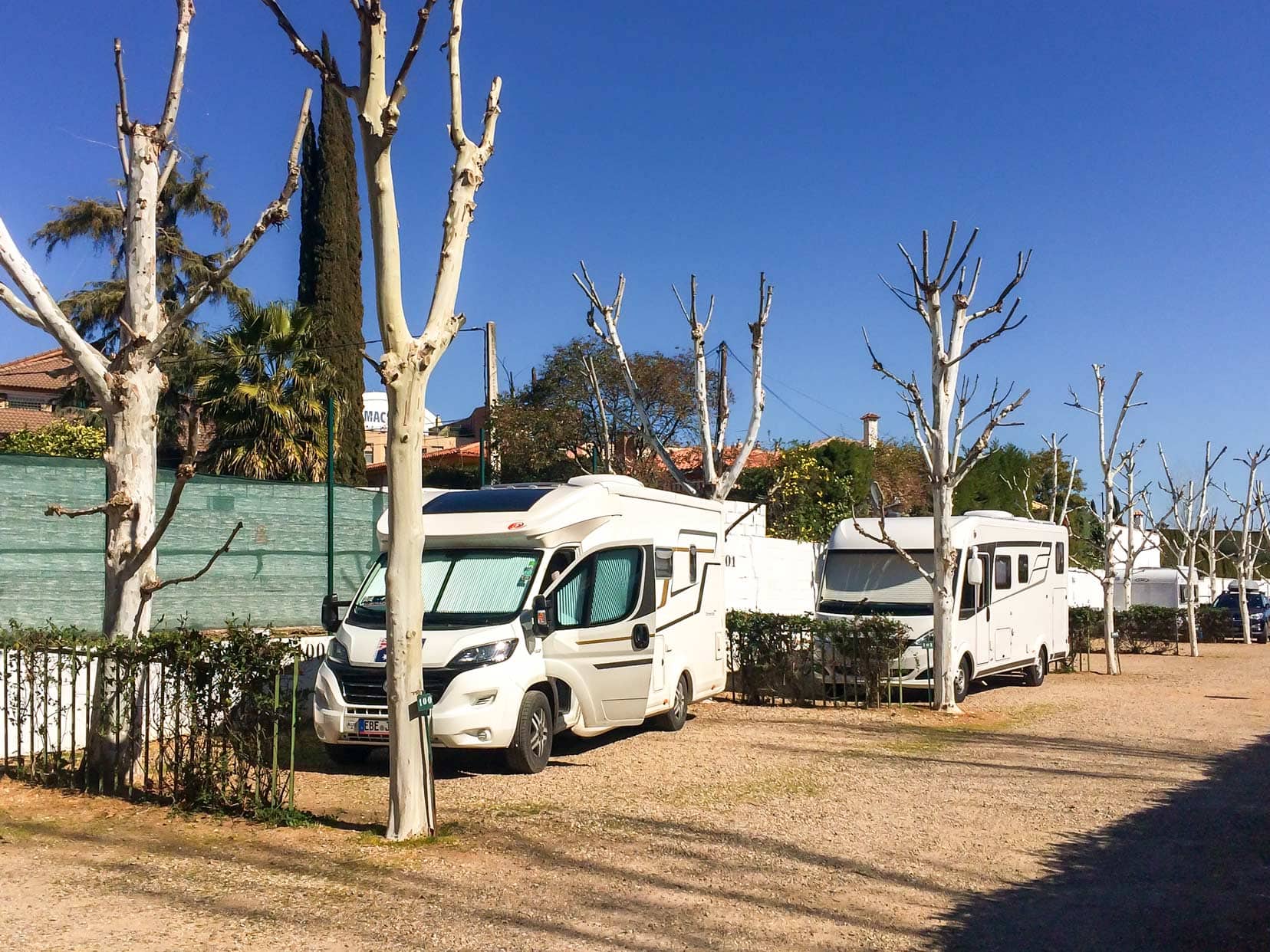
We were in a motorhome travelling through Spain, a fantastic way to see the country. For each overnight, we’ve included a motorhome stop link and additionally on the interactive map above.
These road trip routes are just as suitable for car travel; however, you’ll need to book accommodation along the way. We plan our routes to avoid the toll roads in Spain as much as possible.
New To Motorhoming? Our Beginner MOTORHOME TIPS will get you going.
Where To Overnight With Your Motorhome in Spain
We used the Camper Contact app (about 16 euros/year, including access to site reviews) to find our overnight motorhome stops when travelling through Spain. The app lists over 2000 campervan parking and motorhome services in Spain.
Another popular choice for motorhomers is the Park4Night app.
Can You Wild Camp in Spain?
Well, the waters are murky on this one.
Wild camping is not generally allowed in Spain; you should use a campsite. However, under certain conditions, you may overnight somewhere that is not a recognised campsite.
What are these certain conditions?
You are allowed to park in a designated parking place and sleep overnight as long as it isn’t obvious that you are doing so. This means:
- ❌ don’t pull out your motorhome awning
- ❌ no barbeques
- ❌ don’t hang washing out
- ❌ no setting up of deck chairs or tables
- ❌ no generators
- ❌ no undue noise
I’m sure you get the idea, but remember that although some car parks may be free motorhome stops, they can be particularly noisy. However, a word of warning:
Each region of Spain applies its own rules for wild camping and local conditions, such as the length of stay. The best way to confirm the requirements is with the local municipality.
❗️One clear rule: wild camping in Spain is strictly prohibited in all the country’s National Parks.
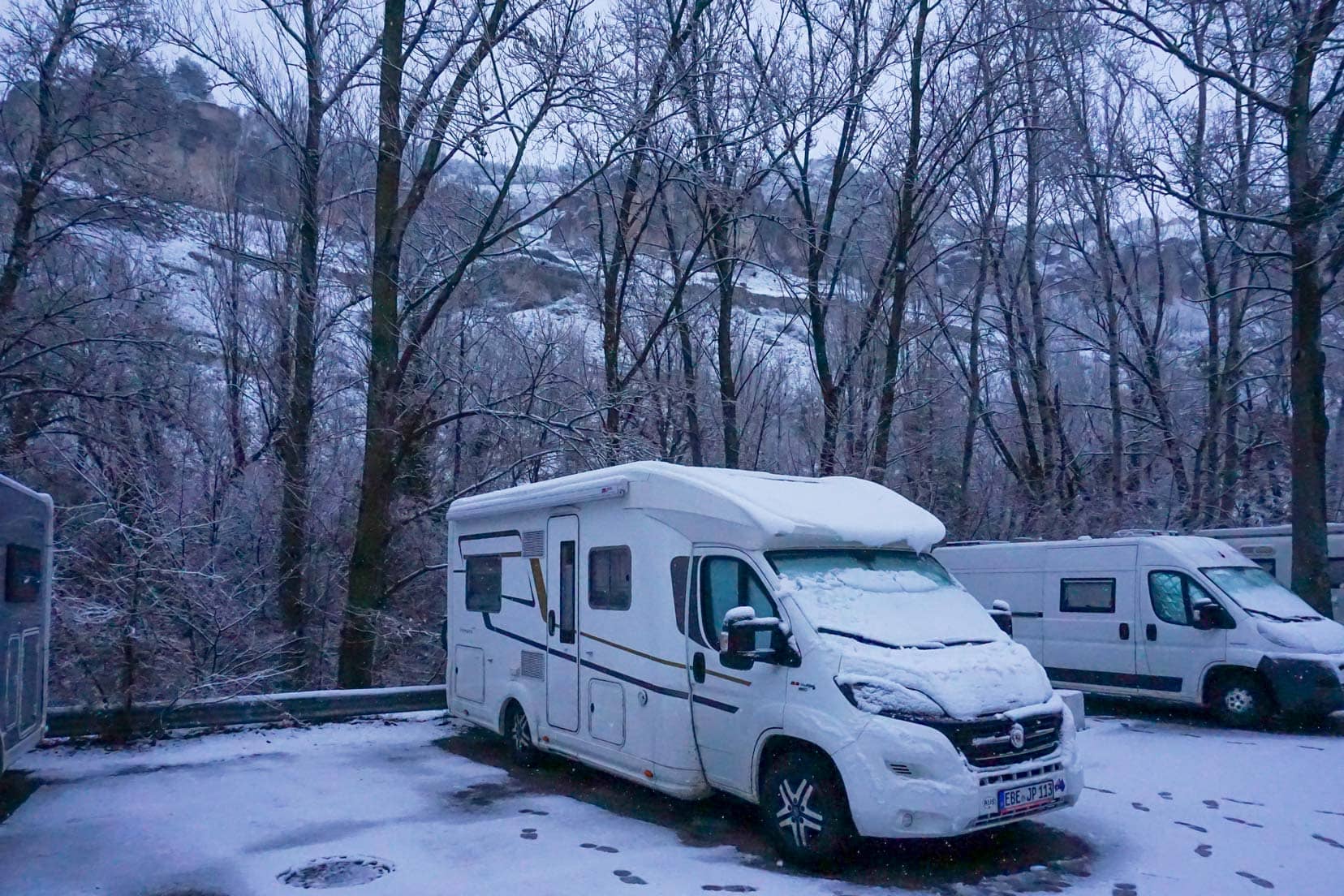
Motorhome Rental in Spain
We recommend Motorhome Republic for motorhome rentals. They can find the best deals for you, with various pick-up points across different countries.
They will make your dream of touring Spain in a motorhome a reality.
Our experience with them was incredibly positive; we found it more economical than dealing directly with rental companies.
💥 Looking to HIRE a motorhome or camper? We used, and highly recommend, Motorhome Republic — they have an EXCELLENT rating on Trustpilot, and their customer service was amazing.
For more insights on road trips, campervan hire, and why we chose a campervan for our travels in Europe, check out our articles on Campervanning in Europe and Road Trips Around the World.
Spain Road Trip by Car
Although we motorhomed through Spain, this post is just as suitable for road-tripping Spain by car.
If you need to hire a car, check out and try Discover Cars. They won the World Travel Awards for World’s Leading Car Rental Booking Website in 2020, offer free cancellation and score 4.5/5 on Trustpilot.
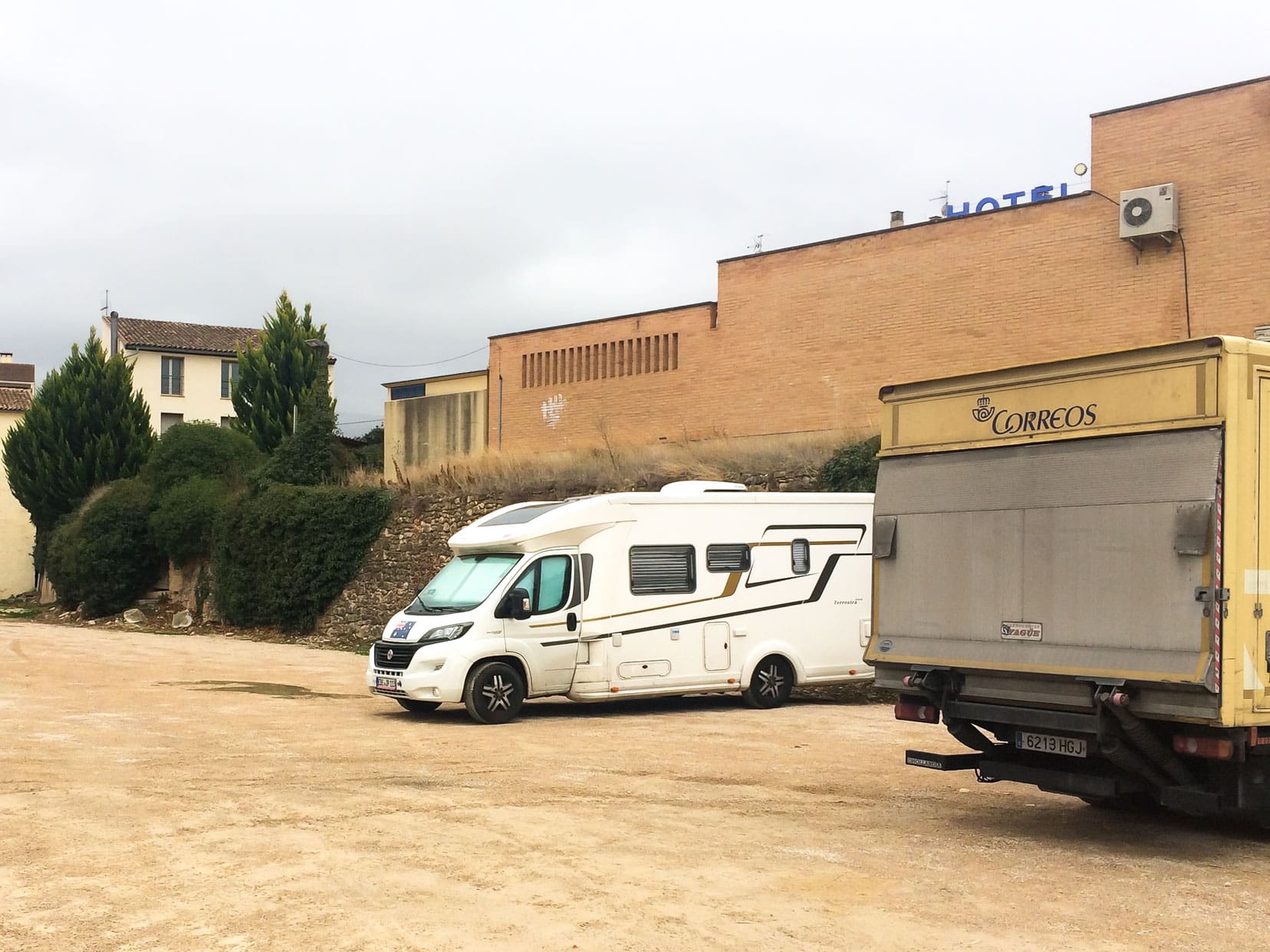
Places To Visit On Your Spain Motorhome Road Trip
These best places to visit in Spain include both well-known Spanish towns and those a little more off the beaten path, so you have a mix of options for your road trip itinerary.
This allows you to refine your road trip plans with a comprehensive mix of destinations.
1. Barcelona
🚐 Motorhome Campsite: Barcelona Campsite
Barcelona, founded in the 1st century BC, is celebrated for its art and architecture, making it an ideal starting point for your Spain road trip—especially during the off-season.
Situated in Catalonia, an autonomous region in northeast Spain, the city boasts a comprehensive public transport system that includes metro, bus, and tram services.
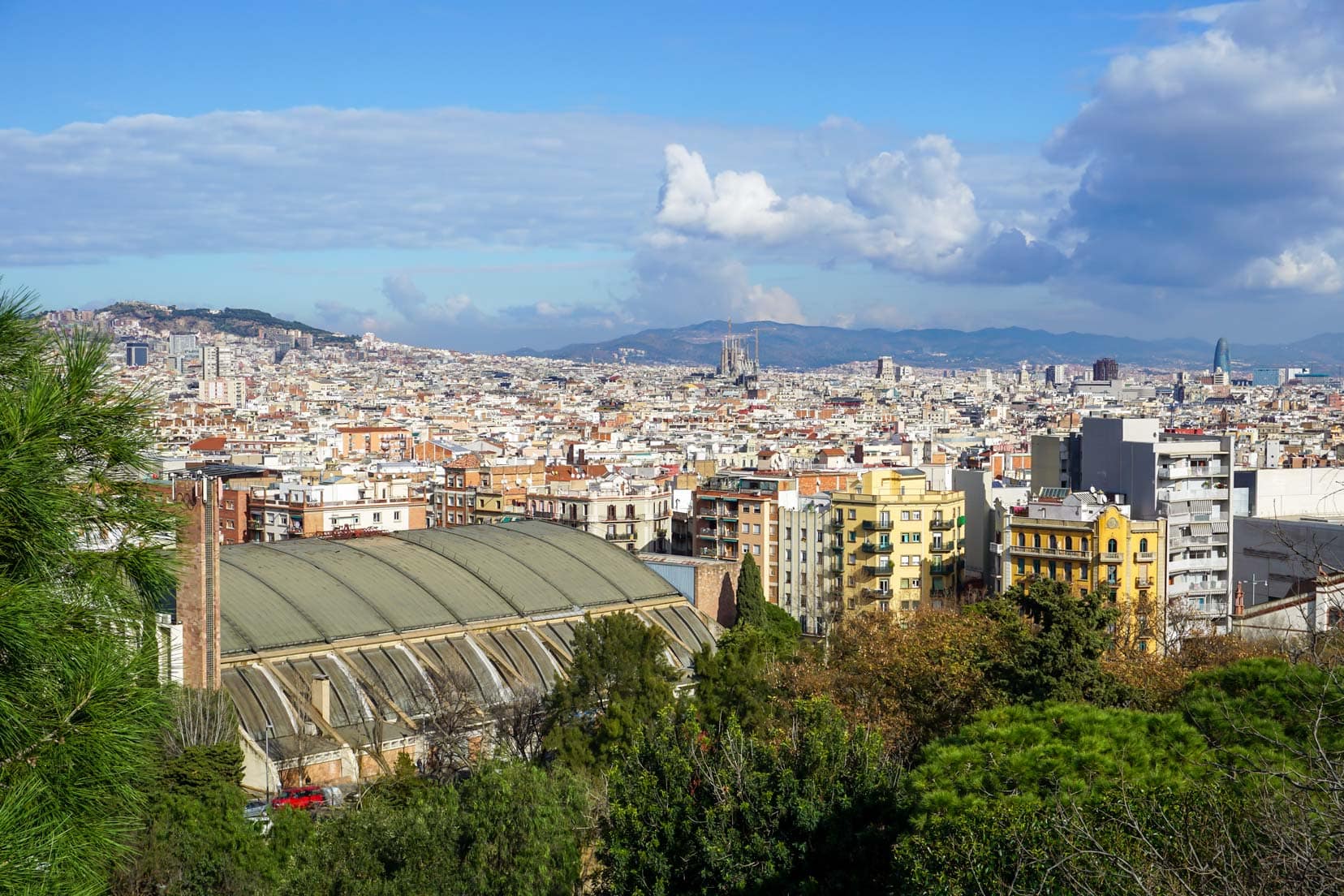
As one of Spain’s most popular tourist destinations, Barcelona faces significant challenges with overtourism. Barcelona’s tourist tax varies depending on the type of visitor accommodation used.
This tax is applied per day up to a maximum of 7 days and levied only on official tourist lodging.
To help alleviate pressure on the city, consider visiting in the shoulder months of September and May, and aim for mid-week stays to dodge the heaviest crowds.
Extra Travel Tips For Barcelona
- The Metro and Tram city lines can be found here.
- For bus city networks, click here.
- A good central location to start the day sightseeing is the underground central interchange Plaça d’Espanya.
- If you spend more than one day in the city, consider purchasing the Barcelona card.
This Barcelona Card is a 3-in-1 transport card, museum pass, and discount card that gives free public transport, free entry to 25 museums and attractions, and 70+ deals and discounts.
Barcelona’s Attractions

Montjuic
Montjuic is a significant cultural and historical area in Barcelona, located on a prominent hill overlooking the harbour. It provides a picturesque setting for the city and features a variety of attractions.
Here are a few key highlights you shouldn’t miss:
- Four Columns: As you approach the National Palace of Montjuic, you’ll pass the Four Columns, representing the four red stripes on the Catalan flag.
- Magic Fountain of Montjuic: This captivating musical water show, complete with lights, is located just in front of the Four Columns.
- Les Cascades: Experience the cascading waterways on the stairs, created for the 1992 Olympic Games.
- National Palace of Montjuic: Perched on Montjuic Hill, this majestic building houses the National Museum of Art of Catalonia and offers stunning views over Barcelona.
- Barcelona Olympic Park: Just behind the National Palace, this park hosted numerous events during the 1992 Olympic Games.
- Fountain Steps: Off to the side of Les Cascades, these steps are adorned with beautiful decorative tiles and overflowing sculptures.
- Montjuic Castle: At the summit of Montjuic Hill, the castle provides breathtaking panoramic views of Barcelona.
Montjuic is not just a treasure trove of arts and historical sites; it’s also a peaceful refuge from the bustling city below.
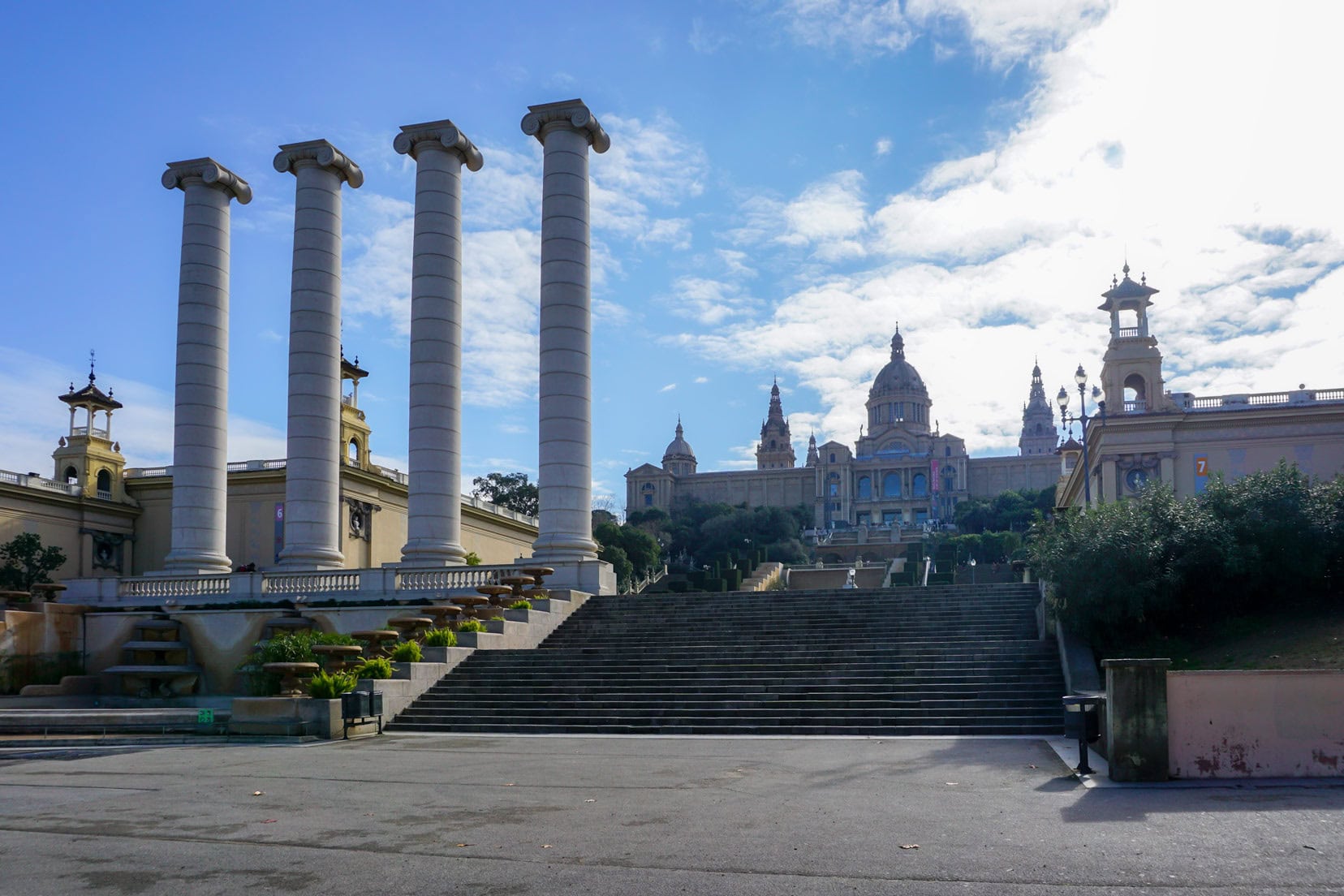
La Rambla
La Rambla is where all the action is.
This promenade is over a kilometre long and connects the centre of Barcelona to the old port. It runs between two streets with pedestrian-only access, leaving plenty of room for street markets, artists, food stalls and street performers.
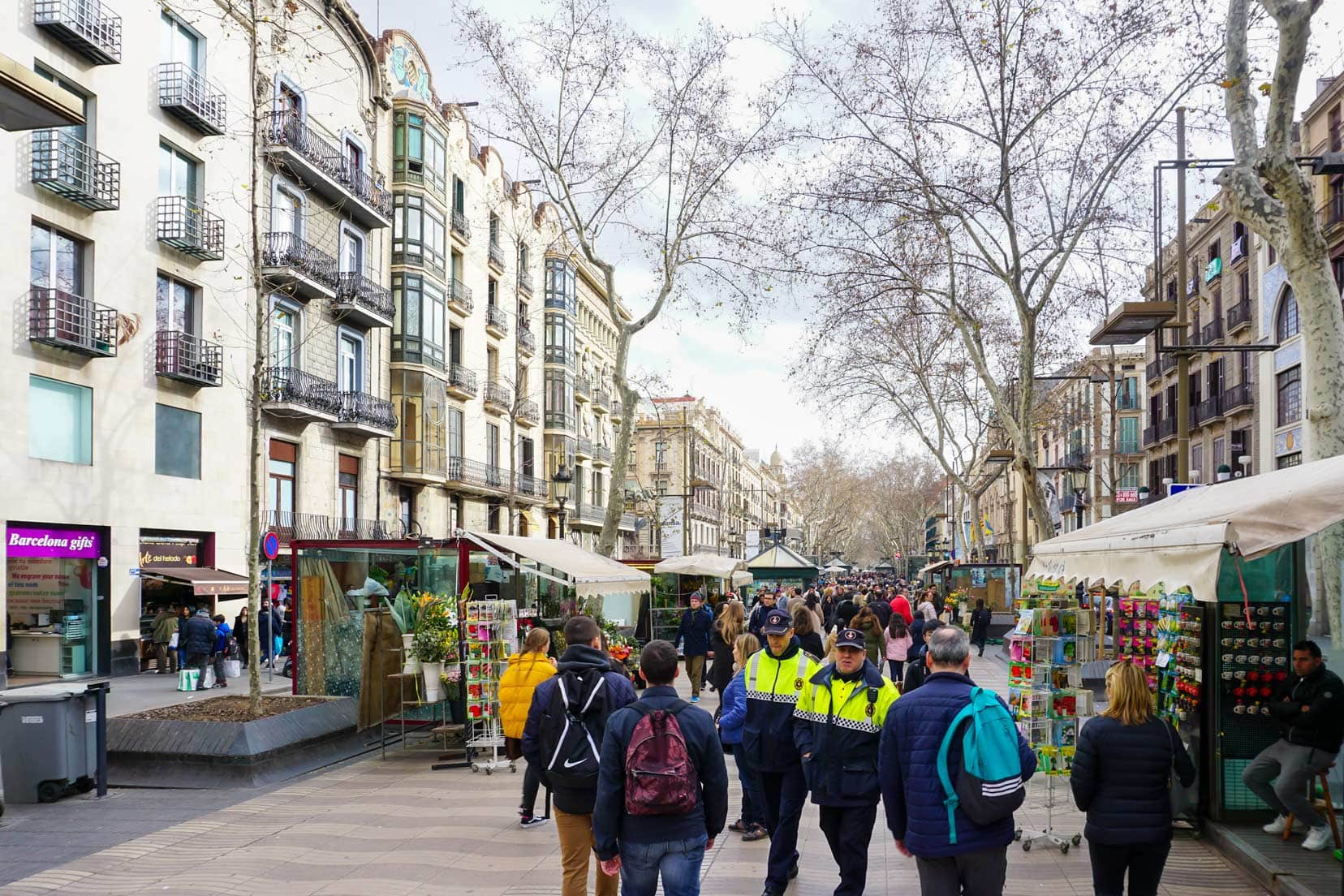
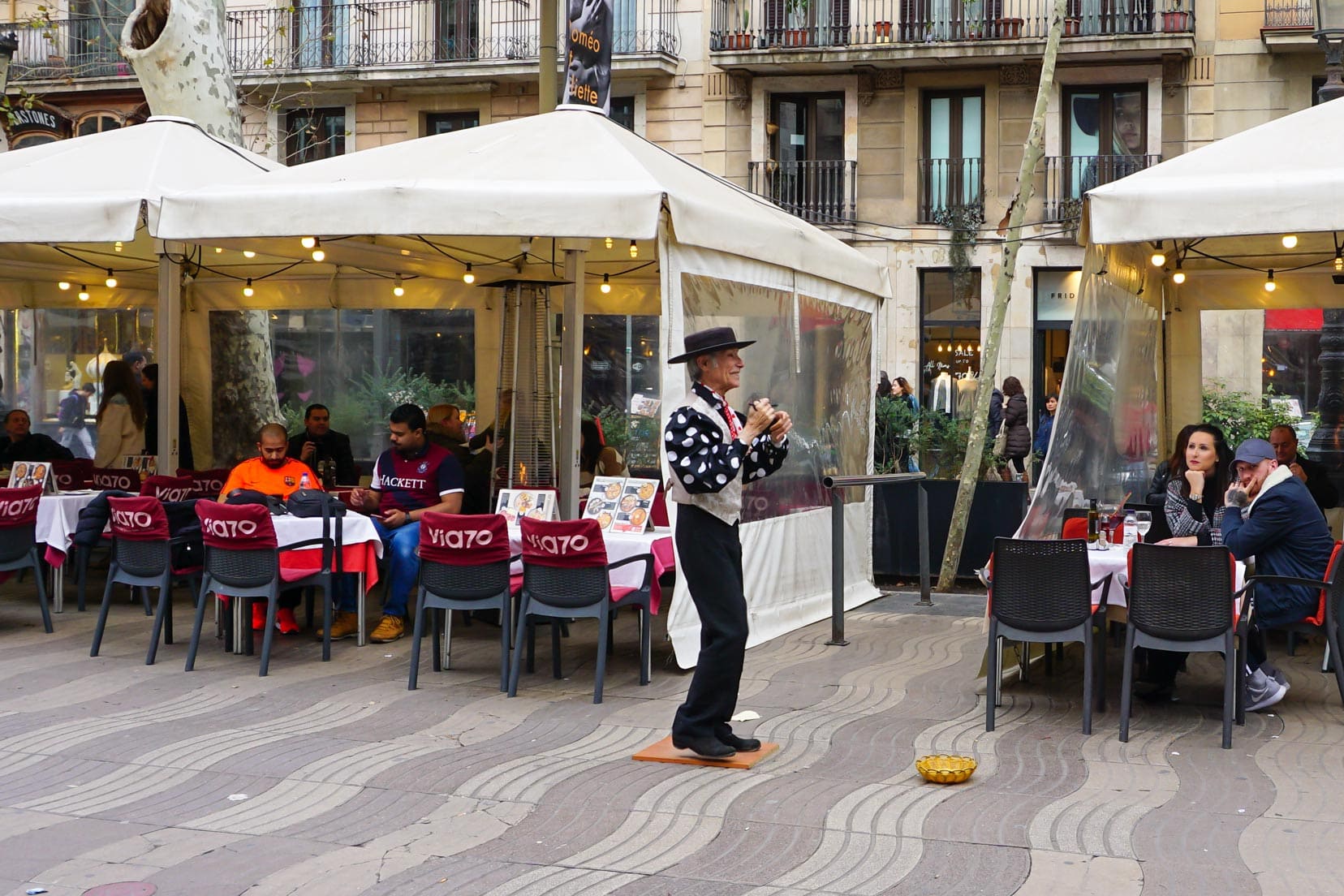
Located on La Rambla, Mercat de Sant Josep—La Boqueria is a fantastic marketplace. This packed market has stalls with all sorts of edible delicacies: fruit and fruit drinks, seafood, sushi, a myriad array of sweets, and delicious treats of all kinds.
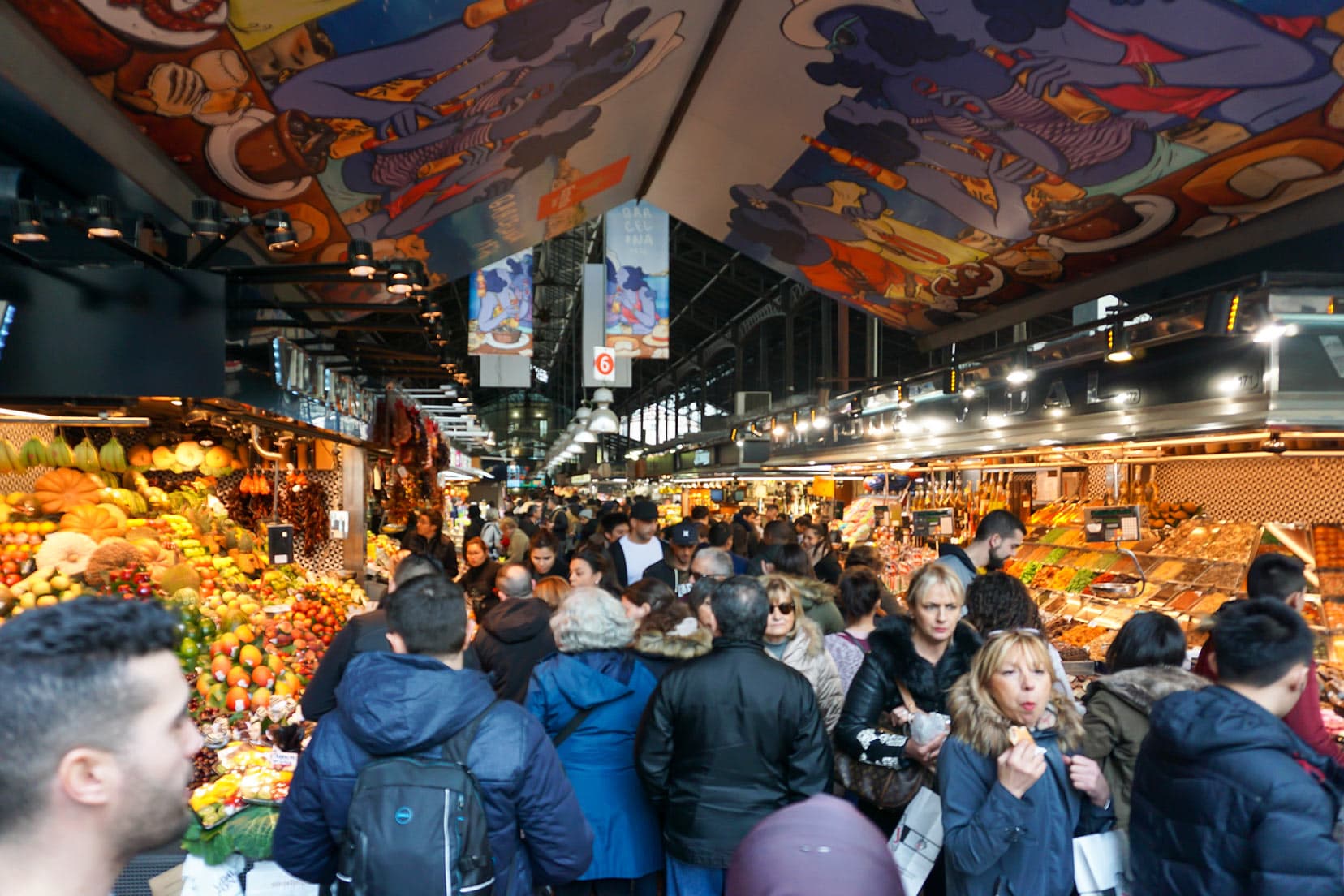
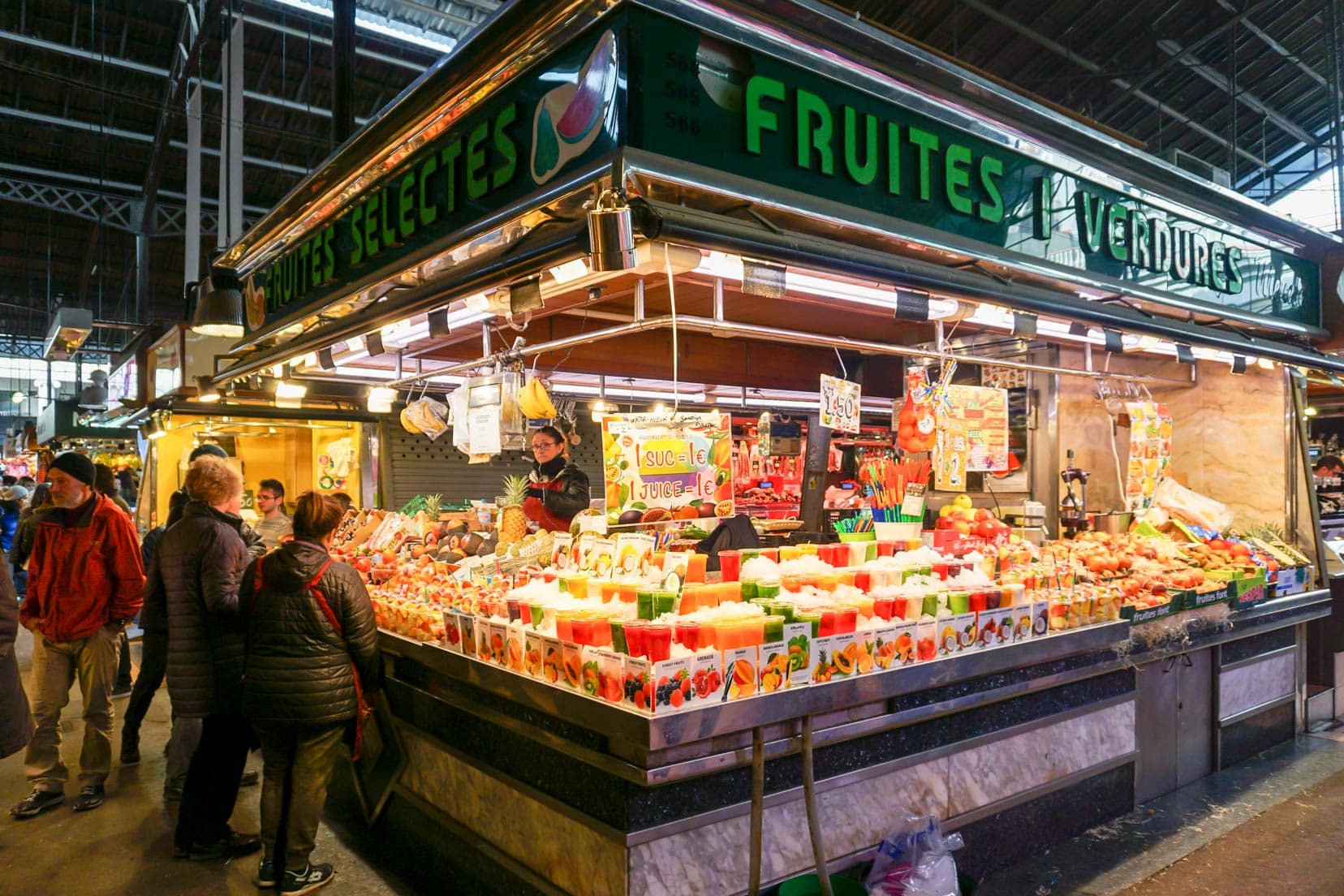
It’s the ideal place to buy fresh fruit and vegetables and maybe try your hand at making some classic Spanish food — such as berenjenas rellenas (stuffed eggplant).
Christopher Colombus Monument
The Christopher Columbus Monument is a striking 60m tall statue located at the lower end of La Rambla, near the waterfront in Barcelona.
It was built in 1888 to honour his trip to the Americas and serves as a reminder of Spain’s maritime history and Columbus’s exploration.
Visitors can take an elevator to the viewing platform at the top, which offers panoramic views of the city and the sea.
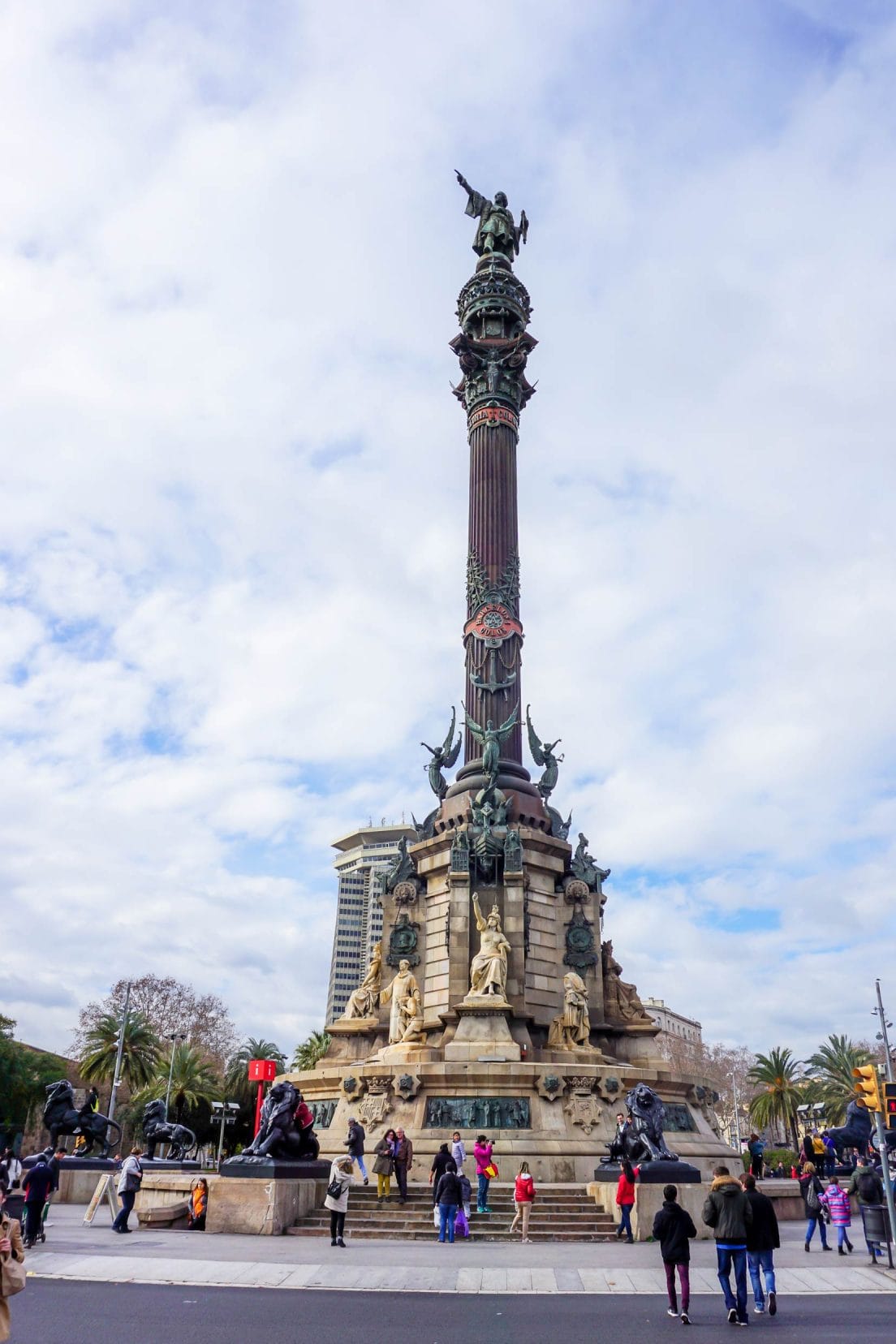
Gaudi’s Barcelona
Just off the La Rambla promenade, you’ll find Casa Batlló, built between 1904 and 1906 by designer Antoni Gaudi. He was a Spanish architect and leader of Catalan Modernism and is believed to have gained his inspiration from forms within nature.
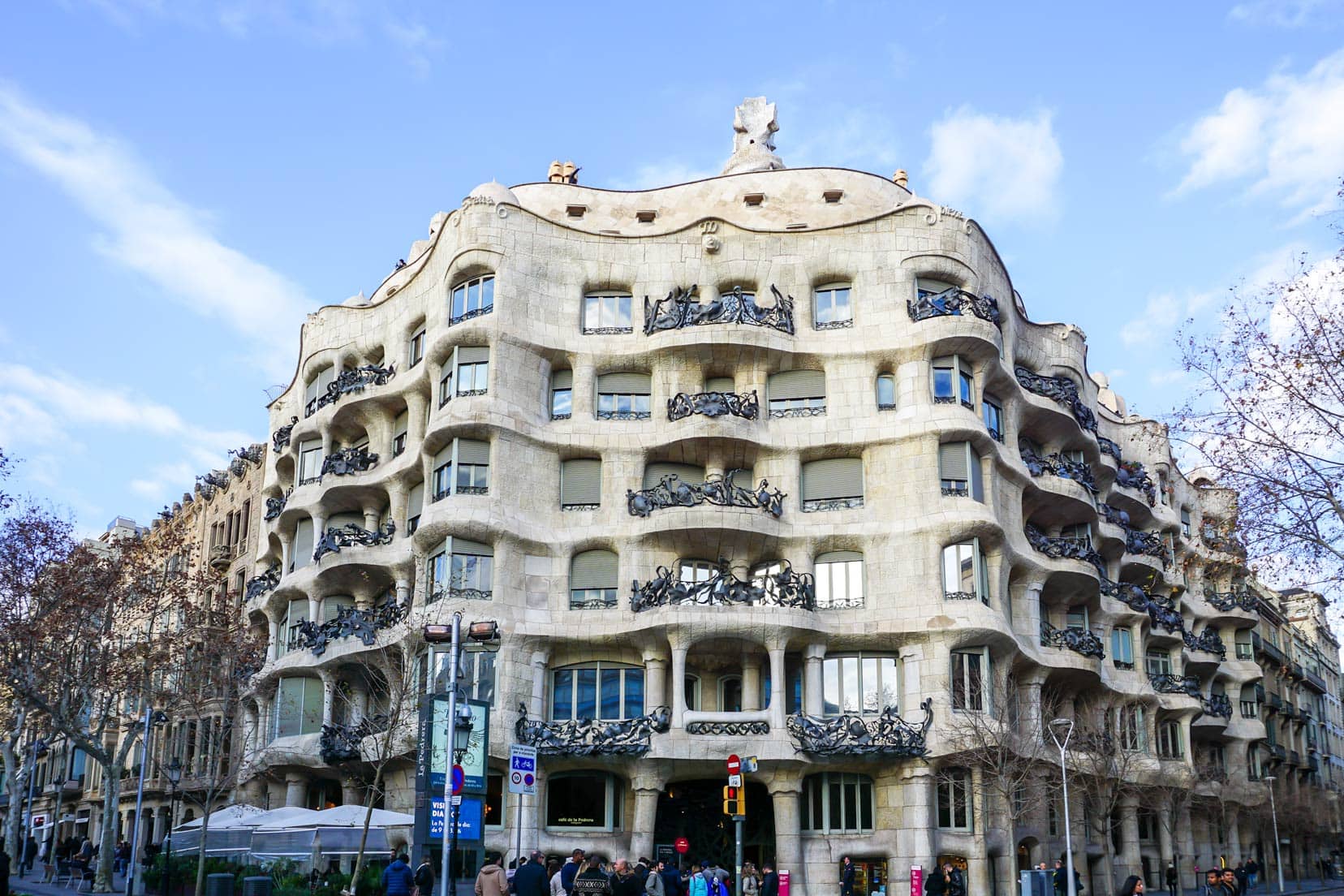

Only four streets away, we spied another of Antoni Gaudi’s modernistic works of art, Casa Mila. Built between 1906 and 1910, it is much less colourful than Casa Batlló but still reflects that distinctive Gaudi styling.
Sagrada Familia
Probably the most famous of Gaudi’s designs is the Sagrada Familia Church, of which Antoni Gaudi was the chief architect.
This remains the largest, unfinished Roman Catholic church in the world.
Gaudi worked on this project until his death, in 1926. At that time, only one-quarter of the build was complete.
The final completion date is predicted to be 2030.
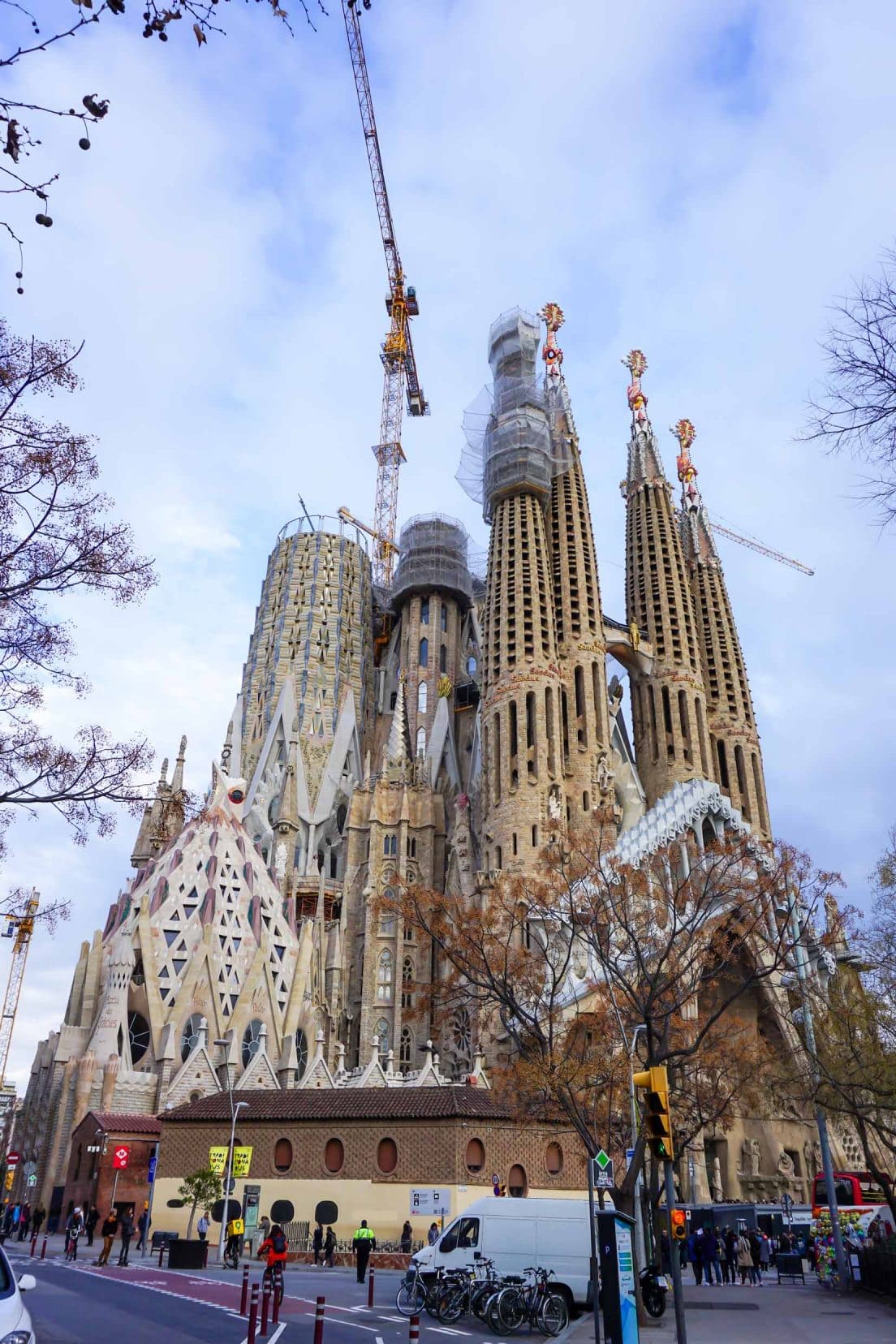
Barcelona’s Parks
Barcelona has some beautiful parks to discover. One of the most popular is Park Guell, which Gaudí was assigned to design in 1900.
It covers 17 hectares and has been a UNESCO World Heritage Site since 1984.
In fact, if you want to avoid the crowds altogether, take a virtual tour right now of the Park Guell website.
Parc de la Ciutadella is another gorgeous park you should add to your itinerary. It has a magnificent fountain and exquisite statues within a lake.
If you’re searching for family fun, then consider a visit to Barcelona’s zoo which is located in the same park.
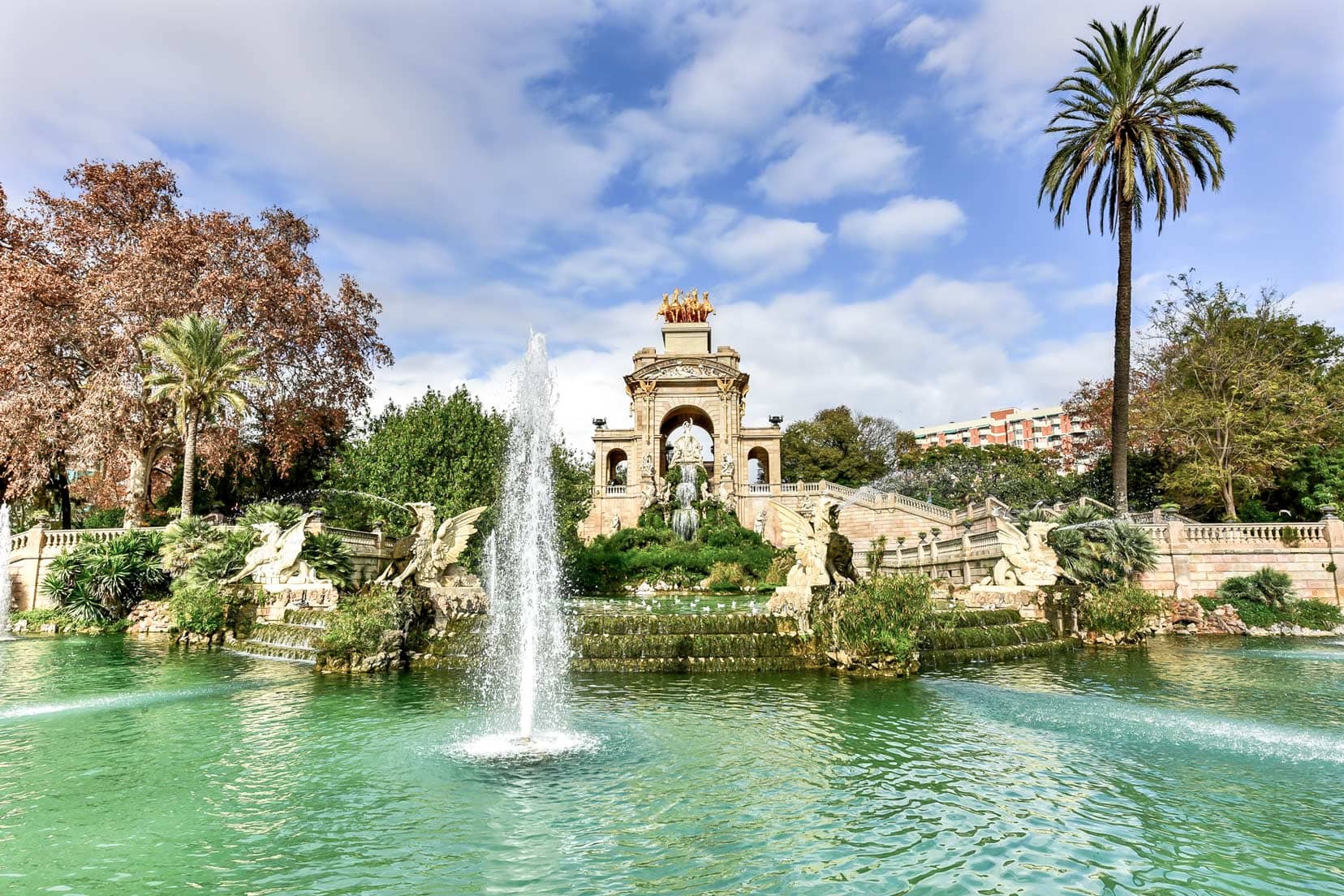
Barcelona Accommodation and Motorhome Campsite
- Motorhome Campsite: Barcelona Campsite
- Hotels and B&Bs: Find Barcelona deals on Booking.com
2. Santa Coloma De Queralt
🚐 Motorhome Campsite: Santa Coloma de Queralt
📏 Distance: Barcelona to Santa Coloma De Queralt = 100 km
Santa Coloma de Queralt is a town off the normal tourist-ridden beaten path of Spain, and is well worth a visit.
The old town has four medieval gateways, the Palace of the Counts of Queralt and Santa Coloma, a 14th-century Gothic church.
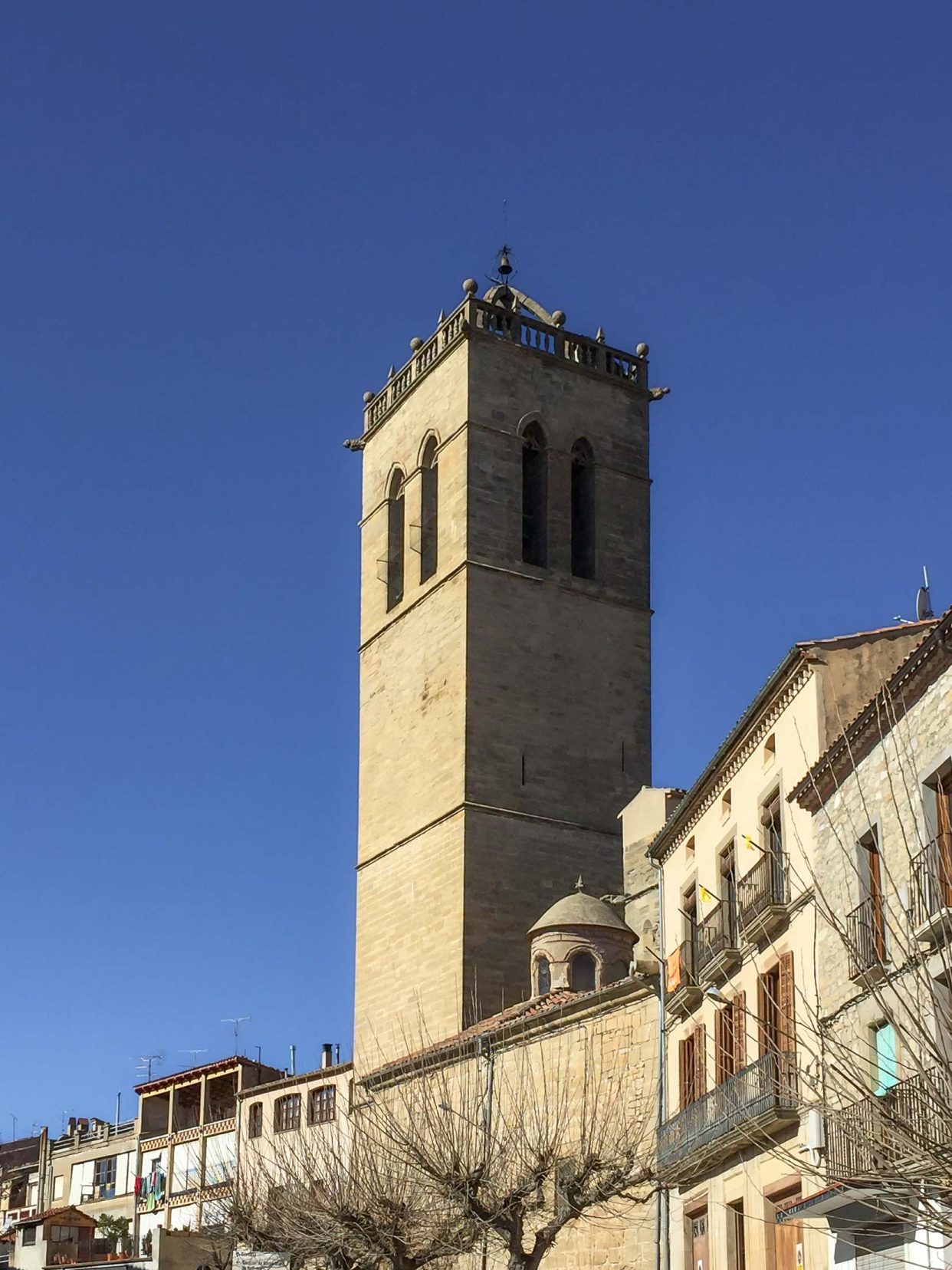
This was the first town where we became intrigued by the many yellow ribbons tied around statues, windows, fences and trees. Perplexed, we asked one of the locals.
In Catalonia, the yellow ribbon symbolises support for the region’s independence from Spanish governance.
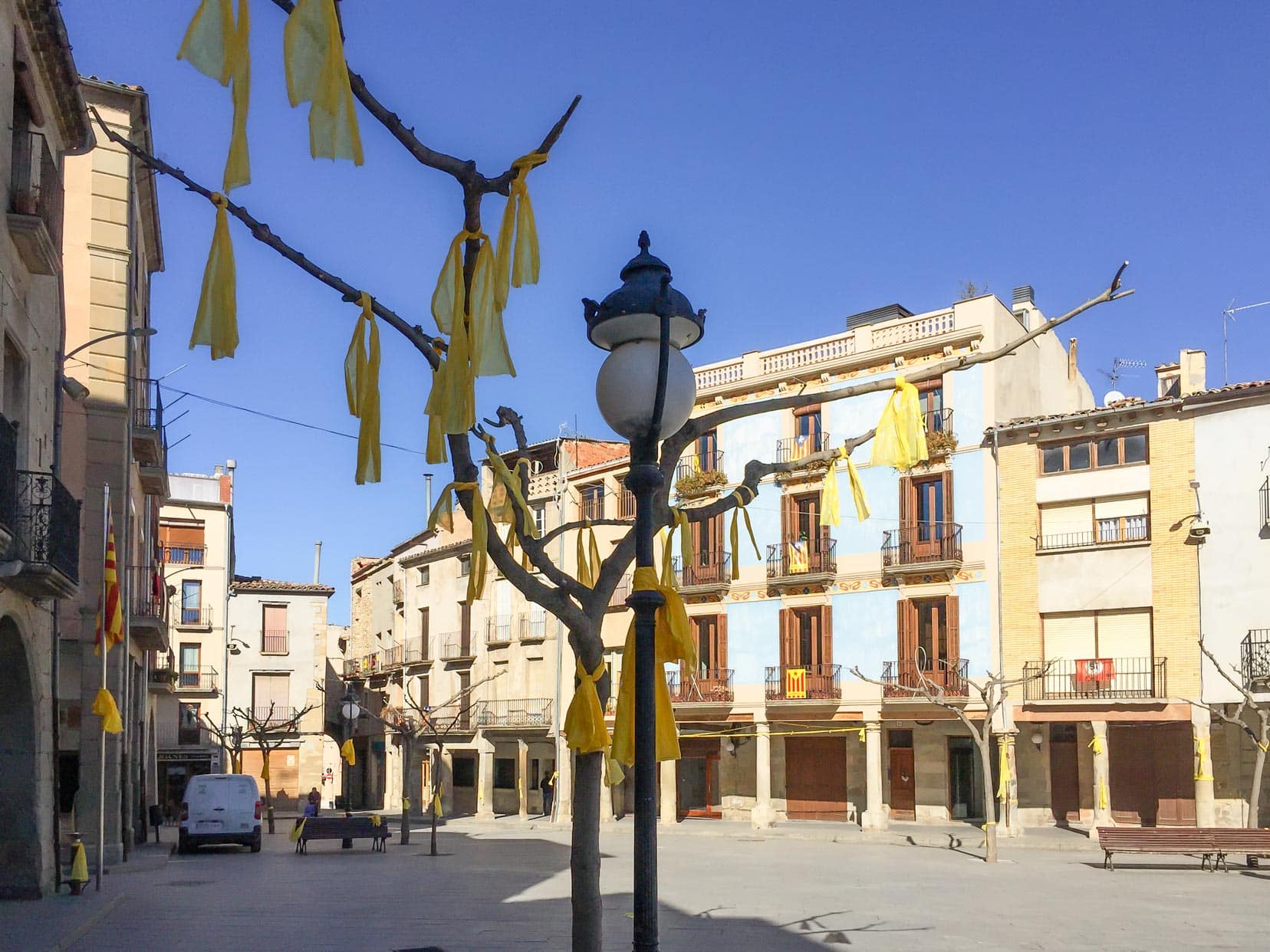
The town is small and without Barcelona’s hordes of tourists, gives you the chance to catch your breath and absorb the feel of a Spanish country town. You can see examples of Gothic architecture, which makes the visit interesting.
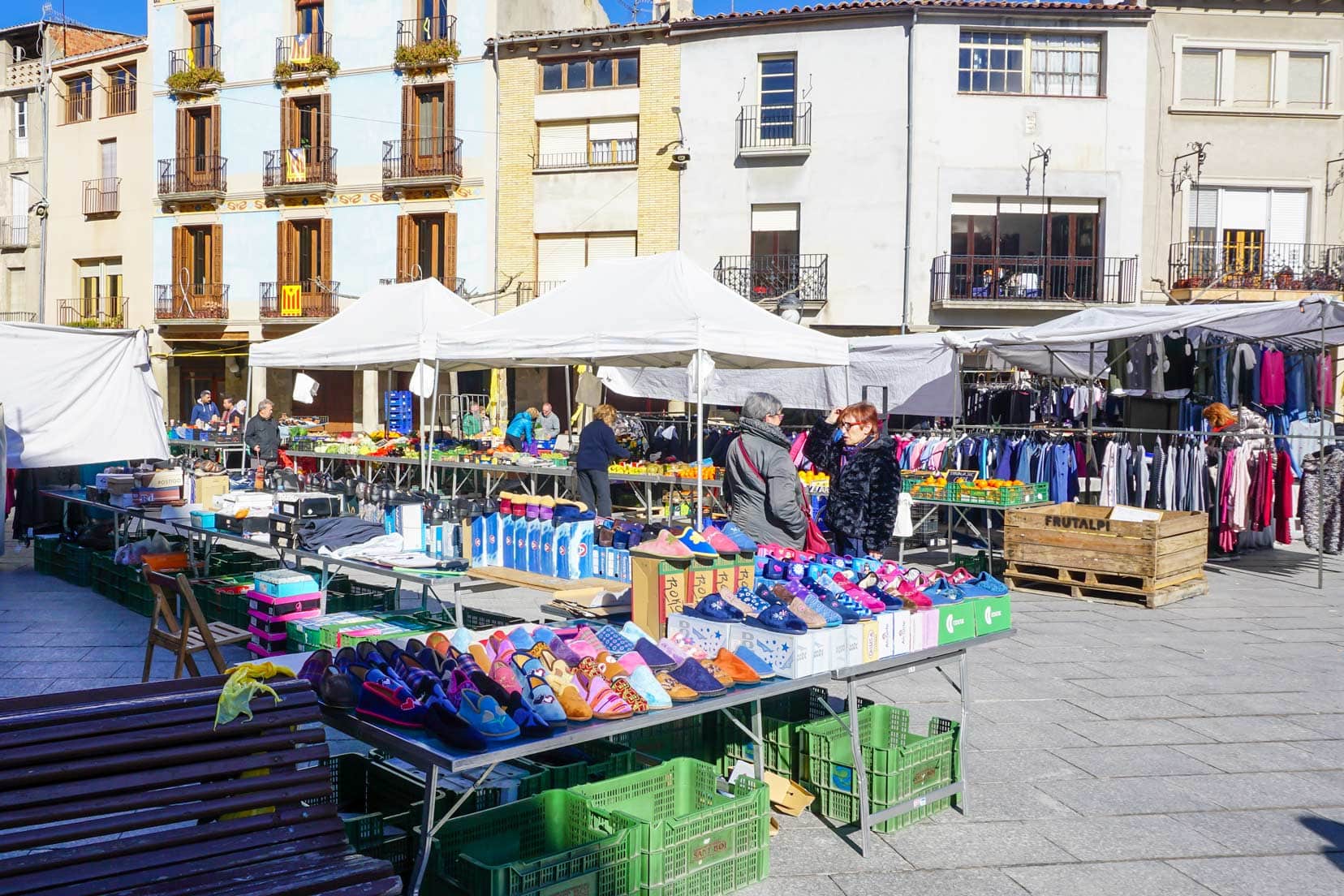
Santa Coloma De Queralt Accommodation and Motorhome Campsite
- Motorhome Campsite: Santa Coloma de Queralt
- Hotels and B&Bs: Santa Coloma de Queralt area on Booking.com
3. Valderrobres
🚐 Motorhome Campsite: Valderrobres
📏 Distance: Santa Coloma De Queralt to Valderrobres = 175 km
Valderrobes is another off-the-beaten-path town to add to your Spain road trip itinerary and is a fascinating place to explore.
Upon crossing the medieval arched bridge of San Roque, you arrive near the 16th-century City Hall. The narrow streets ascend steeply around the town, leading you to its 14th-century castle and the 16th-century church of Santa María la Mayor, designated a Historic-Artistic Heritage site.
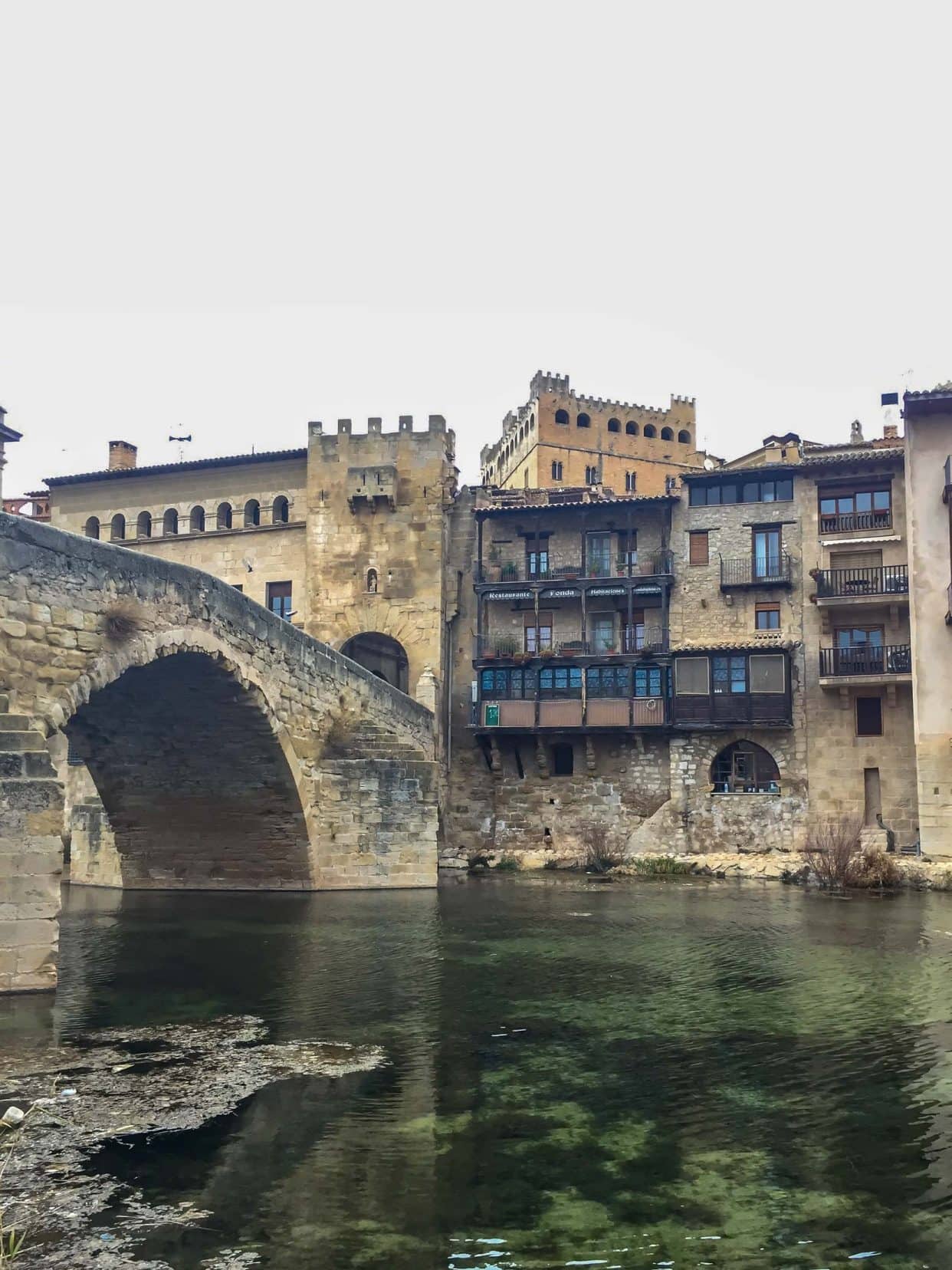
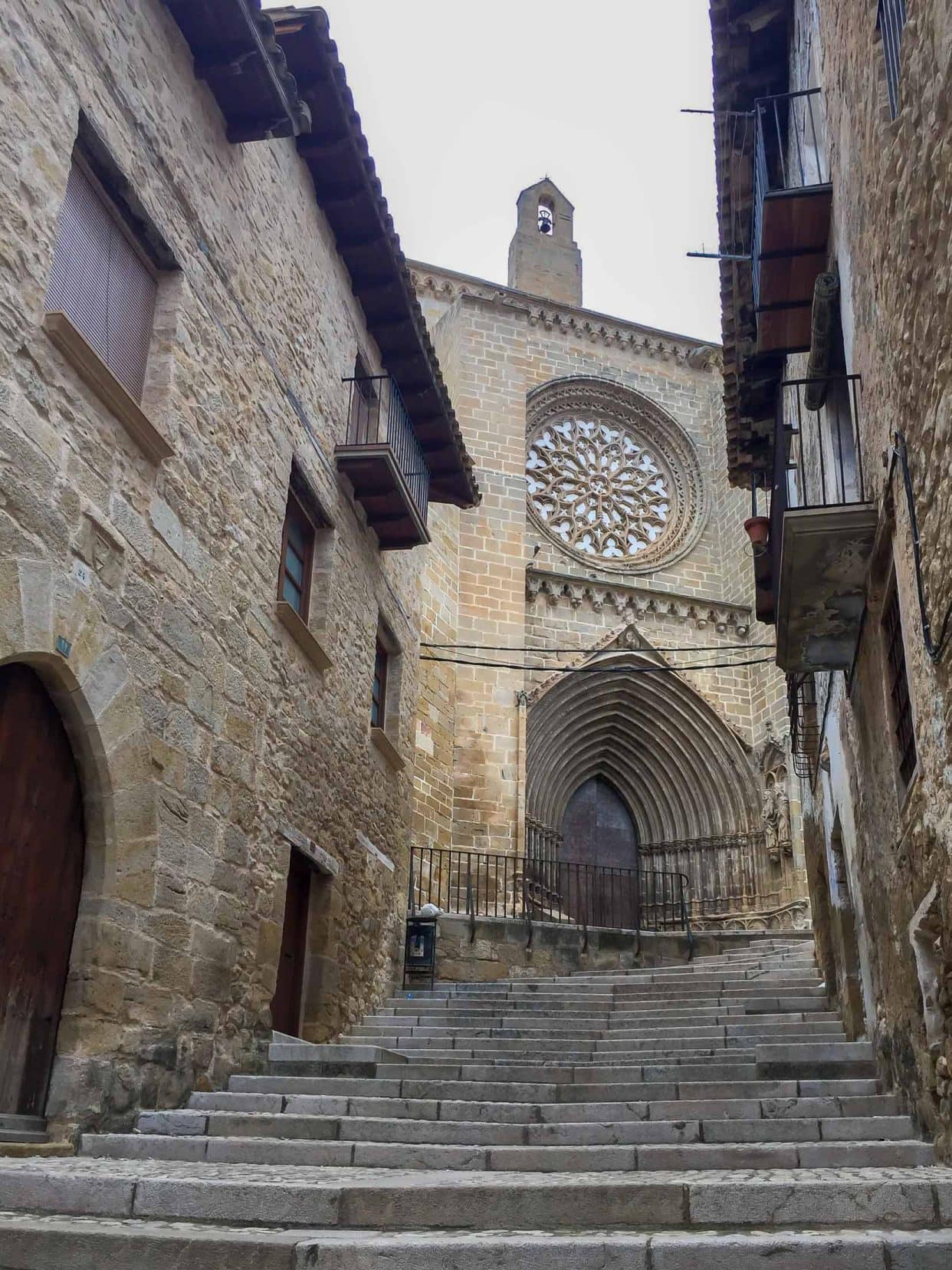
The church features a beautiful rose window, and the cemetery is known for its decorative gravestones.
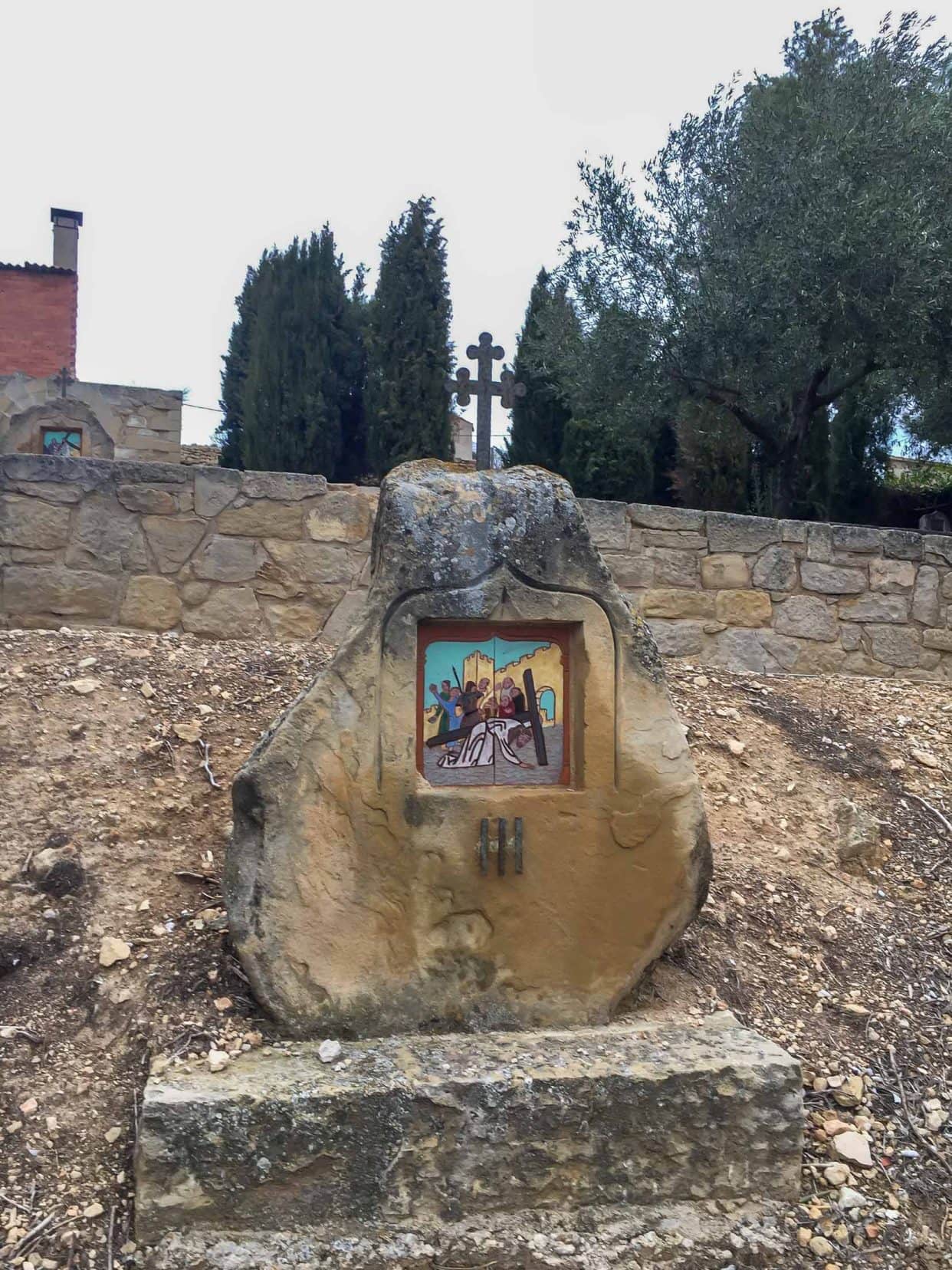
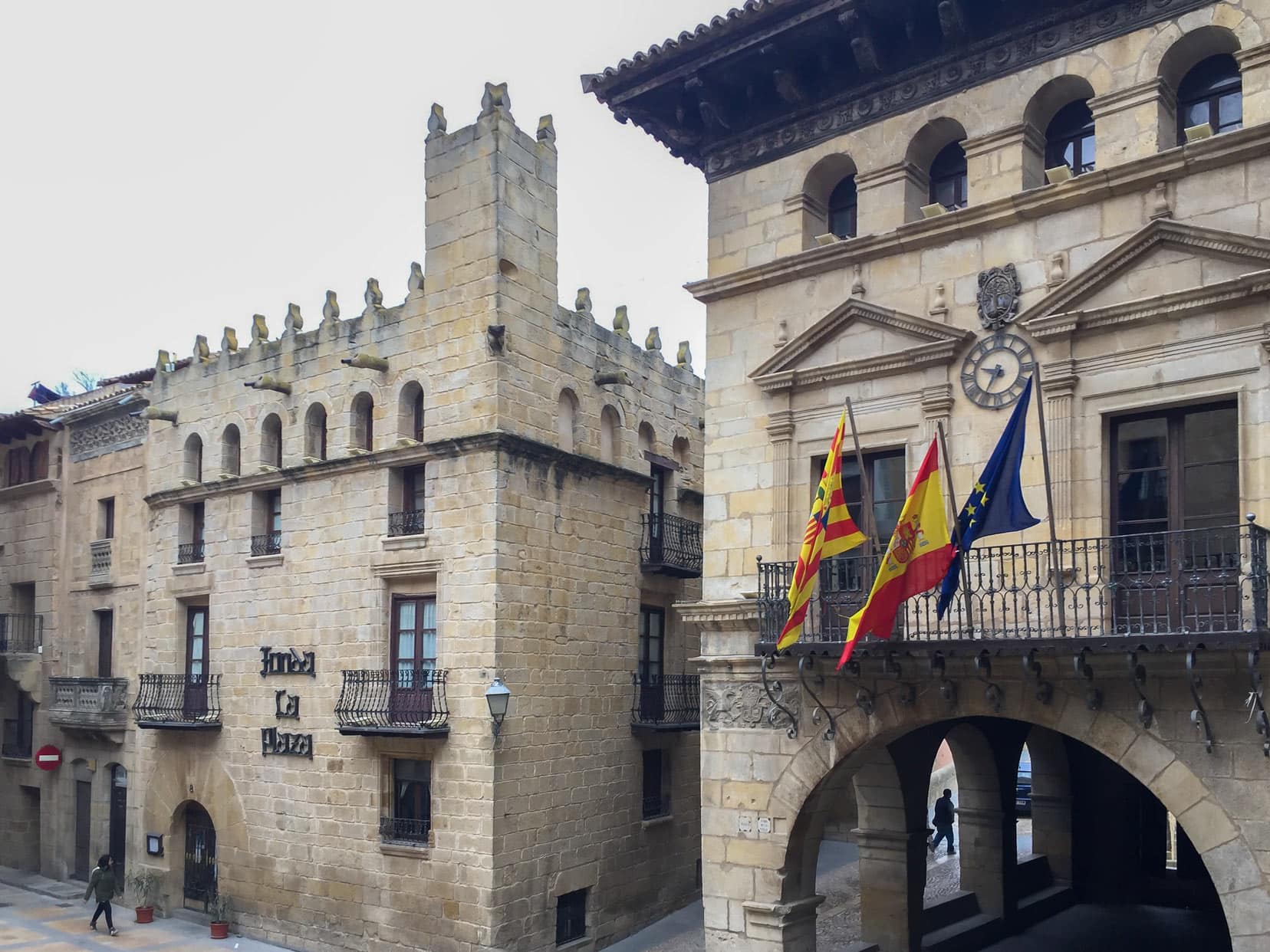
Valderrobres Accommodation and Motorhome Campsite
- Motorhome Campsite: Valderrobres — If you park in the Valderrobres campervan car park, you’ll find the old town just across the river.
4. Cuenca
🚐 Motorhome Campsite: Cuenca Camperstop
📏 Distance: Valderrobres to Cuenca = 327 km
Cuenca is known for its hanging houses or casa cogadas. The town is listed as a World Heritage Site due to it’s well-preserved fortified, medieval city.

Set high on the edge of the River Huécar gorge, Cuenca reminded us of our visit to Matera in Italy; a city built on the edge of a gorge with caves built into the steep gorge wall instead of wooden houses.
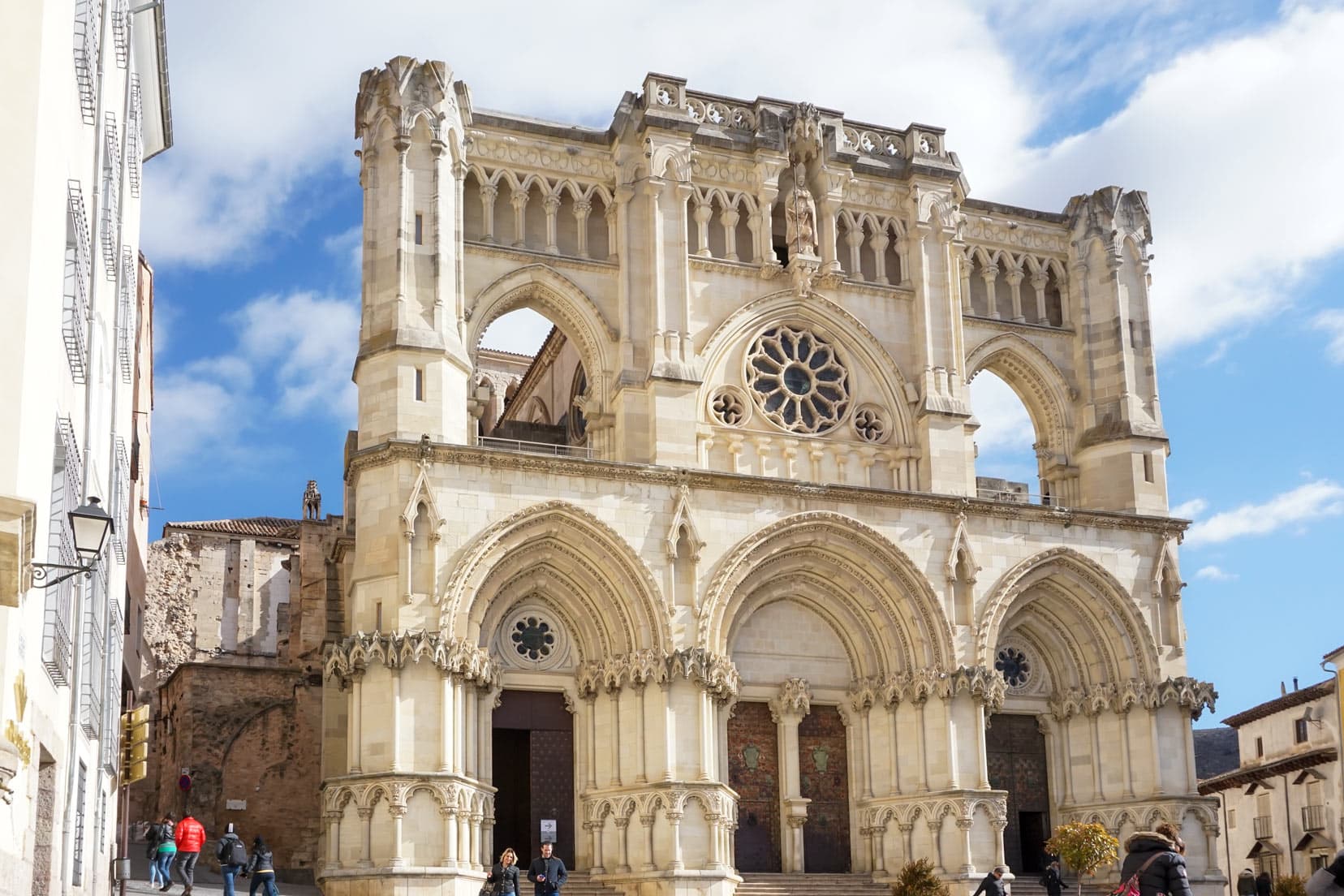
This short UNESCO video gives a great introduction to Cuenca and shows its hanging houses with their balconies literally hanging over the gorge.
Although winter, we had a clear blue sky when we explored Cuenca and its stunning surrounding landscape.
The next morning, a real surprise was in store for us: a stunning white carpet of snow.
We hadn’t expected snow in Spain, but high up in the mountains of mid-eastern Spain, it was a normal occurrence. It was chilly, and the thin layer of snow made for picturesque scenery.
When I researched a little deeper, I was surprsied to find that Spain has more than 30 ski resorts.
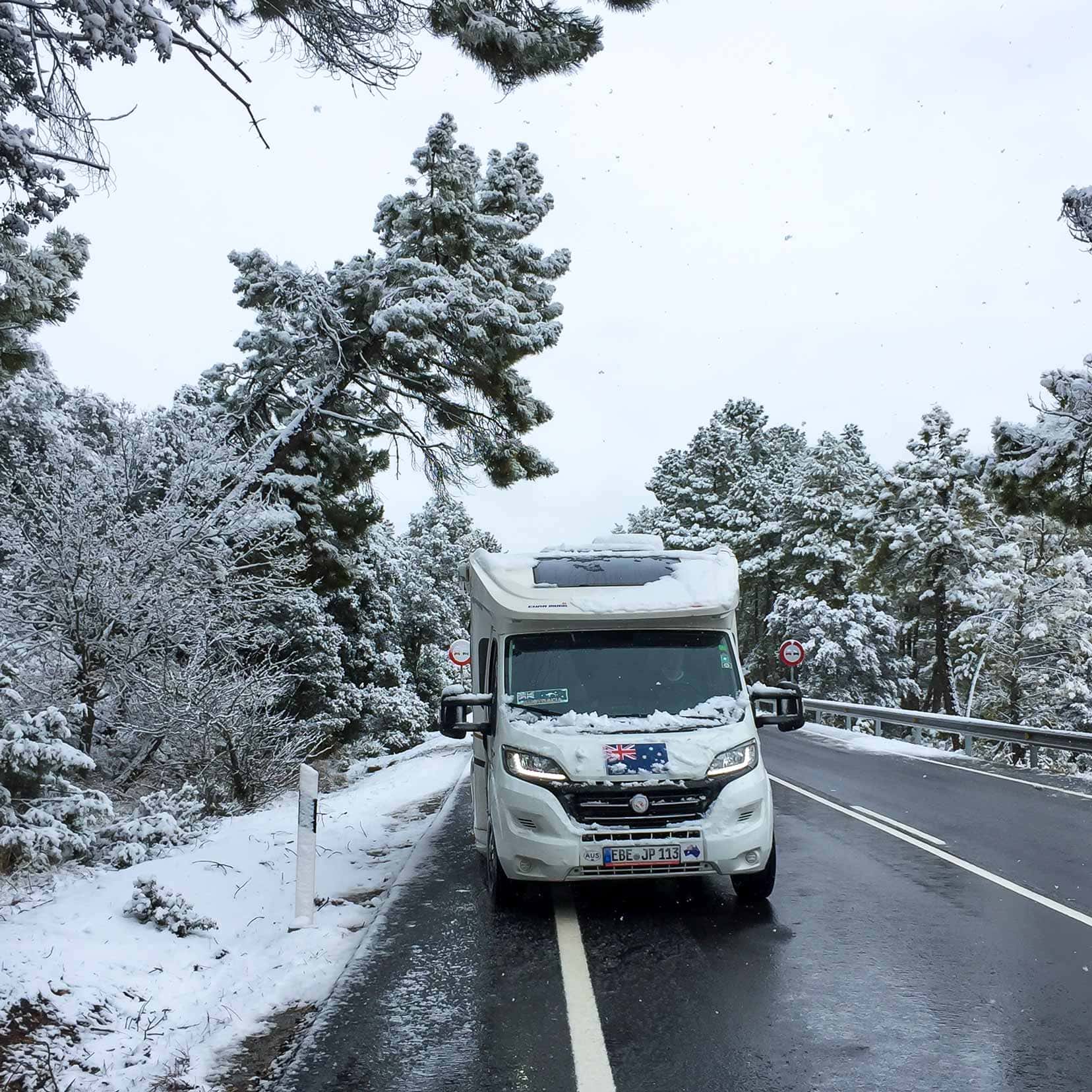
Cuenca Accommodation and Motorhome Campsite
- Motorhome Campsite: Cuenca Camperstop
- Hotels and B&Bs: Find accommodation deals in the Cuenca area on Booking.com
5. Sepulveda
🚐 Motorhome Campsite: Sepulveda Camper stop
📏 Distance: Cuenca to Sepulveda = 280 km
Sepulveda was an absolute delight. Of all the small towns we visited, this one felt like you had stepped back in time.
Located in the Sergovia region of Castile and Leon, Sepulveda has been a Historic-Artistic Site since 1951. Its architecture and monuments are built in the Romanesque style of the 11th and 12th centuries, and its El Salvador Church dates all the way back to 1093.
The small town is full of olde-world charm with several restaurants and cafes to sample traditional Castilian Cuisine. You’ll find a tiny restaurant on one of the narrow streets, Figón Zute El Mayor.
It has only one dish on the menu, Cordero (suckling lamb). Since 1850, this family-run business roasts its lamb in a traditional wood oven and has won several awards for its succulent local dish.
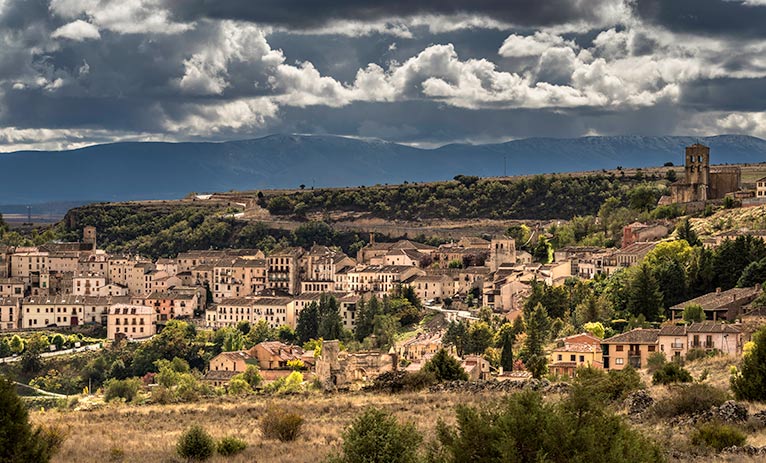
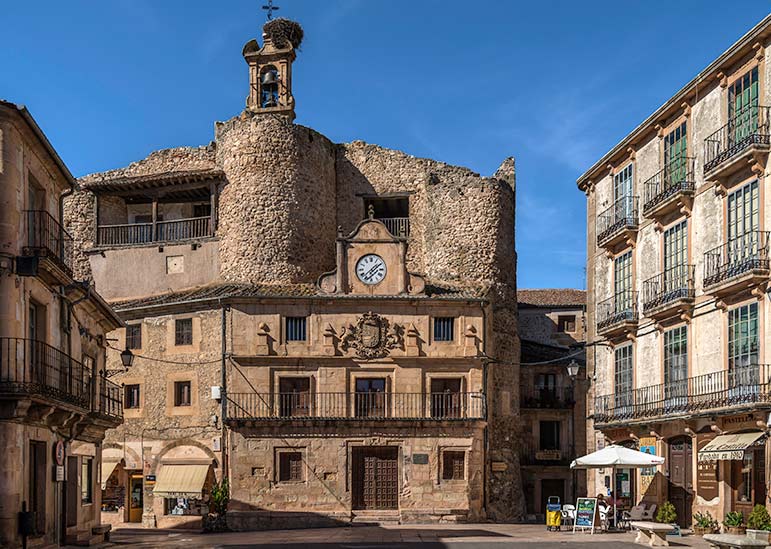
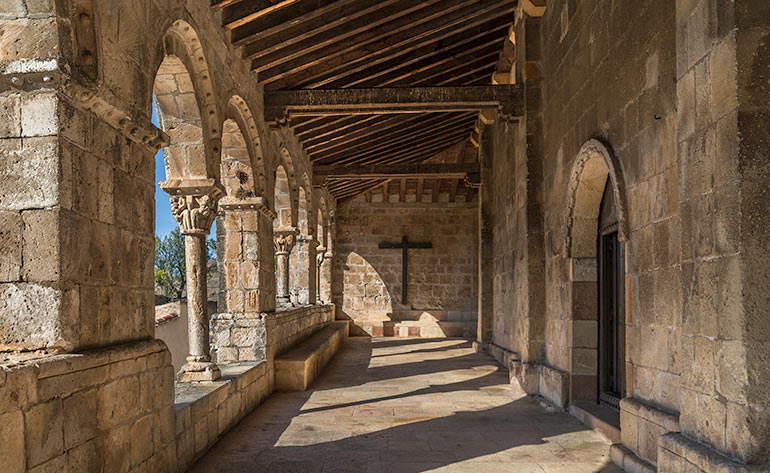
What else is nearby to visit?
The World Heritage City of Segovia, with its Roman Aquaduct, and the medieval town of Pedraza.
Sepulveda Accommodation and Motorhome Campsite
- Motorhome Campsite: Sepulveda Camper stop
- Hotels and B&Bs: Sepulveda area on Booking.com
6. Palencia
🚐 Motorhome Campsite: Palencia Camperstop
📏 Distance: Sepulveda to Palencia = 140 km
Palencia is just 140 km northwest of Sepulveda, in northern Spain and is the capital of the Castile-León region.
Its Cathedral, Palencia Cathedral (Catedral de San Antolín en Palencia), looks impressive enough from the outside. However, the interior houses more than twenty chapels of artistic and historical interest.
Just one of the reasons the cathedral is known as the Undiscovered Beauty.
In the square outside the cathedral, you’ll find a monument dedicated to the ‘maestro’, created by Rafael Cordero. It depicts the master and his pupil and was erected in 2003.
Walking to the centre of Palencia from our campervan stop, we crossed an attractive medieval bridge, Puenta de Puentecillas.
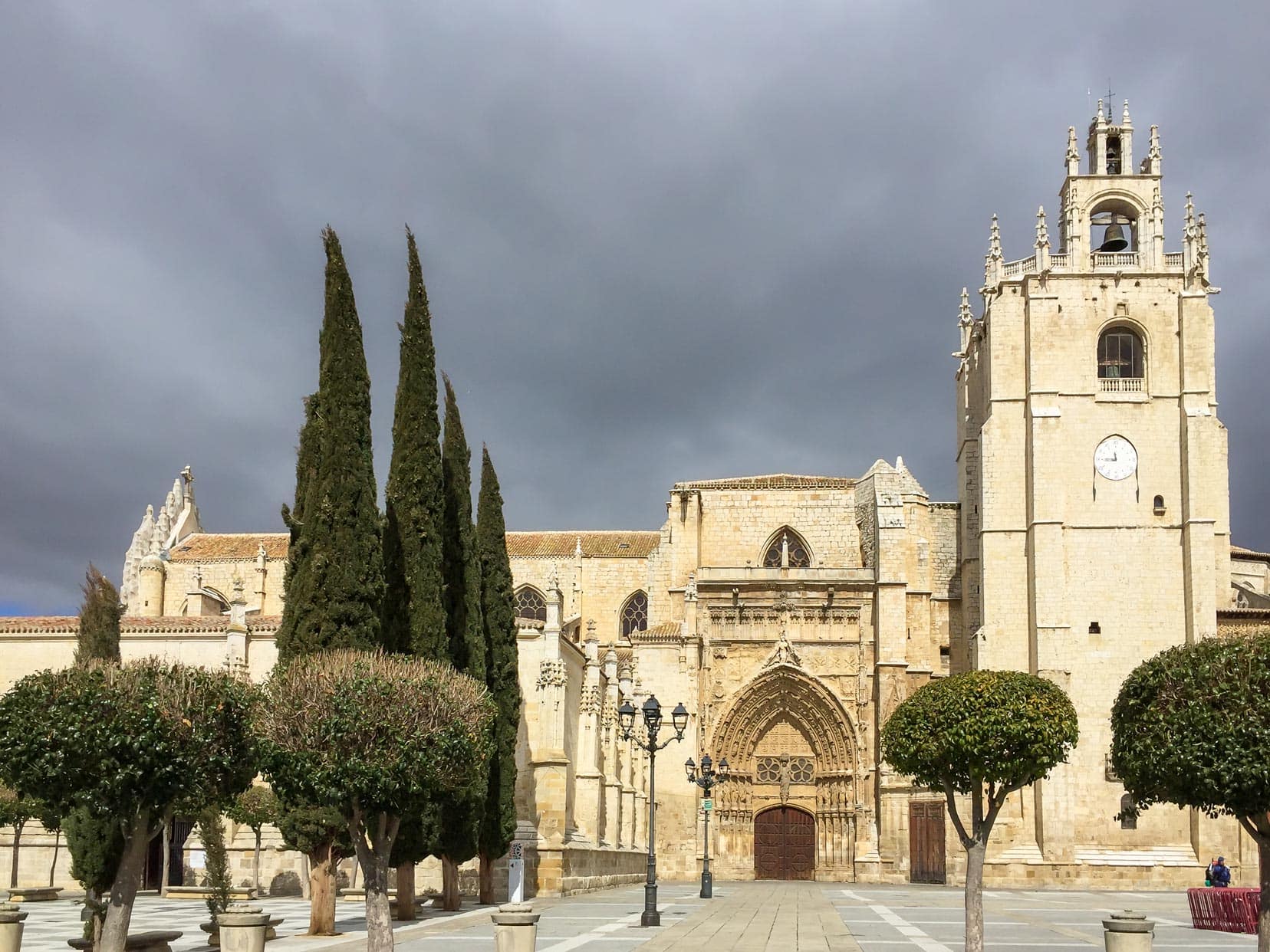

One of Palencia’s main drawcards is the Castilla Canal, which starts in the village of Alar del Rey.
The Castilla Canal, engineered in the 18th century, is a 200-km irrigation channel. A path follows the canal, which is perfect for walking or cycling.
We cycled for miles along the canal, enjoying the picturesque bridges, aqueducts and a great way to see the landmarks in the area.
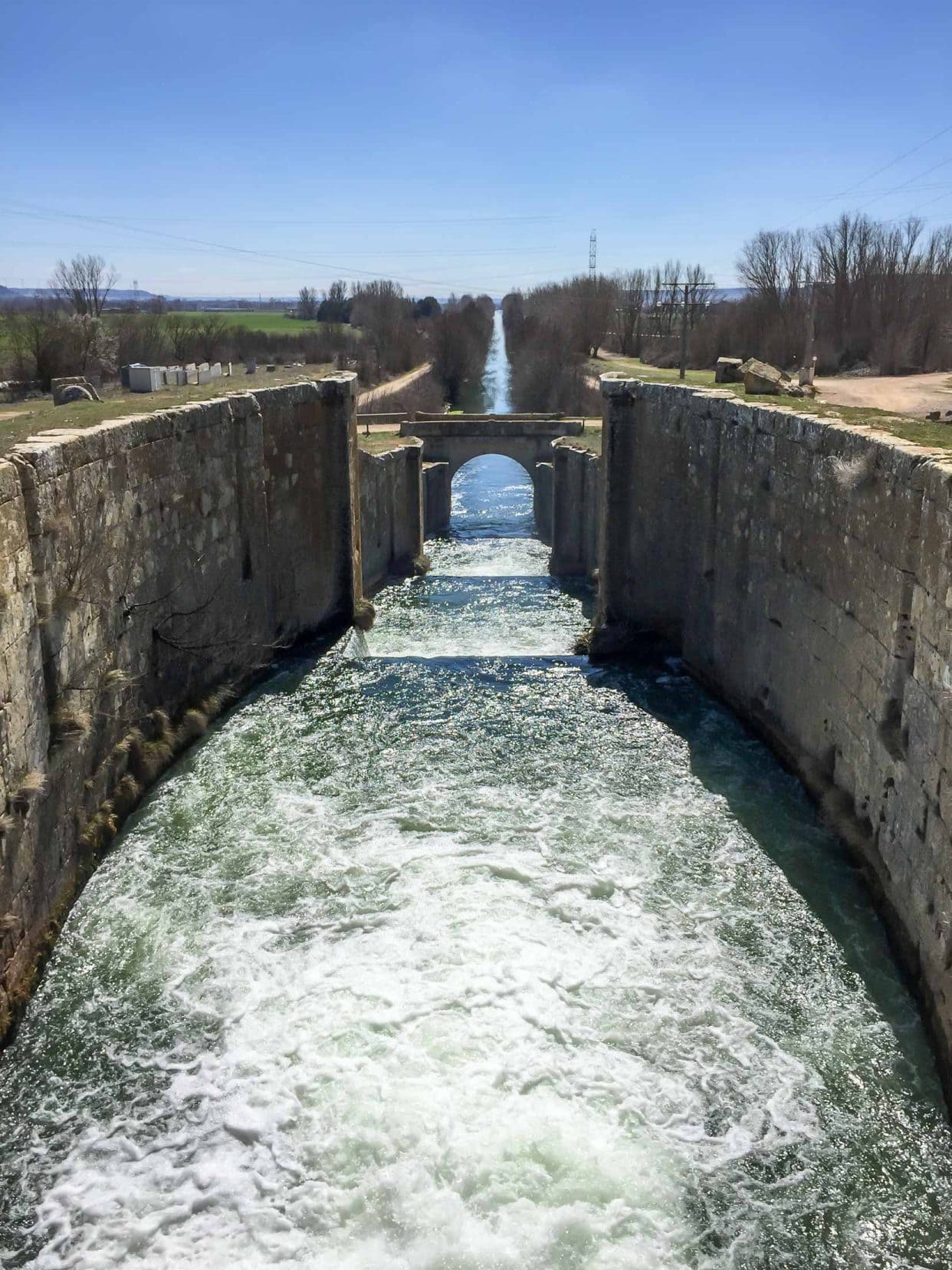
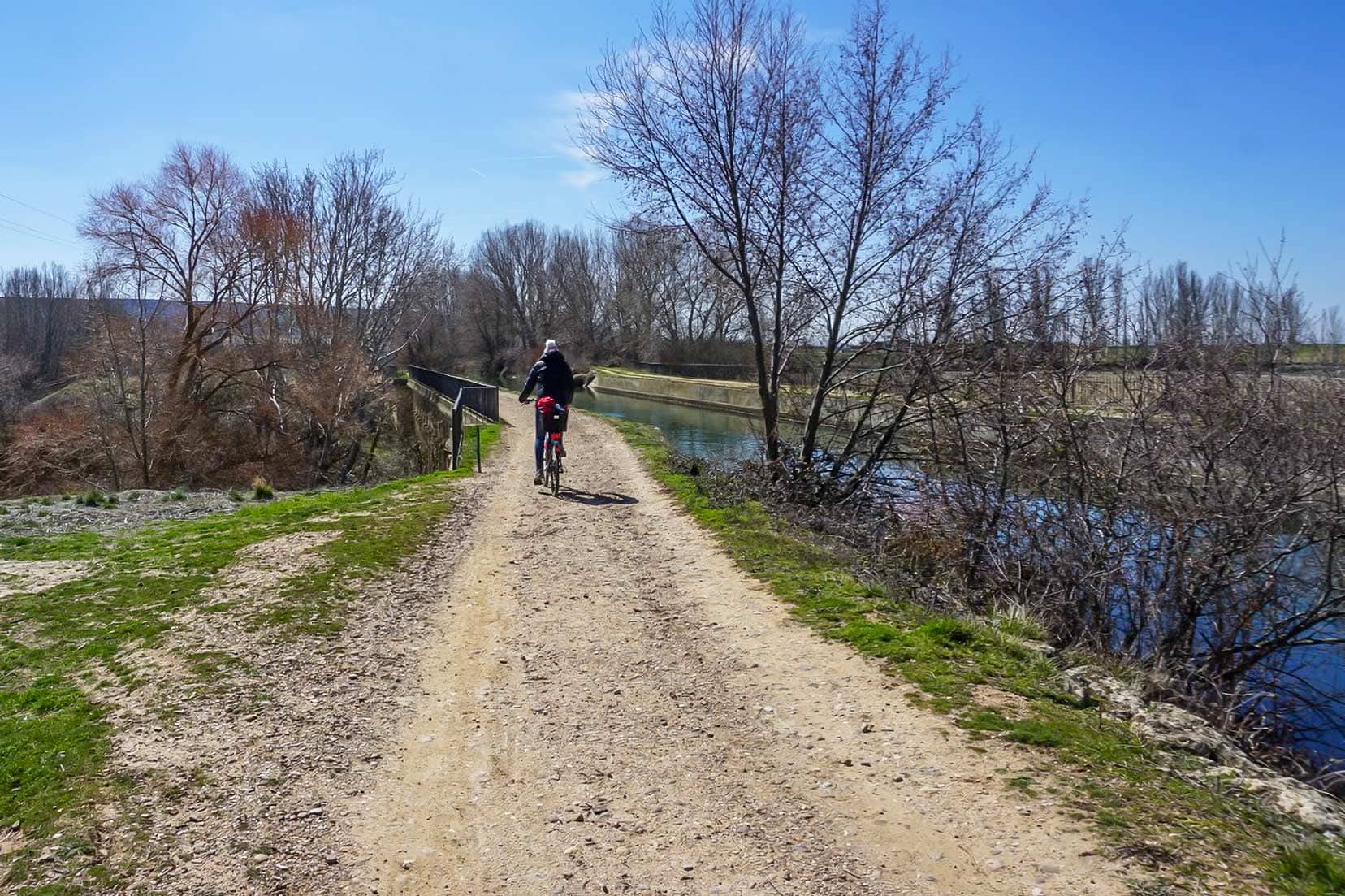
Palencia Accommodation and Motorhome Campsite
- Motorhome Campsite: Palencia Camperstop
- Hotels and B&Bs: Palencia area on Booking.com
7. Sierra Espūna (optional overnight in Madrid)
🚐 Motorhome Campsite: Camperstop Sierra Espuna
📏 Distance: Palencia to Sierra Espūna = 720 km
Today is a lot of driving, as we were keen to head into southern Spain. However, you could just as easily break it up with a stopover in Madrid.
The Area de Autocaravanas Las Cigüeñas is a paid motorhome campsite with reasonable reviews, close to the city centre.
There are many activities to choose from in Spain’s capital city.
Having bypassed the capital in our excitement to reach southern Spain, our Spanish road trip begins in the hills of Sierra Espuna, a regional reserve in the central part of the Murcia region. It’s a lovely place to start exploring the South, with 17000 hectares just waiting to be explored.
Whether you discover this Regional Park on foot, cycling, or driving, the area offers a varied landscape. The Espuna mountains are carpeted with pine forests, and the foothills are filled with farmlands and orchards.
We decided to stay at a well-located, reasonably priced basic campsite, Camperstop Sierra Espuna. It was just a short five-minute drive from the town of Totana, also known as ‘Potter City’ because of its long history of ceramics and pottery.
There are numerous walks and trails in Sierra Espuna National Park, and we made the most of combining a hike in the mountains with the search for geocaches. In February, the almond trees displayed their beautiful white blossoms, and the orange trees were full of fruit.
On the hunt for geocaches, we headed out to find the Santa Eulalia de Merida Sanctuary, discovering the White Virgin statue on the way. (See Map).
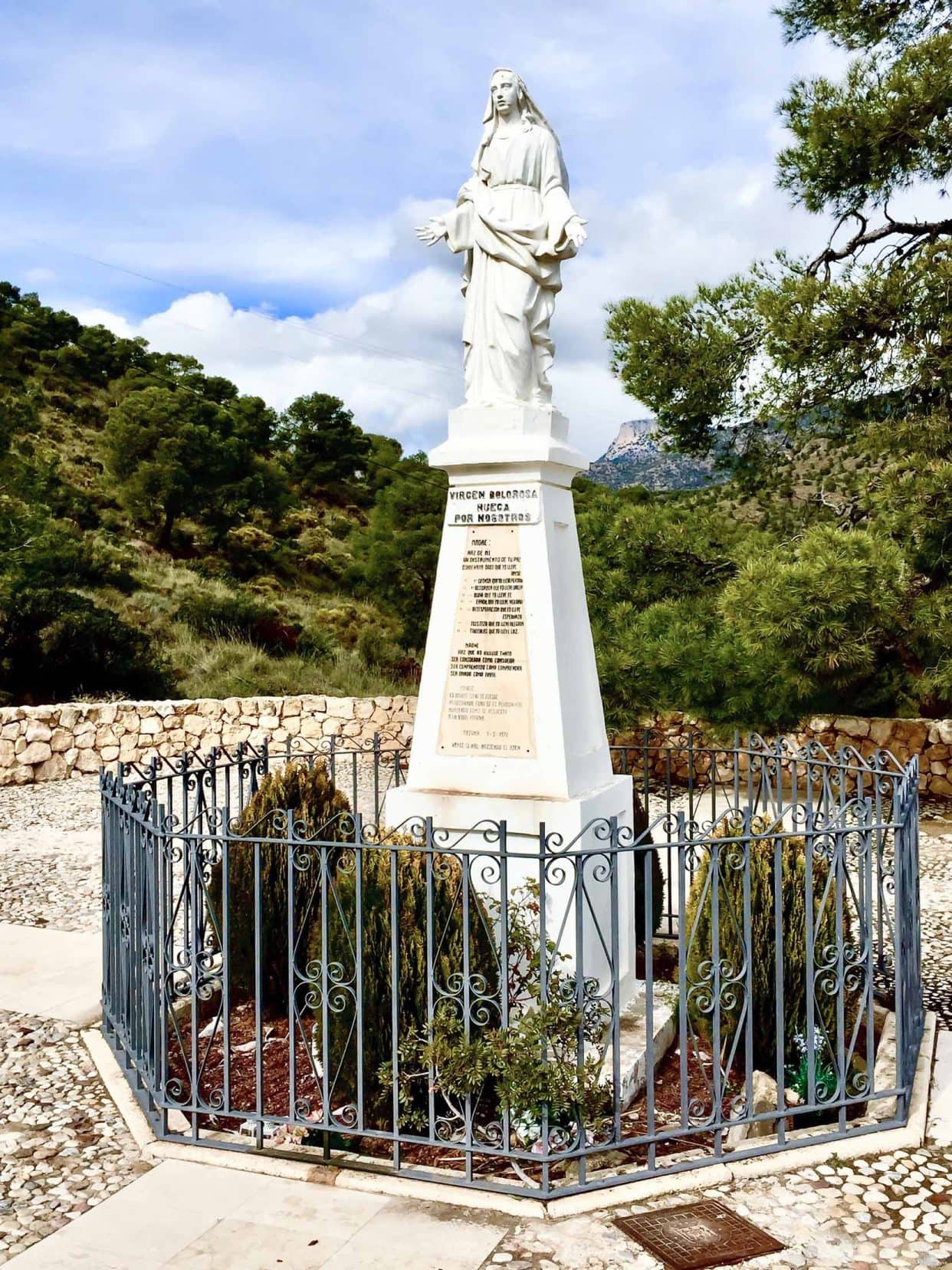
There were magnificent views across the hills of Sierra Espuna, which put the reserve’s size into perspective.
We reached the large buildings of the Santa Eulalia de Merida Sanctuary and walked its grounds. The sanctuary dates back to medieval times and aims to care for those coming to pray to the Martyr Saint Eulalia.
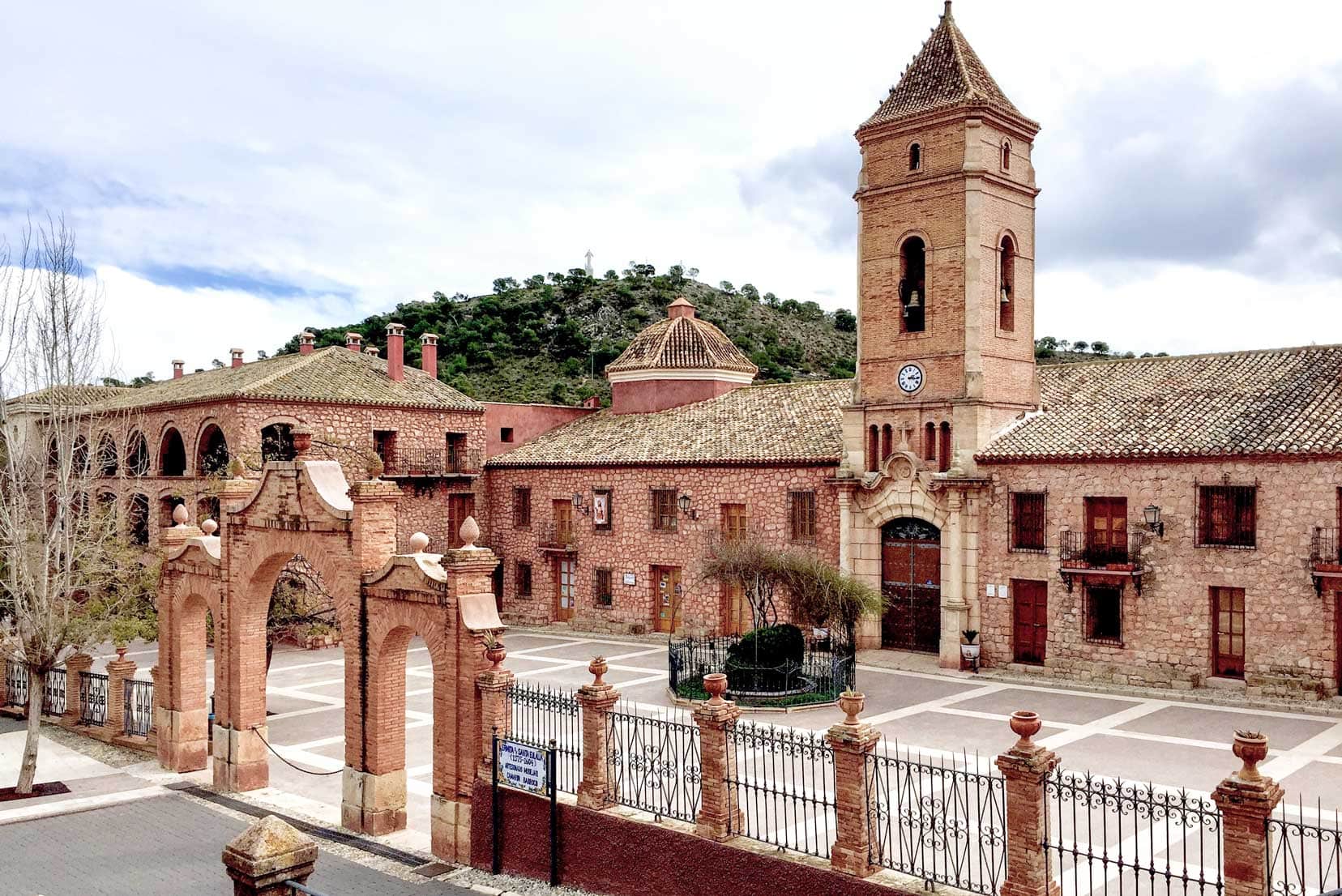
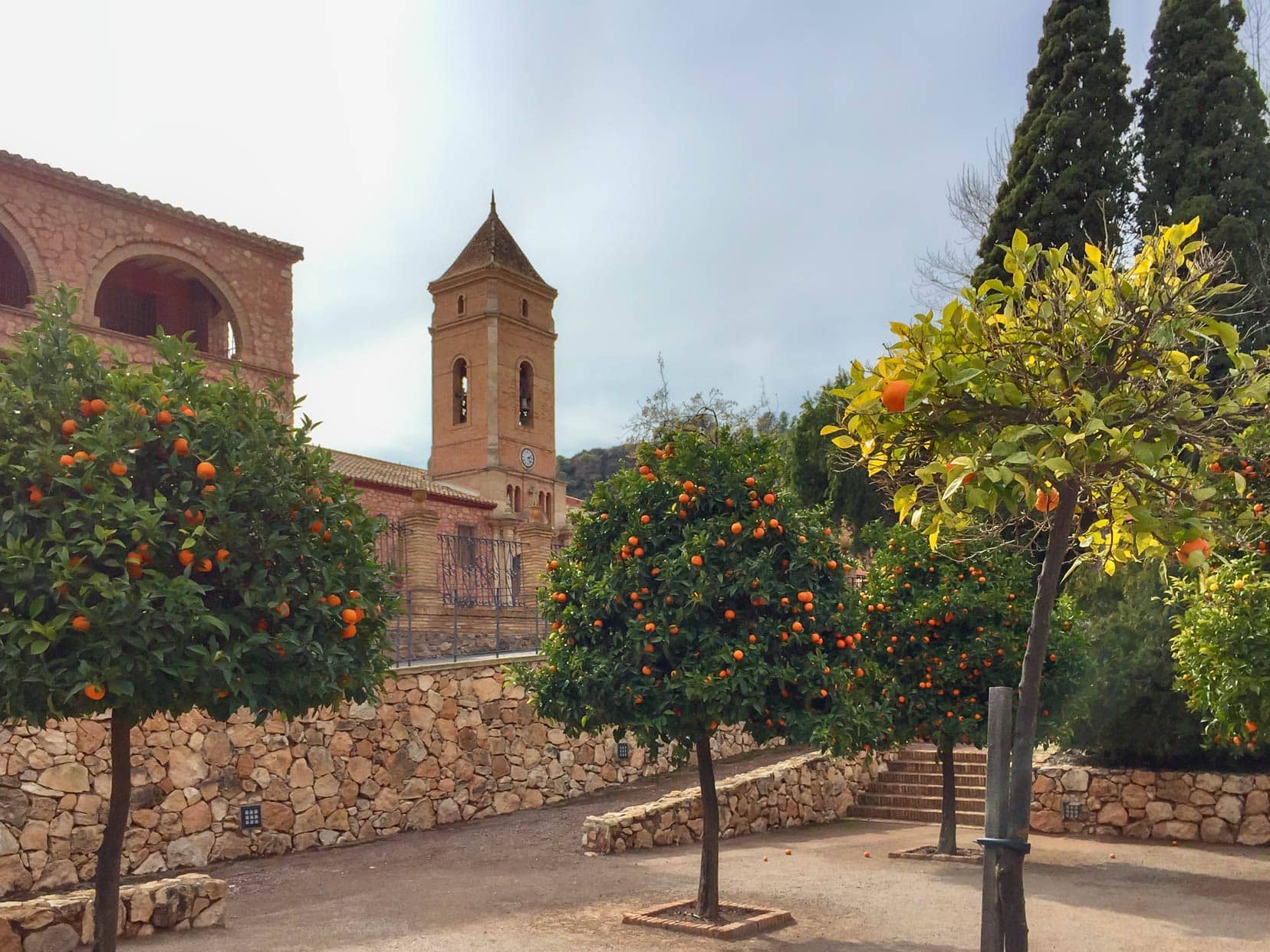
The gardens were abundant with vividly coloured orange and mandarin trees bearing fruit. They looked so tasty that we plucked a couple to taste, but were way too sour.
Sierra Espuna Accommodation and Motorhome Accommodation
- Campervan Campsite: Camperstop Sierra Espuna
- Hotels and B&Bs: Alhama Murcia area on Booking.com
8. Granada
🚐 Motorhome Campsite: Camping Reina Isabel Granada
📏 Distance: Sierra Espūna to Granada = 250 km
Leaving the campsite in Sierra Espuna, we drove three hours southwest to Granada to visit the famed Islamic palaces and grounds of La Alhambra.
La Alhambra
Originally a small fortress built around AD 900, La Alhambra was converted into a palace in the mid-13th century. Since then, various Muslim rulers of La Alhambra have extended sections of the palaces but still within the theme of creating what they called paradise on earth.
Most buildings are rectangular, with rooms opening onto a central court. The exteriors of the buildings were purposely left plain in contrast to the intricately designed interiors.
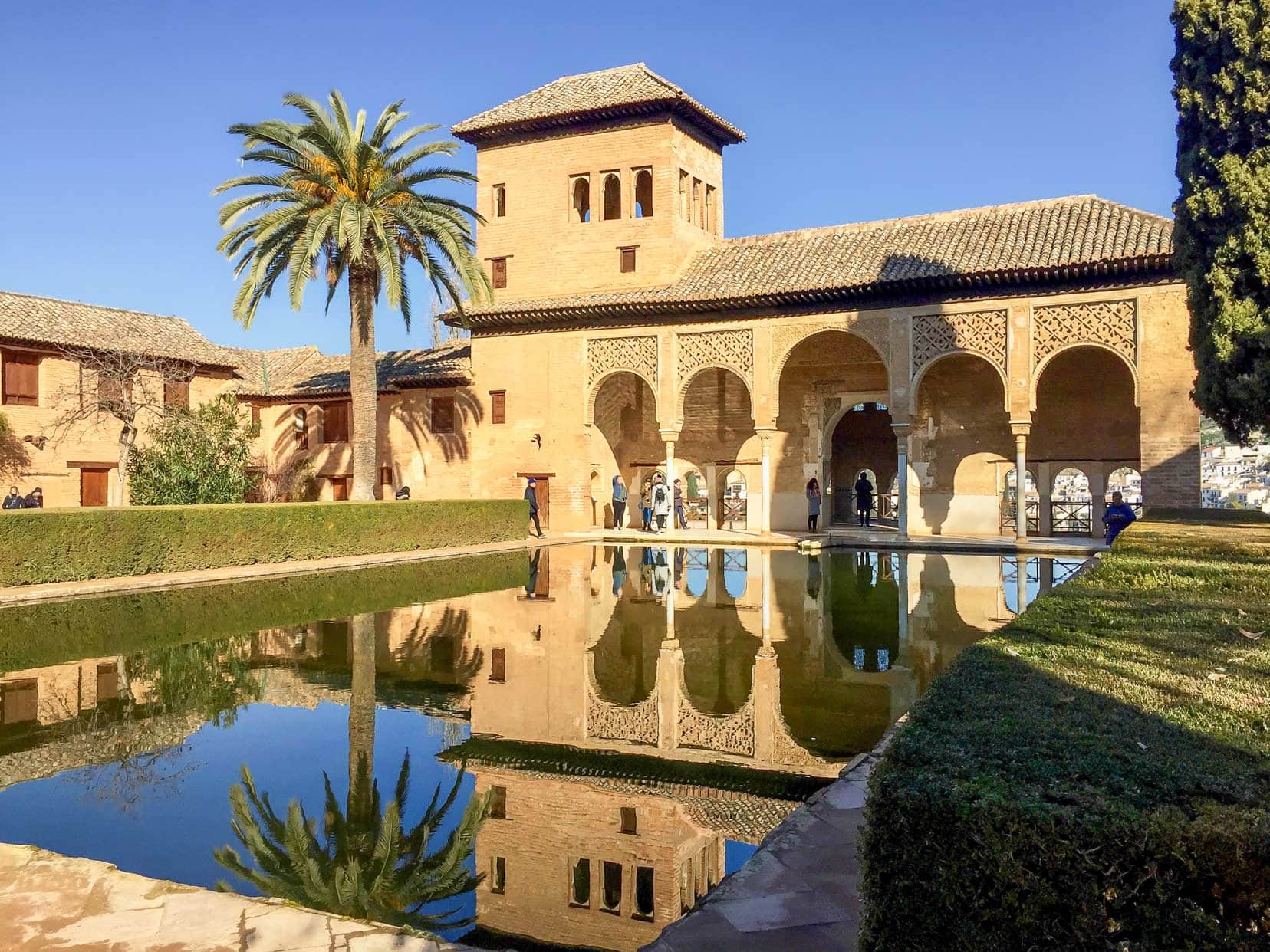
The exquisite, intricate facades, flowing waters, pools, tranquil gardens, and beautifully themed structures create an ambience of serenity.

We bought a couple of online General Admission tickets, which included entry to all the main areas.
❗️However, the Nasrid Palaces is a timed entry, whereas the other areas can be walked leisurely.
We immersed ourselves in the splendour of this paradise on earth, peering through the numerous arches, gazing at the unbelievably intricate architectural details and strolling the manicured gardens.
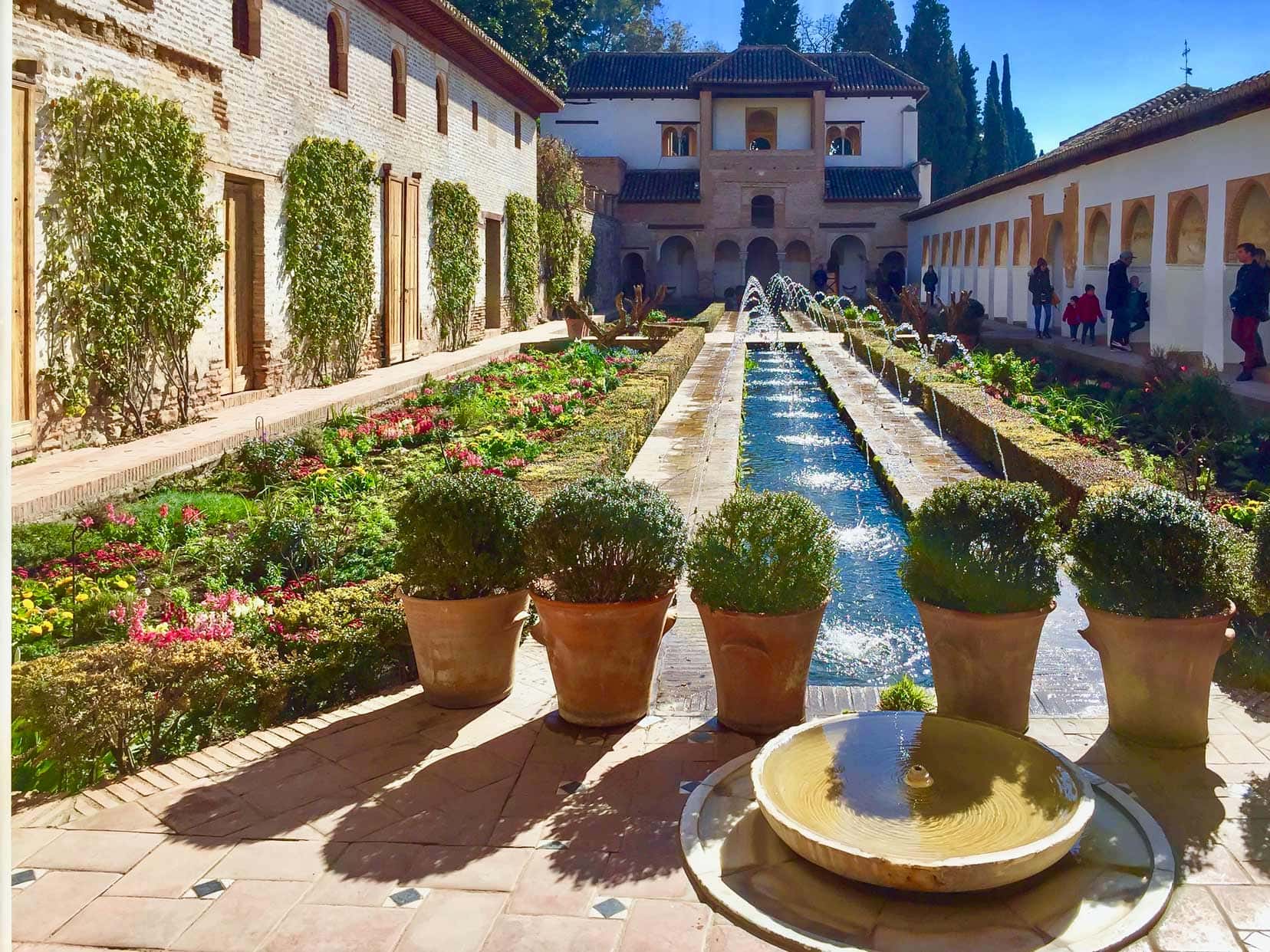
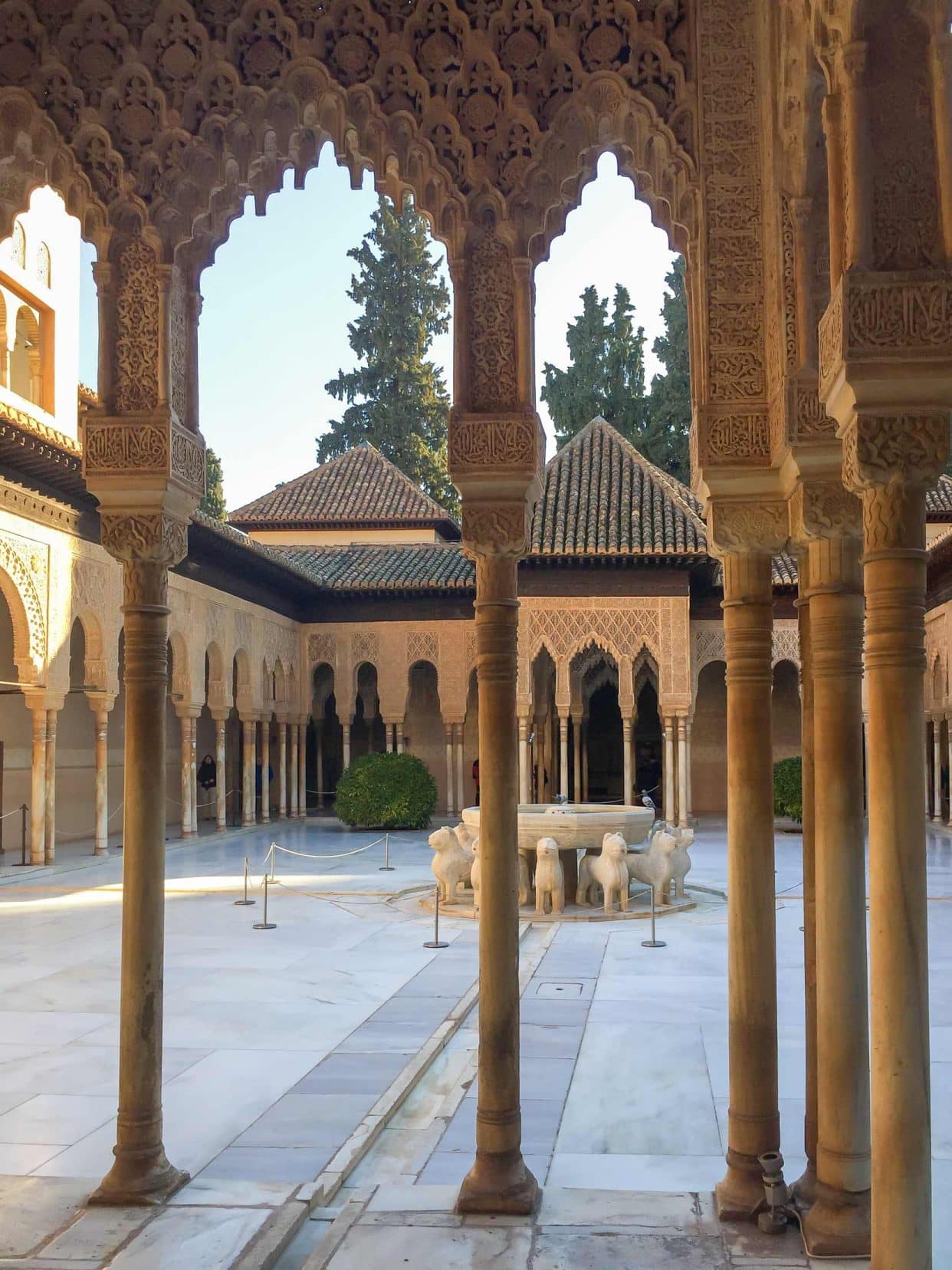
Granada Accommodation and Motorhome Campsite
- Campervan Campsite: Camping Reina Isabel Granada
- Hotels and B&Bs: Granada area on Booking.com
9. Malaga
🚐 Motorhome Campsite: Malaga – Area el Rincon
📏 Distance: Granada to Malaga = 150 km
We’d heard Malaga was a busy seaside resort-type town full of high-rise apartments and hotels.
So, to be honest, we weren’t expecting much from Malaga, but the old part of the city quickly won us over with its historical ramparts, cobbled laneways, historical architecture and beautiful gardens.
In fact, Malaga has transformed from a beach resort to a city renowned for its 80+ museums and art. It has advanced so much that it won the 2020 European Capital of Smart Tourism.
Castillo De Gibralfaro
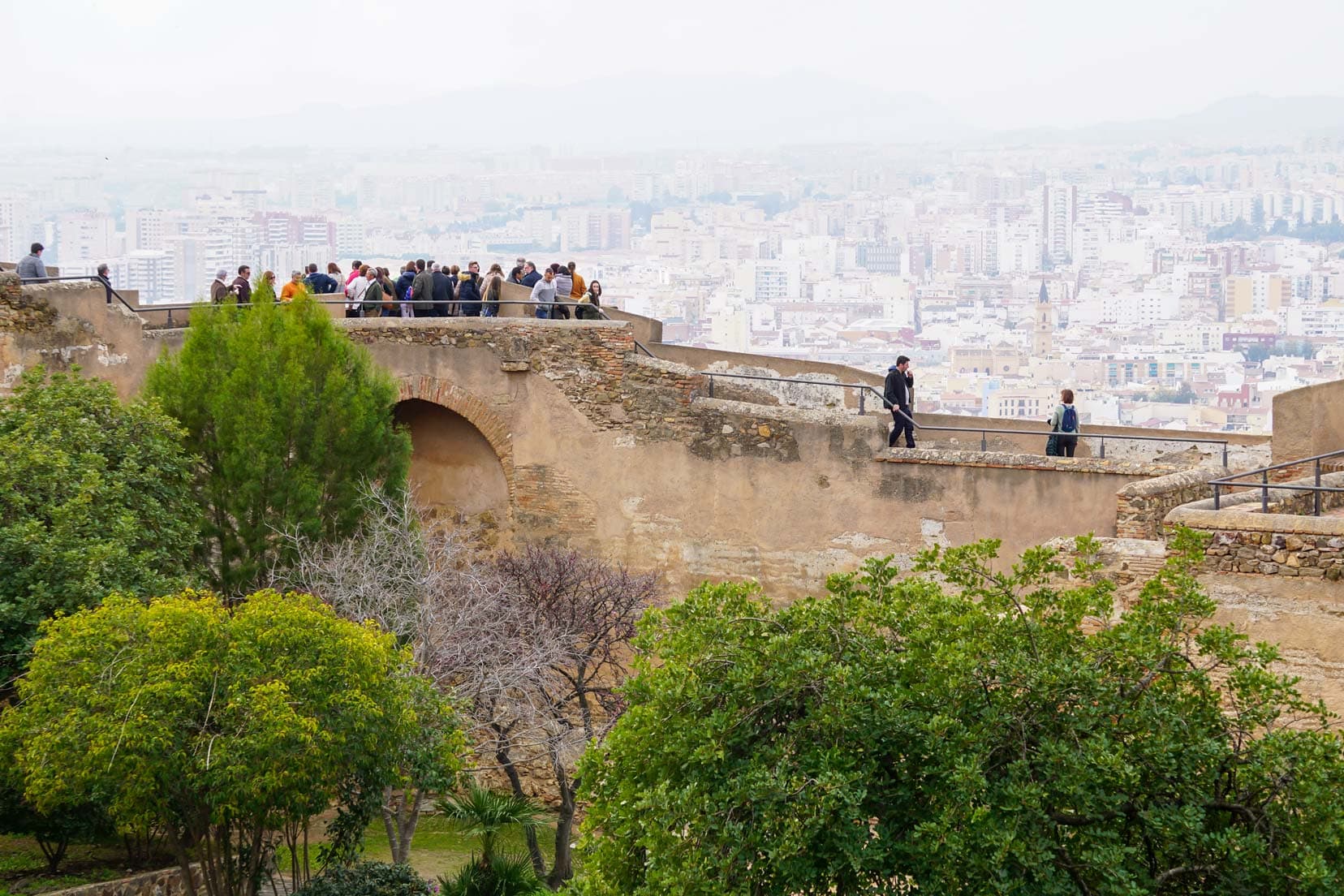
Overlooking Malaga harbour, at the top of a hill, you’ll see Castillo de Gibralfaro. This fortress has two rows of protective walls with multiple towers.
It was built in the 14th century to house troops and to protect the Alcazar (a type of Moorish castle built during Muslim rule).
Although a steep walk up the hill to the entrance, enjoying spectacular views across Malaga is worth it.
✅ Tip: There is free entry on a Sunday after 2.00 p.m.
Pablo Picasso Museum
The museum houses Pablo Picasso’s paintings, musings, and other works showcasing his life. There is much to see that showcases this famous artist’s journey.
❗️However, be warned that the queue for the free opening times was extremely long, so you may want to plan to be there before the free entry time to start queuing.
✅ Tip: Free entry on Sundays, 2 hours before closing
Pompidou Centre Museum
The Pompidou Art Museum hosts modern and contemporary art from the 20th and 21st centuries. The building is crowned by a distinctive multi-coloured cube, ‘El Cubo’, and is easily accessed via the pedestrian boardwalk along the seafront.
Although we were not won over by the building’s exterior, it did give us something to ponder, which I guess is the aim of art.
What do you think?
Cathedral De Santa Maria De La Encarnacion
The huge cathedral of Cathedral De Santa Maria De La Encarnacion is set in the centre of the old town, surrounded by relatively small gardens. It took over 250 years to build and was completed in 1782.
It represents a synthesis of Gothic and Baroque architecture with ornate details on the facade.
Often, large cathedrals in Europe have big open spaces around them, but here, the surrounding streets are narrow, and the cathedral feels like part of a village square, making it more personable than other cathedrals.
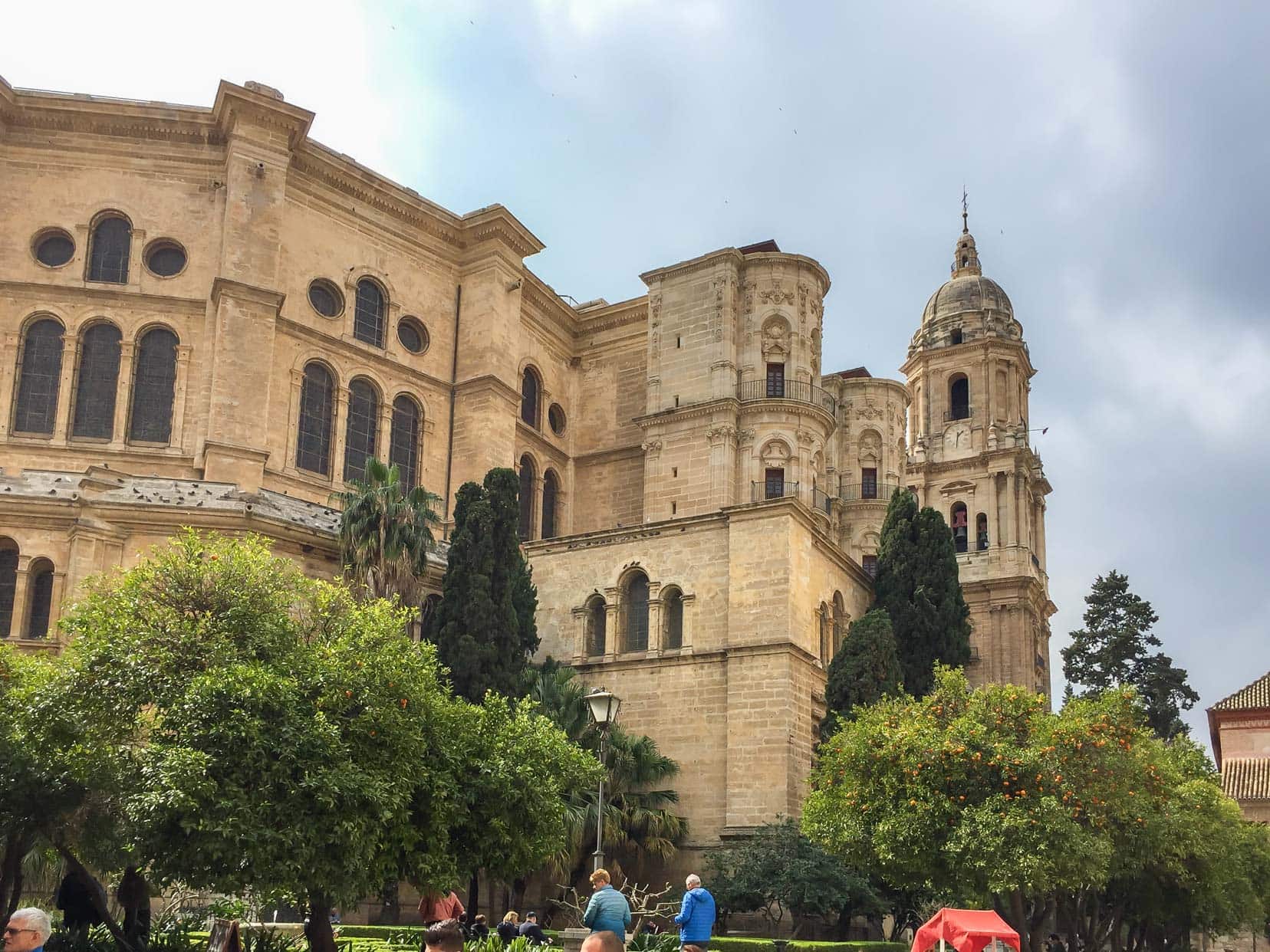
El Teatro Romano
The 1st-century Roman Theatre, lying in the heart of old Malaga, is a 200m walk from the Cathedral de Santa Maria de la Encarnacion. It was only discovered in 1952 when local excavation work revealed its location.
✅ This ancient theatre is free to visit.
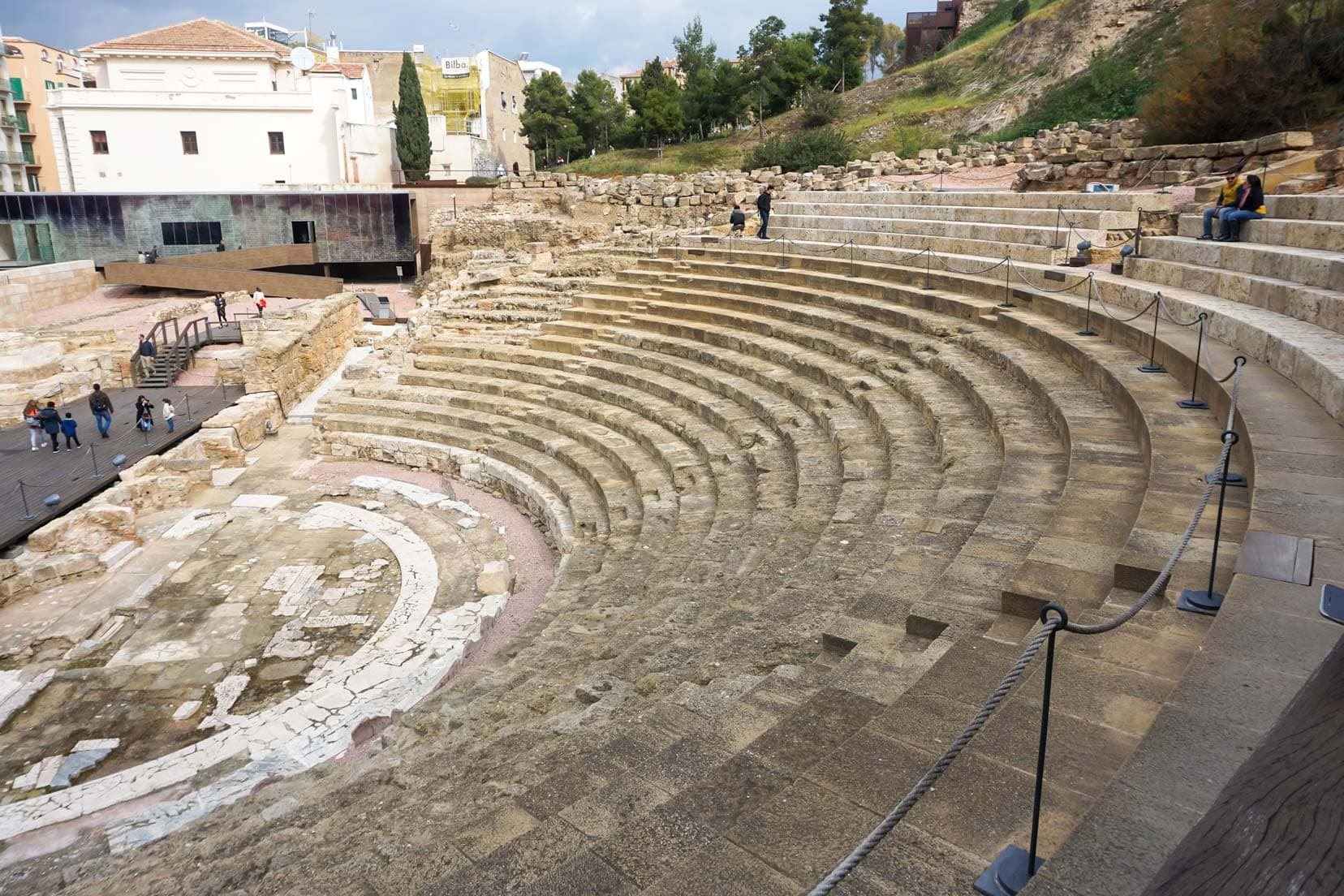
There are many parks and gardens in Malaga however, we visited these lovely ones:
- Jardines Puerta Oscura: with scenic views and manicured gardens,
- Jardines de Pedro Luis Alonso: with an extensive rose garden and colourful bird life, and
- Parque de Malaga, an urban botanical garden near the palm-lined Portway Walk.
All of these gardens are marked on the map above.
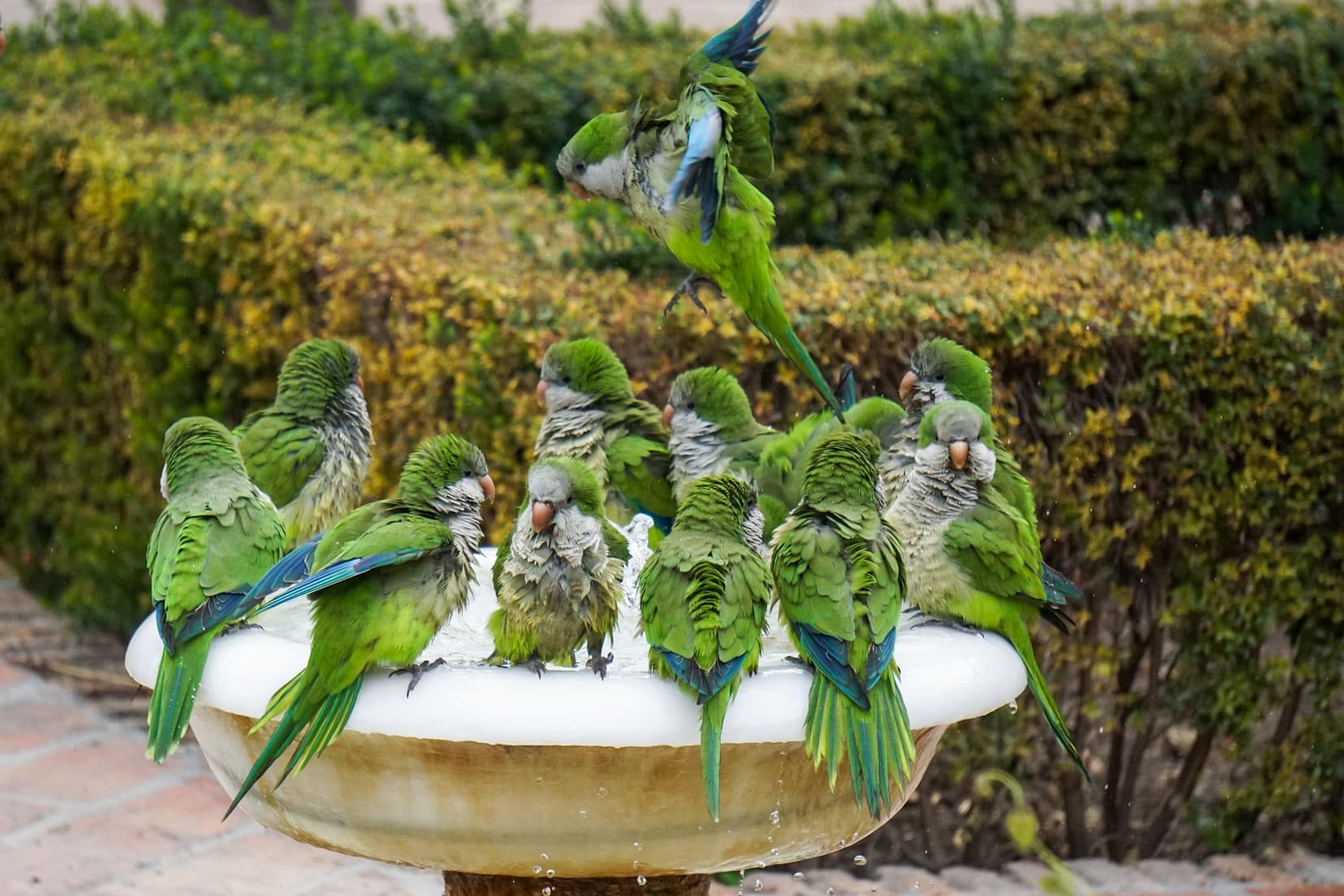
Malaga Accommodation and Motorhome Campsite
- Campervan Campsite: Malaga – Area el Rincon
- Hotels and B&Bs: Malaga area on Booking.com
10. Ronda
🚐 Motorhome Campsite: Ronda – Ciudad de Ronda
📏 Distance: Malaga to Ronda = 100 km
Ronda is a small but impressive town situated on a windy escarpment high above a deep gorge through which runs the Guadalevin River. The gorge divides the town, separating the old and new towns of Ronda.
🥾 This 2-hour guided walking tour of Ronda is rated ⭐️ 4.5 / 5 and is available in English.
Puento Neuvo
Ronda is famed for its picturesque 18th-century bridge, which towers 120m above the canyon floor.
The bridge has a chamber above the central arch that was allegedly used as a torture chamber with people thrown to the rocks below. Not so much torture — rather, a death sentence.
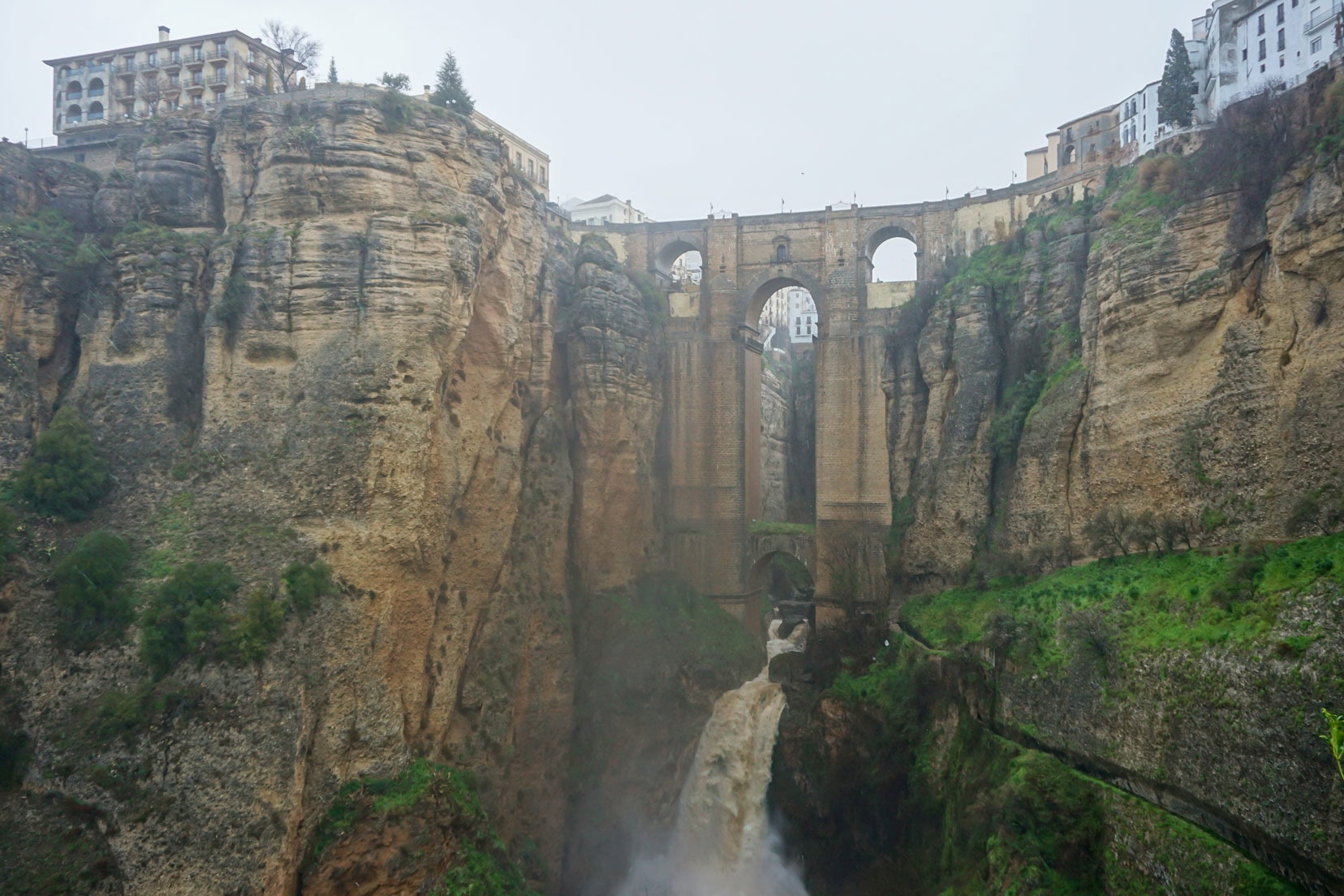
Plaza Des Toros De Ronda
This plaza in Ronda is home to the oldest bullfighting ring in Spain, conveniently located near Alameda del Tajo Park.
Ronda is reputed to be the birthplace of bullfighting, gaining fame from the enthusiasts of its bullring, including notable figures like Ernest Hemingway and Orson Welles.
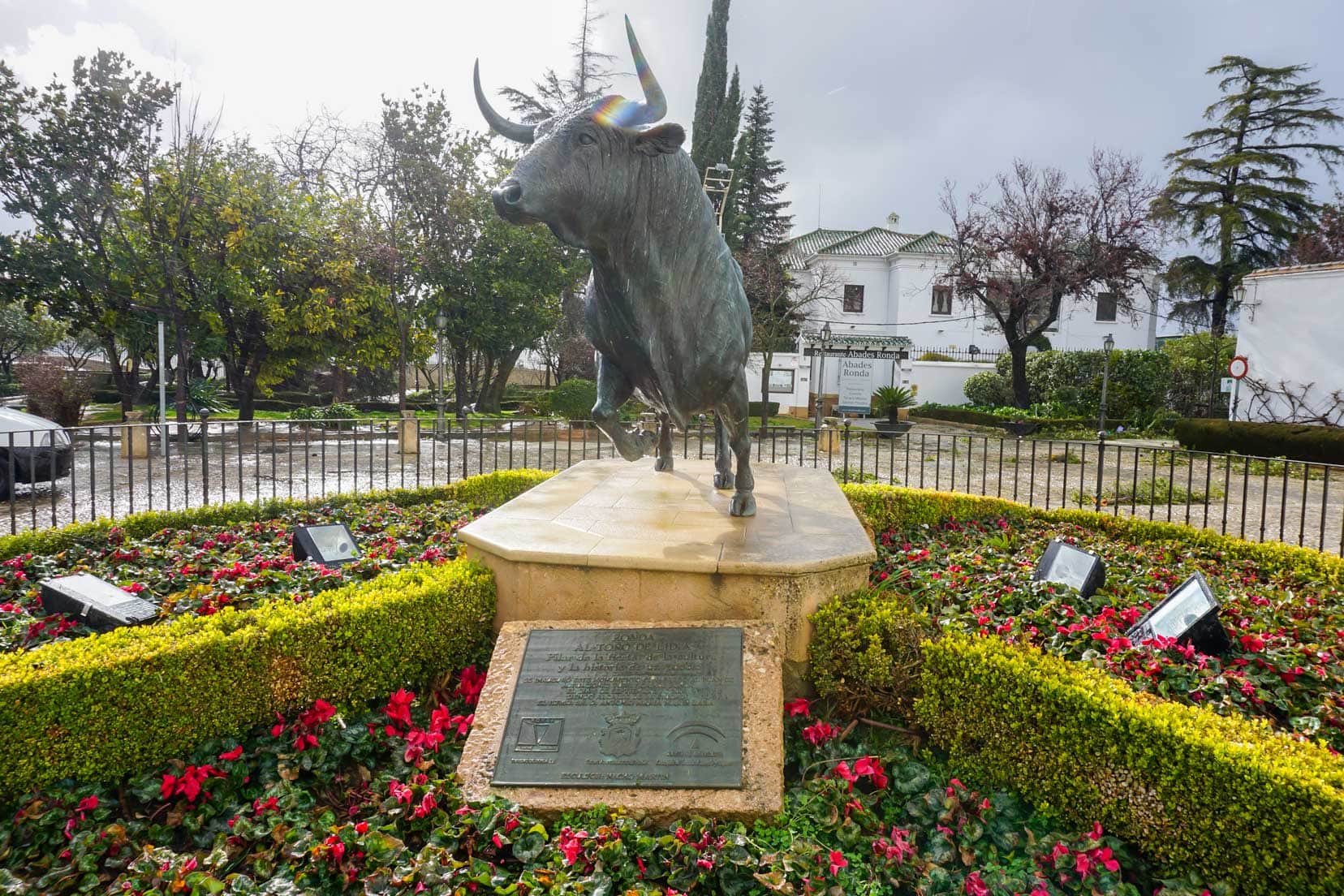
Ronda Accommodation and Motorhome Campsite
- Campervan Campsite: Ronda – Ciudad de Ronda
- Hotels and B&Bs: Ronda area on Booking.com
11. Seville
🚐 Motorhome Campsite: Seville – Area Sosta Camper Sevilla
📏 Distance: Ronda to Seville = 130 km
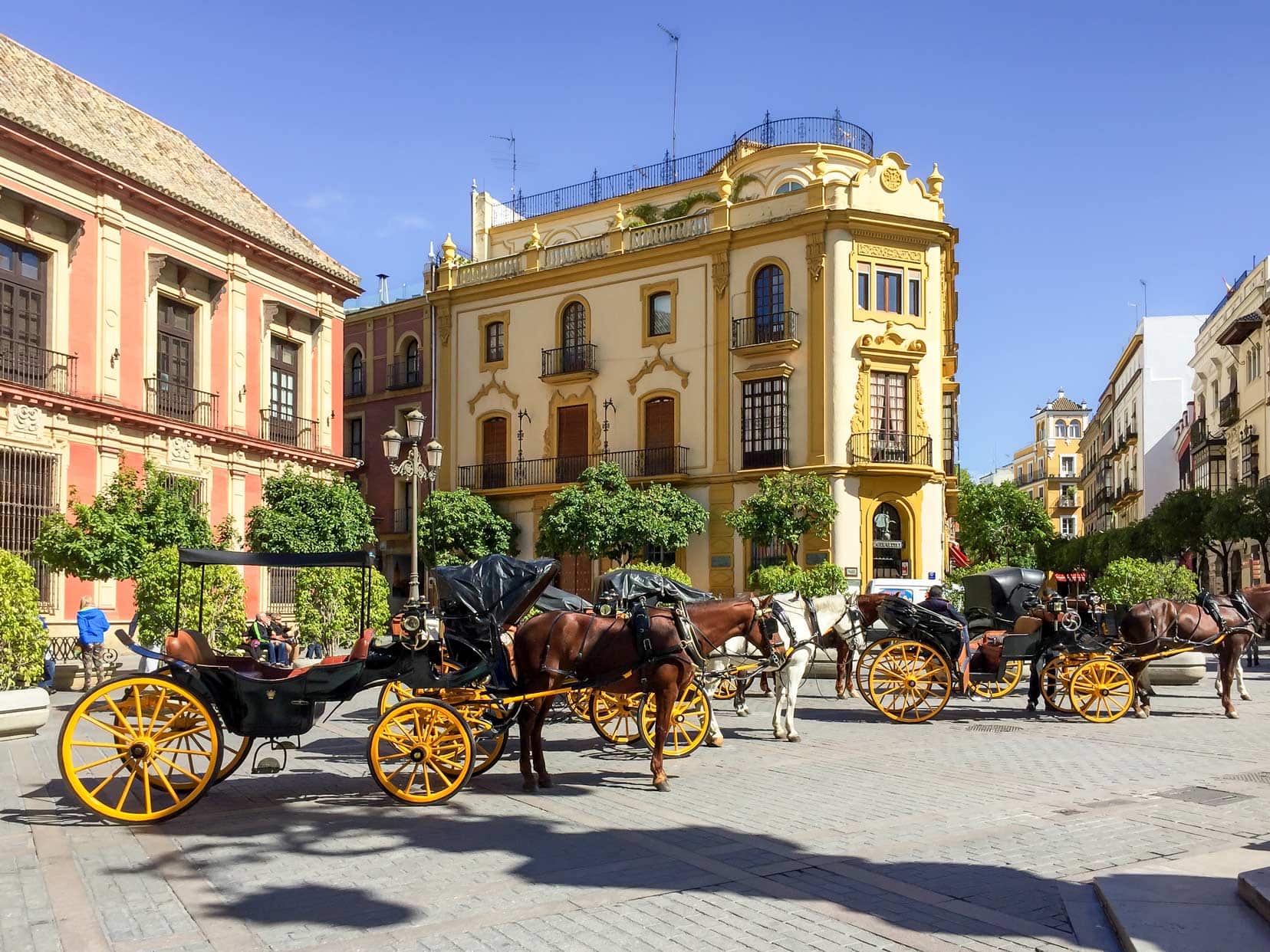
Seville is one of the rare cities in the world that can be experienced through its distinctive scents as vividly as through any other sense.
Orange trees adorn the streets, infusing Seville with their pleasant aroma. The fallen oranges gave the drab pavement a distinctive splash of colour.
Seville was our favourite city on our motorhome trip through southern Spain. Let me show you why.
Cathedral Of Santa Maria De La Sede De Sevilla
Here in Seville, you will find the largest Christian Gothic cathedral in the world. It houses the remains of several kings and the intrepid traveller of his time, Christopher Columbus.
Built over the site of a demolished mosque, it was completed in 1504 however, a minaret still stands.

Plaza De Toros De La Real Maestranza De Caballeria De Sevilla
This bullfighting arena was built in the 17th century and took nearly 100 years to reach completion. It has been called one of the most beautiful and elegant in Spain. We agree.
🎟️ Grab your skip-the-line-ticket for this 4.6 out of 5 rated guided tour of the museum and the arena stands, which is super interesting. We aren’t advocates of bullfighting but it was great to learn the history.
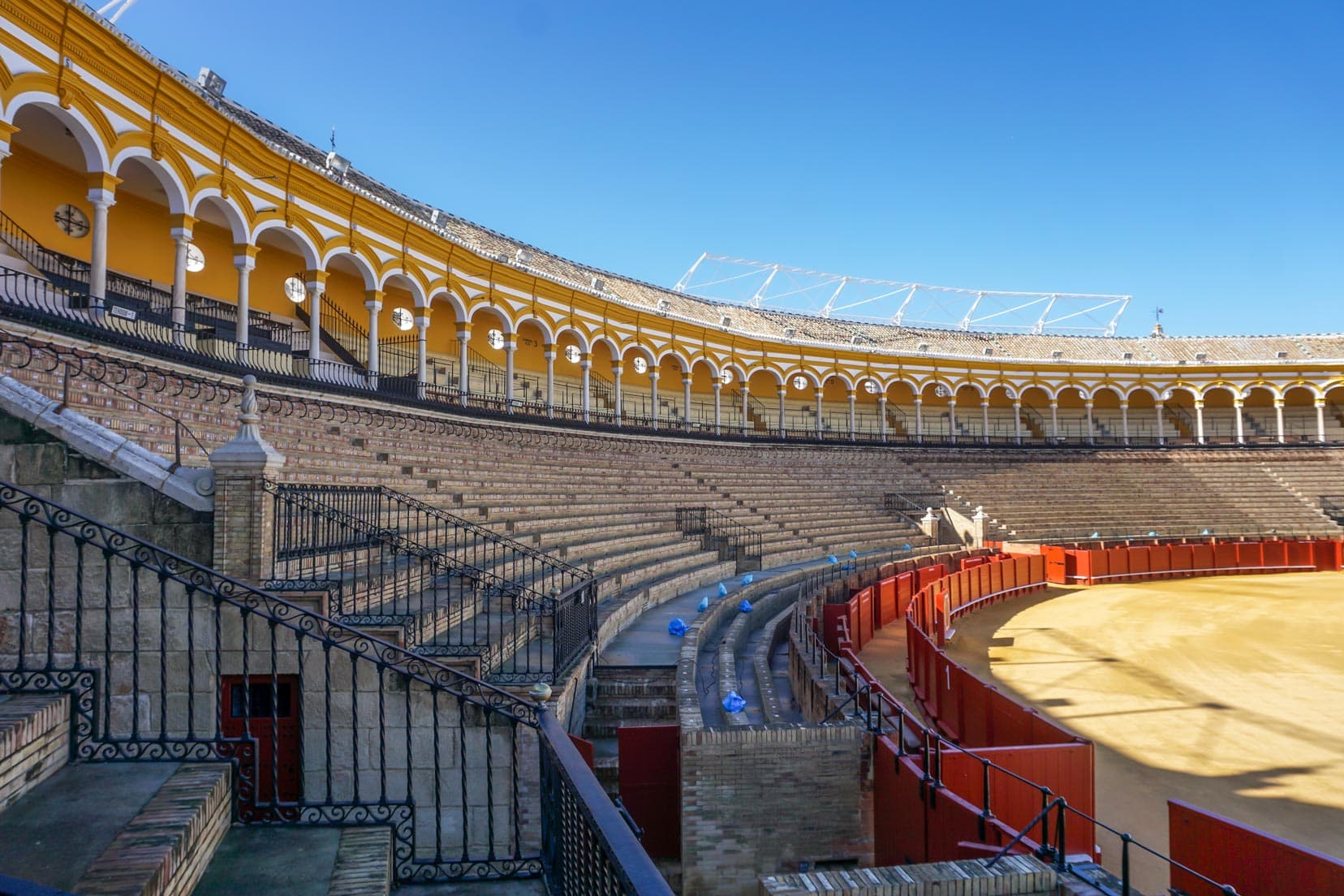
Maria Luisa Park
Originally part of the Palace Royal Gardens, this beautiful urban park has fountains, ponds, monuments, and numerous bird species. It is Seville’s main public park and stretches along the Guadalquivir River. Unfortunately, during our Seville visit, a recent storm damaged the park, temporarily closing it.
Royal Tobacco Company
This building features an exquisite external façade and now serves as the main building for the University of Seville, but it has a more colourful past. During the 18th century, snuff (pulverised tobacco leaves producing inhaled powder) was produced here, and tobacco auctions were held.
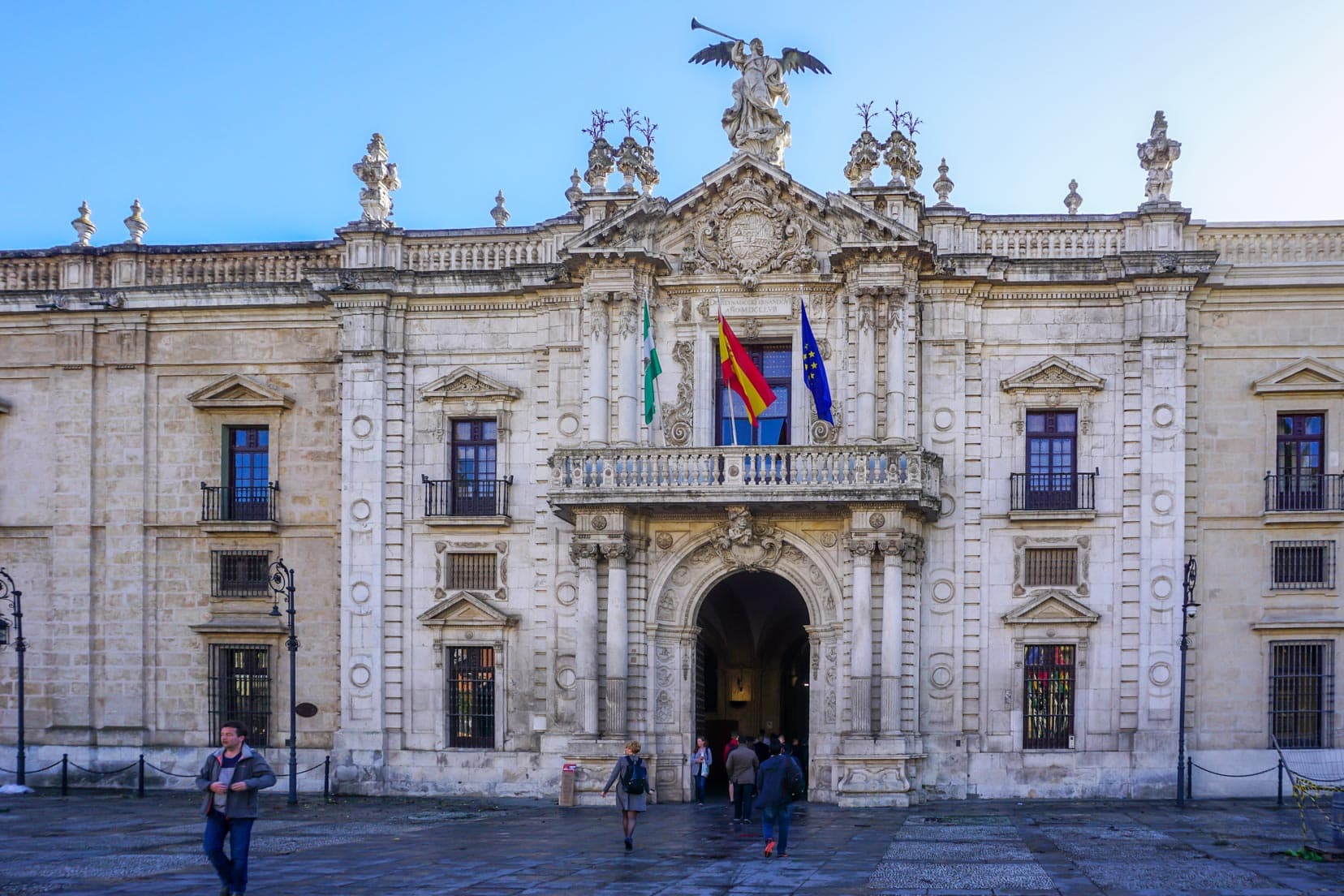
We were only in Seville for a day, but if you have longer, you may like to check out this 3-day Seville Itinerary.
Seville Accommodation and Motorhome Campsite
- Campervan Campsite: Seville – Area Sosta Camper Sevilla
- Hotels and B&Bs: Seville(Sevilla) area on Booking.com
12. Cordoba
🚐 Motorhome Campsite: Cordoba Campersite
📏 Distance: Seville to Cordoba = 140 km
Our final stop on our Southern Spain road trip was Cordoba. Bright blue flower pots decorate charming laneways, enticing you to wander further into the heart of the old town of Cordoba.
Surrounded by beauty, history and culture, this city allows you to discover it at your own pace.
Mazquita-Catedral De Cordoba
The talk of the town is the Mezquita. Having been both a mosque and a church, the Cathedral of Cordoba represents a beautiful mix of cultures. It is an absolute marvel with 856 columns and its characteristic arches of alternating red and white colours.
Hundreds of small oil lights hang from the ceiling and cast light on over 30 individual chapels.
It’s an impressive building.
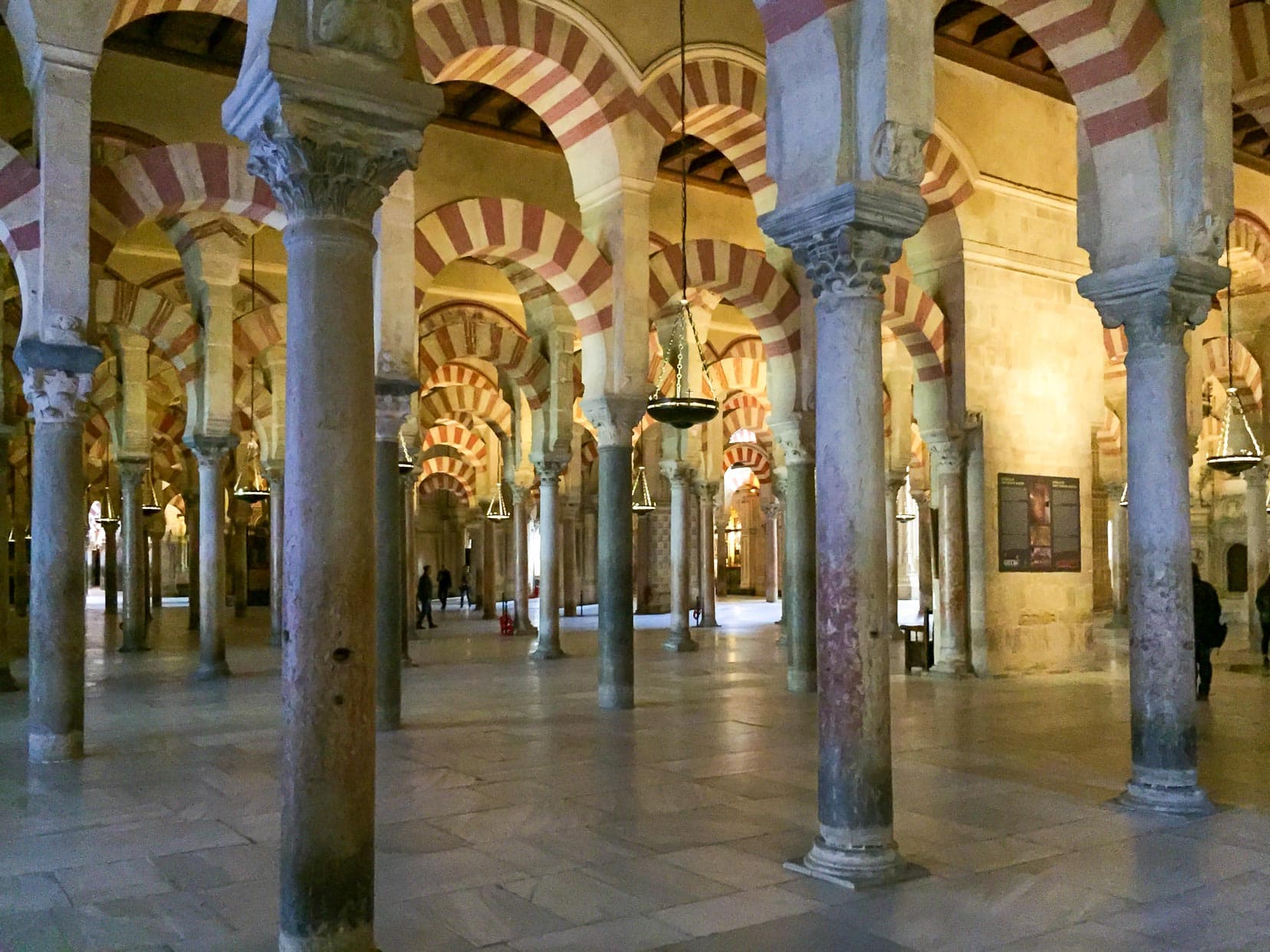
Calleja De Las Flores
This pretty, flower-lined lane is close to the Cathedral-Mosque of Cordoba. It’s a popular spot with flowers in bloom regardless of the season.
You can find the Taberna Los Geranios on the street, Velazquez Bosco.
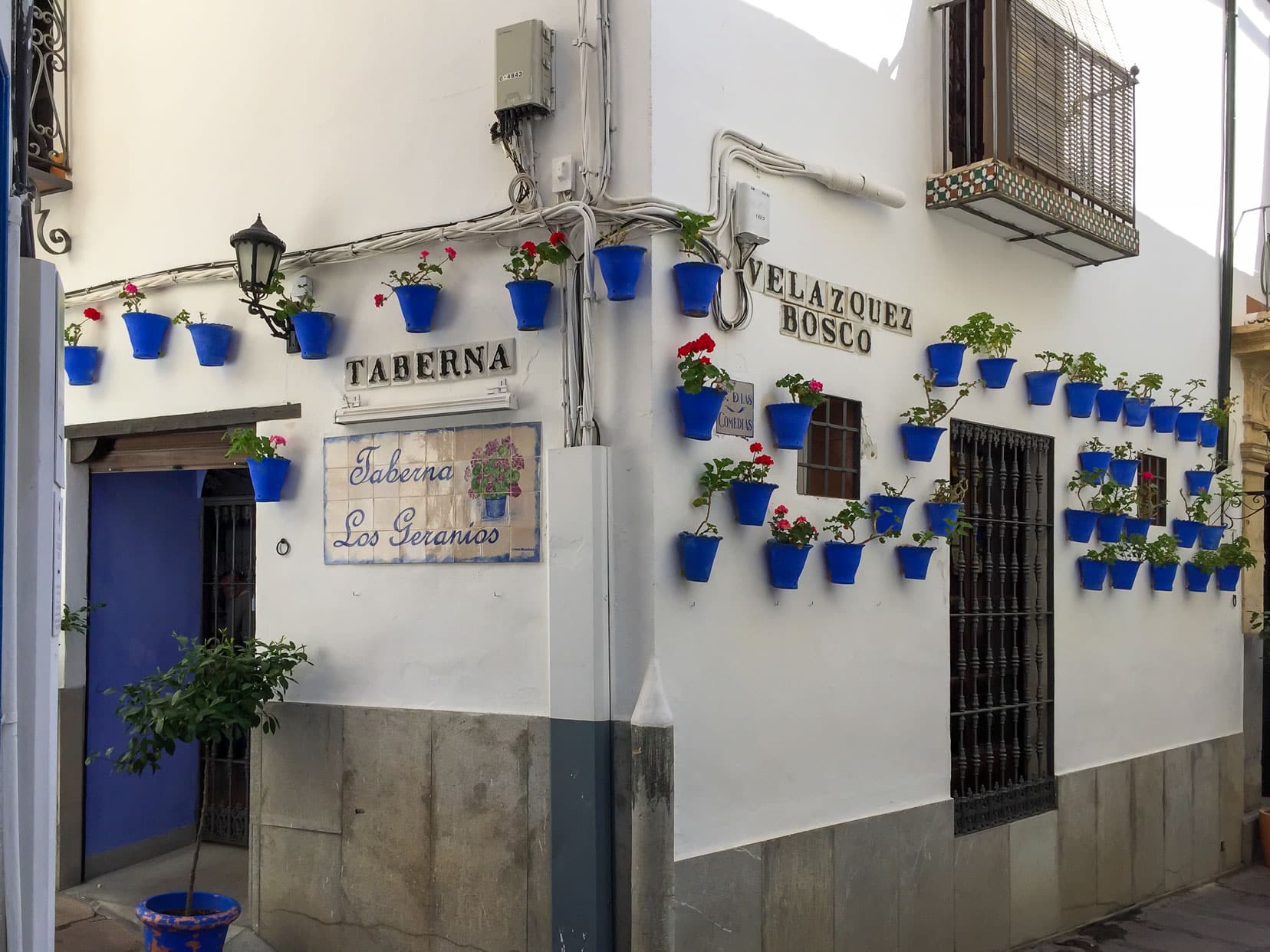
Alcazar De Los Reyes Cristianos
In the historic part of the town is the Alcázar fortress, Alcazar de los Reyes Cristianos. It once housed Spanish royalty and was headquarters to the Spanish Inquisition tribunals for over three centuries.
The fortress boasts beautiful gardens and courtyards; the grounds were charming even at winter’s end. Our timing for a winter visit meant it was not crowded with tourists.
🎟️ You can read more about jump-the-queue tickets Alcazar De Los Reyes Cristianos here.
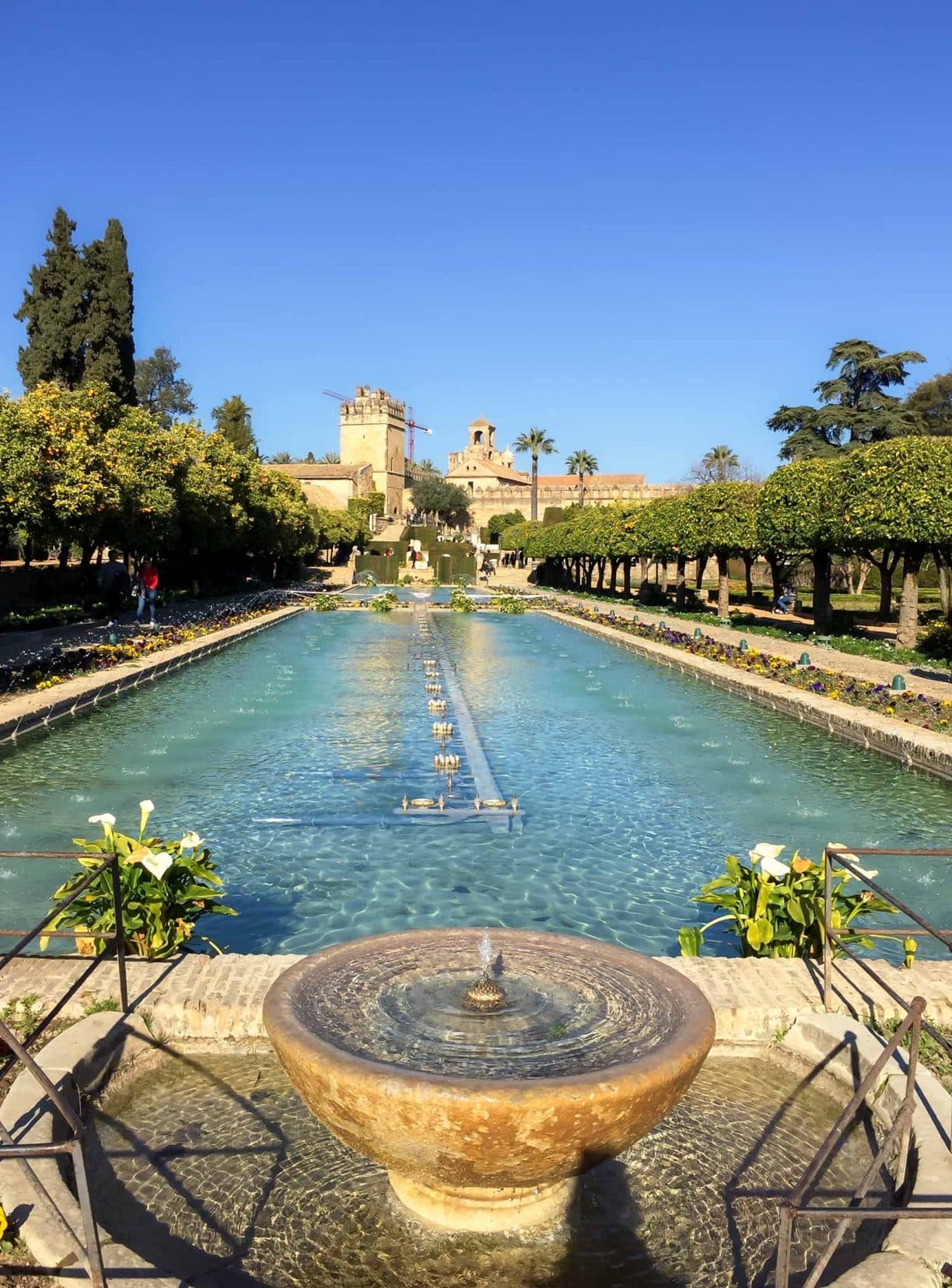
Cordoba’s Roman Bridge
Originally built in the 1st century BC, this impressive Roman Bridge only has two original arches out of its total sixteen arches.
It only takes a few minutes to walk across this 250-meter-long bridge, and once on the opposite side, you get a fabulous view of the bridge with Cordoba’s old town as its backdrop.
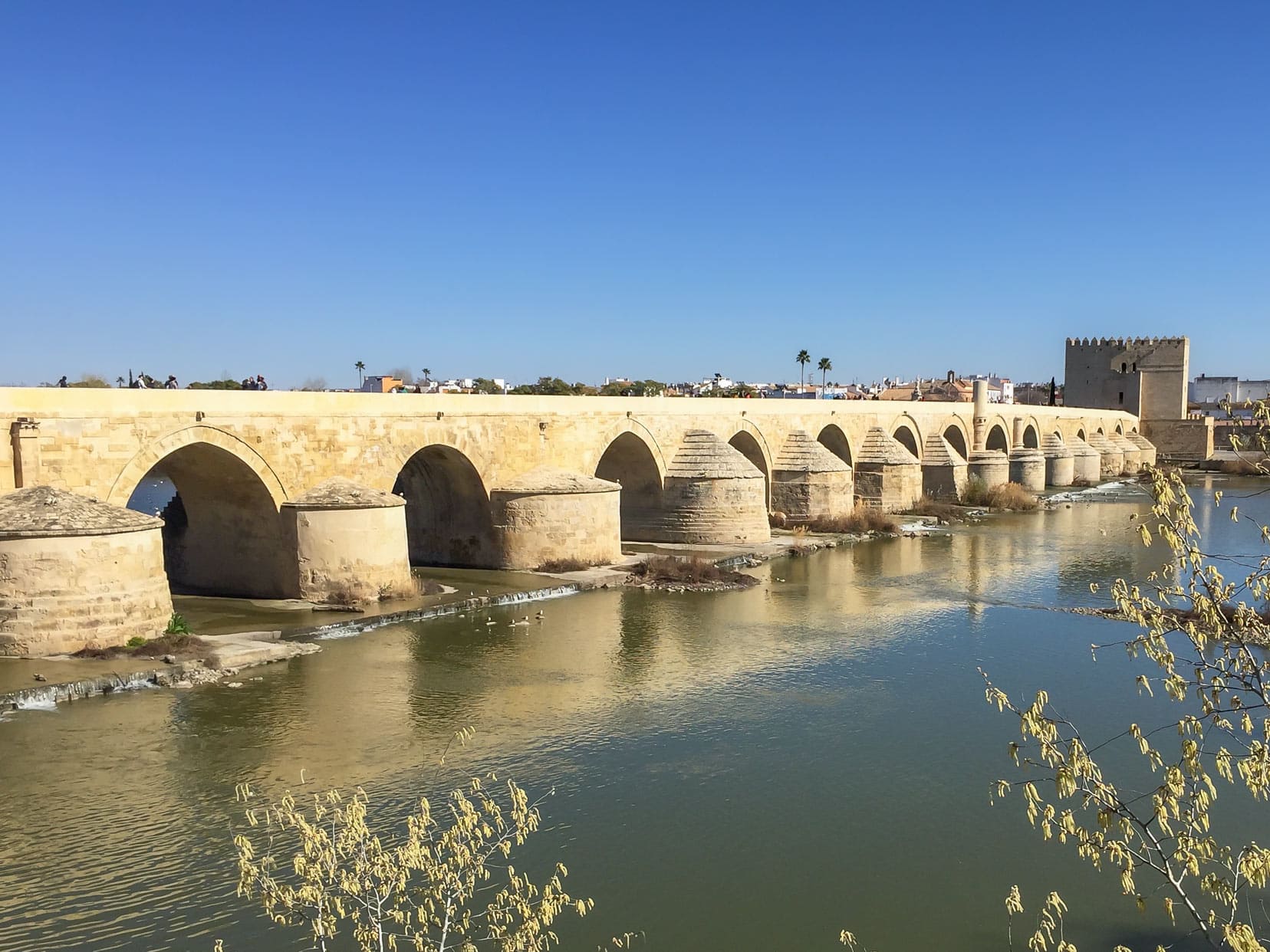
Plaza De La Corredera
This plaza is a 17th-century historical site, once used for bullfights and Inquisition burnings. Yes, it has a special history.
It has a happier vibe today, with inviting cafes and restaurants here to enjoy.
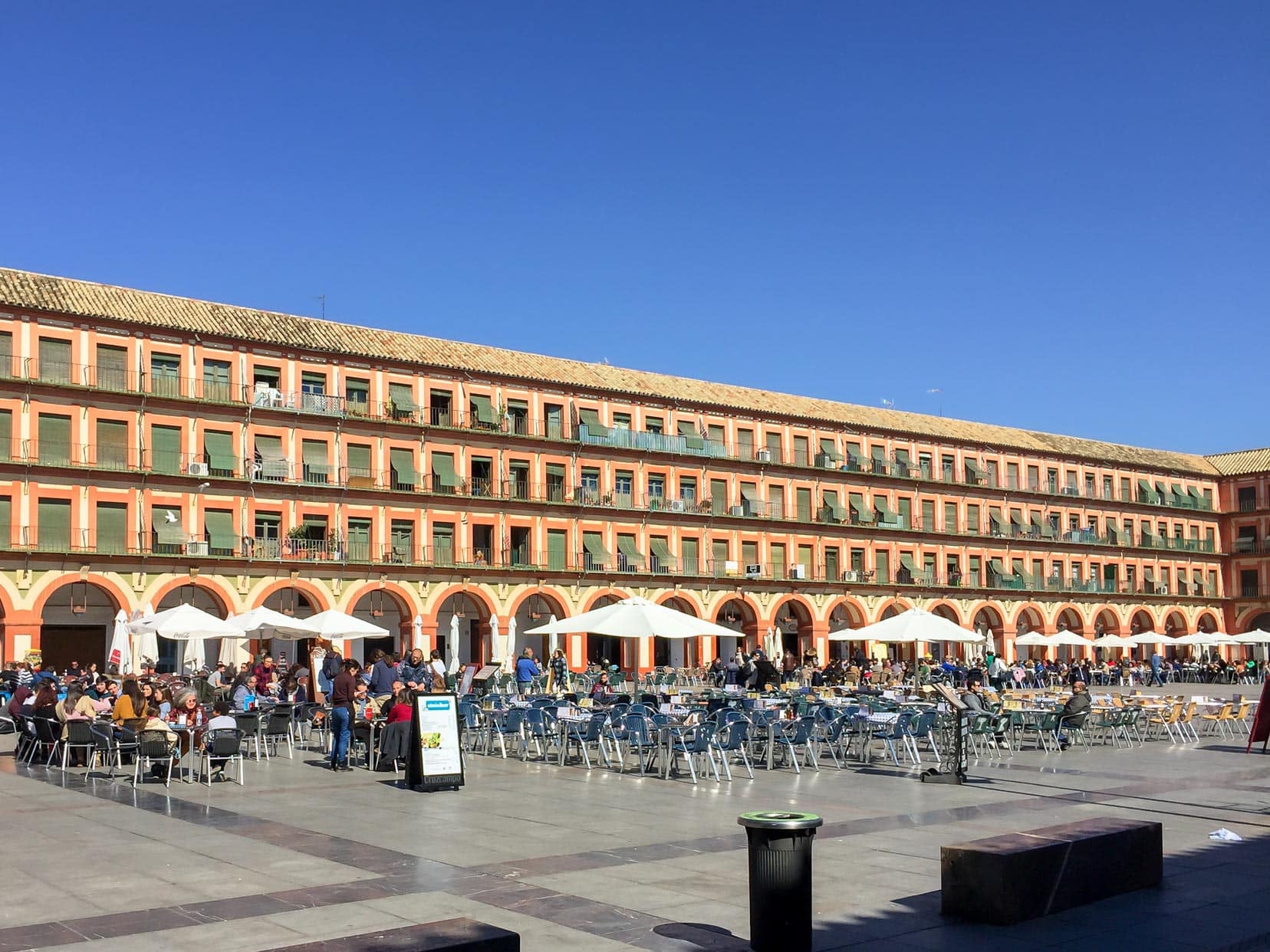
Cordoba Accommodation and Motorhome Campsite
- Campervan Campsite: Cordoba Campersite
- Hotels and B&Bs: Cordoba area on Booking.com
Tips For Driving in Spain
For practical information about driving in Spain, consider the following tips:
- Drive on the Right: In Spain, driving is on the right-hand side of the road.
- Seatbelts are Mandatory: Ensure everyone in the vehicle wears a seatbelt.
- Essential Documents: Always have these documents ready:
- Driver’s licence (an international driving licence isn’t necessary if you have an EU Member State licence)
- Vehicle insurance
- Vehicle registration document
- Passport
- Required Vehicle Equipment:
- Reflective Vest: Recommended for safety; fines may apply if not worn during roadside emergencies.
- Warning Triangle: Necessary for use in accidents or breakdowns to alert other drivers. Alternatively, a V-16 emergency beacon will be required by law from 2026.
- Headlamp beam deflectors
- GB sticker or Euro plates
- Speed Limits: Observe the following speed limits unless otherwise signposted:
- 120 km/h on motorways (autovias) and dual carriageways
- 100 km/h on roads with more than one lane per direction
- 90 km/h on other roads
- 50 km/h in urban areas
- 20 km/h in specially marked residential zones
- Tolls: Tolls can be paid with cash or credit cards. Toll roads are denoted by the letters ‘AP’, while toll-free motorways have the letter ‘A’. You can find rates and payment options on Autopistas.com.
- Emergency Services: Dial 112 for police, fire brigade, and ambulance services.
Driving in Spain can sometimes be challenging due to erratic drivers. If you’re travelling with a partner or friends, tension might rise as you navigate unfamiliar territories.
We’ve shared a humorous account of how we dealt with such challenges during a worldwide road trip, which you might find amusing.
>> You can read about our adventures, in which we morph into Lady Penelope and Parker from the Thunderbirds, in our article: best tips for travelling as a couple.
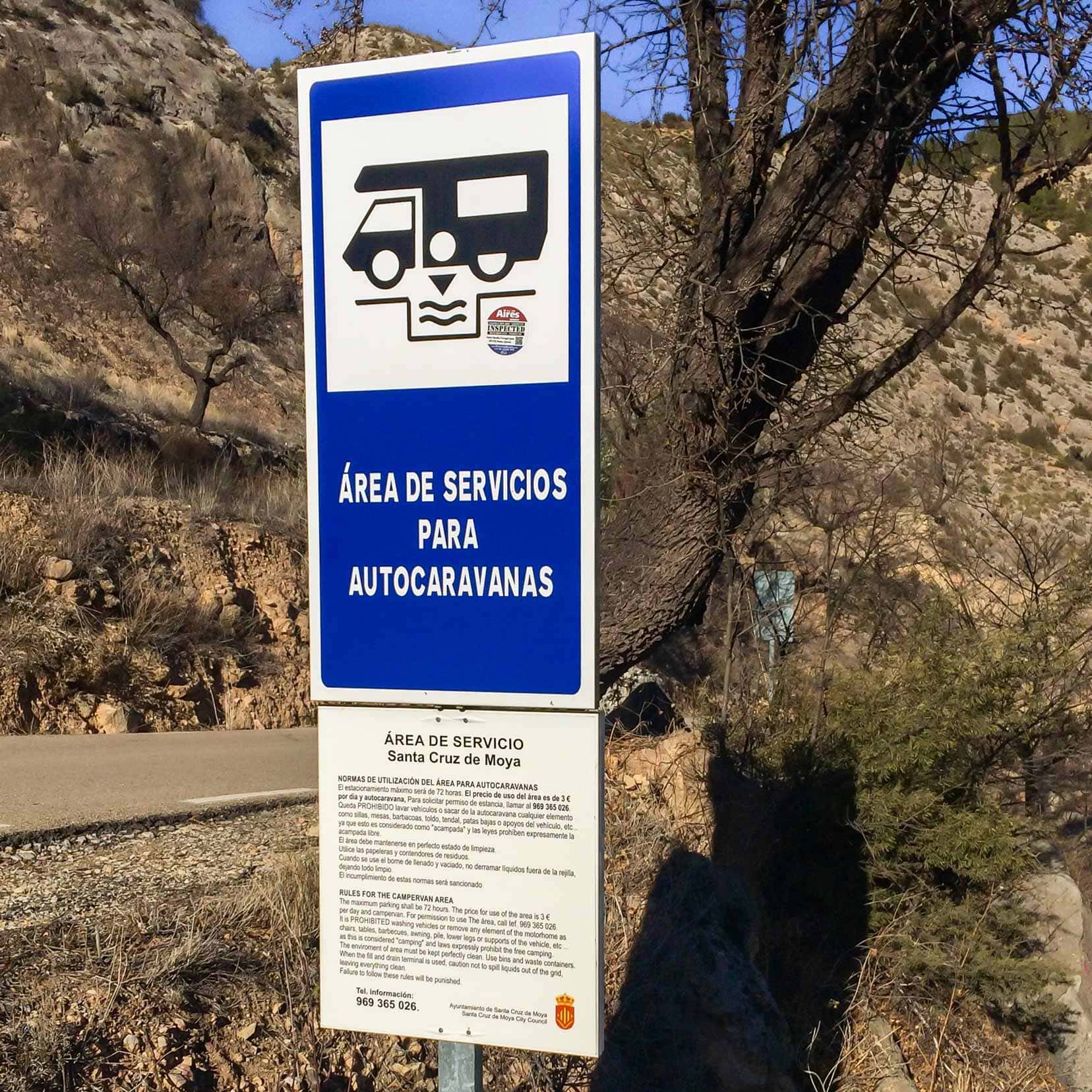
Best Time for a Spain Motorhome Trip?
It’s useful to remember that we motorhomed through Spain during the winter months. As you can see from the photos, we had mainly sunny days, but we still needed winter clothes and layered our clothing most days.
Some seasons may appeal more than others:
- Spring (March to May): This is one of the best times for motorhoming in Spain. The weather is mild, and the countryside is vibrant with flowers. It’s also less crowded than summer, making it ideal for visiting popular tourist spots.
- Autumn (September to November): Like spring, autumn offers mild weather and fewer tourists. The landscape is coloured with autumn hues, and it’s a great time for visiting both the northern and southern parts of Spain.
- Summer (June to August): Summer can be a good option if you enjoy warm weather and don’t mind the crowds. It’s perfect for visiting coastal areas and enjoying Spain’s beaches. However, it can get very hot, especially in the south, which might not be comfortable for everyone.
- Winter (December to February): Winter is ideal if you prefer cooler weather and want to avoid crowds. It’s also a great time for visiting southern Spain, where temperatures are milder compared to the north. Plus, you can explore winter sports in the northern mountains.
Overall, spring and autumn strike a nice balance between good weather and avoiding the peak tourist seasons, making them ideal for a motorhome trip.
✋ As a reminder, book accommodation or campsites beforehand, as Spain is a popular destination in any season.
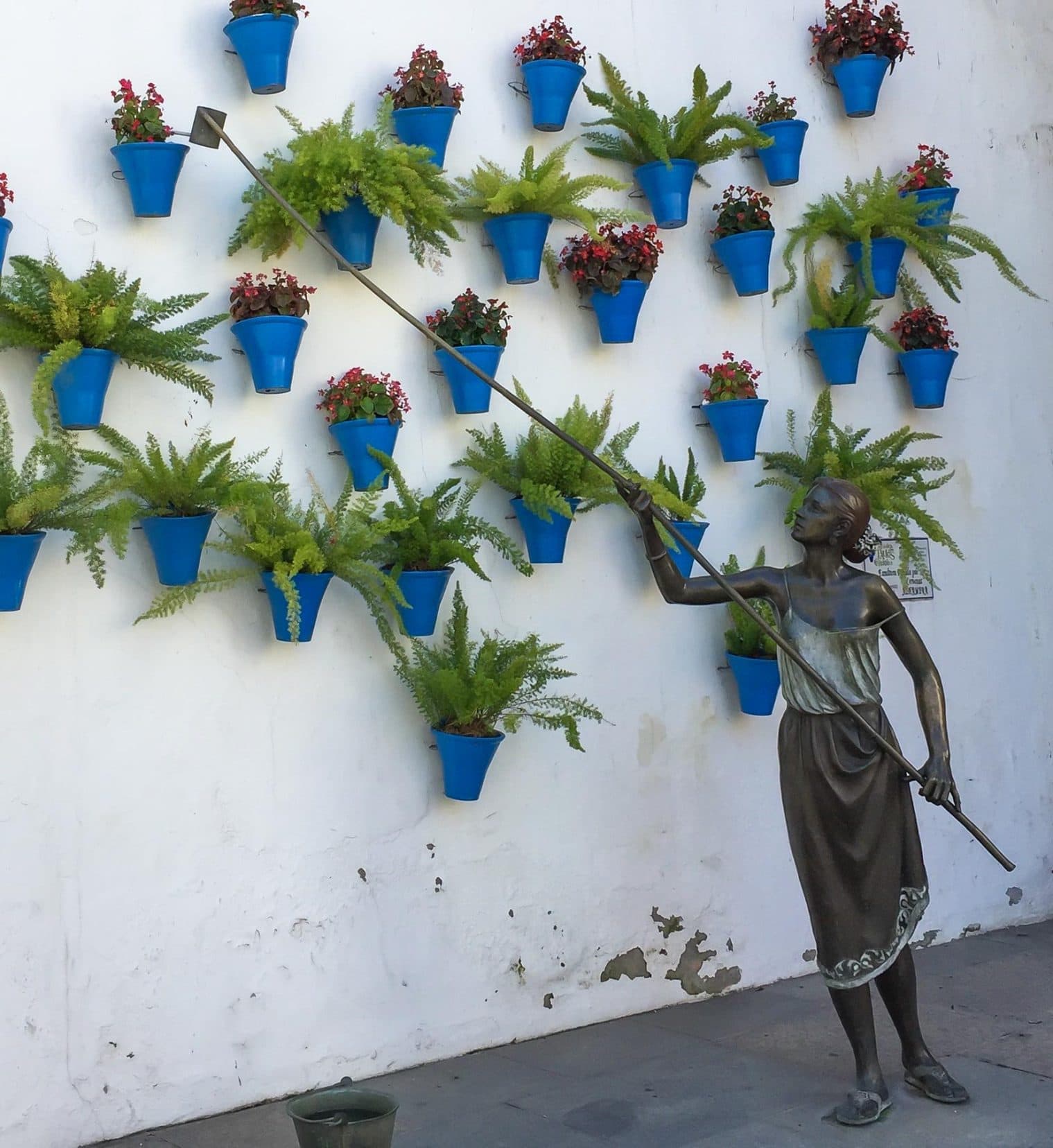
Motorhoming in Spain … That’s a Wrap
Exploring Spain by motorhome offers a unique perspective on this vibrant country. From the architectural marvels in Barcelona to the enchanting streets of Seville, each destination provides a chapter of its own in the grand story of Spain.
Whether seeking serene landscapes or bustling cityscapes, Spain offers a road trip experience that caters to all tastes. Safe travels; a wonderful adventure lies ahead.
Have you visited Spain before? Do you have any favourite spots? We’d love to hear about your travels with a comment below.
Pin and Save for Later
READ MORE:
- Roadtripping Around the World
- Portugal: Campervanning in Portugal: Your Ultimate Guide
- Morocco: Marrakech Tips and Great Places to See
Planning Your Travels?
These are the travel resources we recommend and use when planning our trips.
- 🚘 Car Hire: We use DiscoverCars.com
- Motorhome/Campervan Rental: We highly recommend the Motorhome Republic
- 🪪 Order your International Driver’s Licence online here
- 🛏 Book Accommodation: We use Booking.com to find accommodation that suits our budget
- 🐶 Pet Sitting/Pet Sitters: Check Out TrustedHousesitters here (Use our Discount code: LIFEJOURNEY25 for 25% off. )
- Activities and Experiences: Get Your Guide and Viator
- Travel Insurance: Safetywing or World Nomads
- 🥾 Travel Gear and Accessories: Check out our top picks here — Lifejourney4two page on Amazon
For a more thorough list, visit our Travel Resources page here.



